Disclaimer
Vincent van Gogh
Dutch Post-Impressionist Painter
1853 - 1890
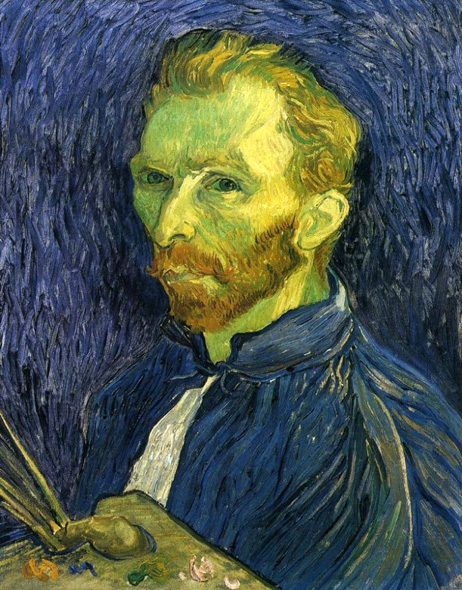
Self-Portrait with Pallette: 1889
Vincent Willem van Gogh was a Dutch Post-Impressionist painter whose work, notable for its rough beauty, emotional honesty and bold color, had a far-reaching influence on 20th-century art. After years of painful anxiety and frequent bouts of mental illness, he died aged 37 from a gunshot wound, generally accepted to be self-inflicted (although no gun was ever found). His work was then known to only a handful of people and appreciated by fewer still.
Van Gogh began to draw as a child, and he continued to draw throughout the years that led up to his decision to become an artist. He did not begin painting until his late twenties, completing many of his best-known works during the last two years of his life. In just over a decade, he produced more than 2,100 artworks, consisting of 860 oil paintings and more than 1,300 watercolors, drawings, sketches and prints. His work included self-portraits, landscapes, still lifes, portraits and paintings of cypresses, wheat fields and sunflowers.
Van Gogh spent his early adulthood working for a firm of art dealers, traveling between The Hague, London and Paris, after which he taught for a time in England. One of his early aspirations was to become a pastor and from 1879 he worked as a missionary in a mining region in Belgium where he began to sketch people from the local community. In 1885, he painted his first major work The Potato Eaters. His palette at the time consisted mainly of somber earth tones and showed no sign of the vivid coloration that distinguished his later work. In March 1886, he moved to Paris and discovered the French Impressionists. Later, he moved to the south of France and was influenced by the strong sunlight he found there. His work grew brighter in color, and he developed the unique and highly recognizable style that became fully realized during his stay in Arles in 1888.
The Potato Eaters
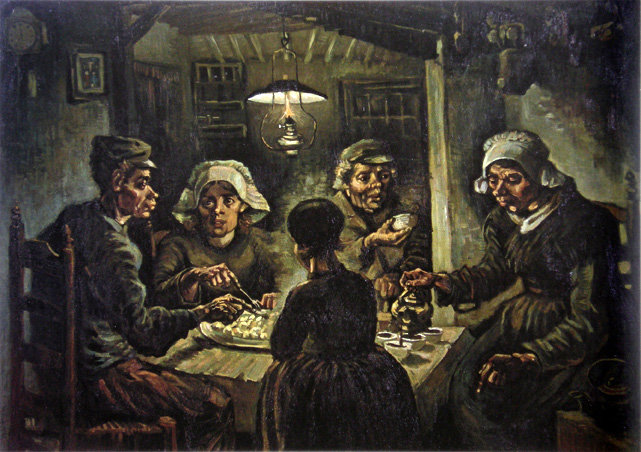
Van Gogh deliberately chose a composition which would challenge his growing prowess as a painter. And like the French master Jean-François Millet, Van Gogh wanted to be a true "peasant painter."
This meant Van Gogh tried to paint his subjects with deep feeling, but without sentimentality. He spoke of them leading 'a way of life completely different from ours, from that of civilized people.' He strove to paint the faces, 'the color of a good, dusty potato, unpeeled naturally,' and to convey the idea that these people had 'used the same hands with which they now take food from the plate to dig the earth […] and had thus earned their meal honestly.'
The extent to which his mental health affected his painting has been a subject of speculation since his death. Despite a widespread tendency to romanticize his ill health, modern critics see an artist deeply frustrated by the inactivity and incoherence brought about by his bouts of illness. According to art critic Robert Hughes, van Gogh's late works show an artist at the height of his ability, completely in control and "longing for concision and grace".
The most comprehensive primary source for the understanding of van Gogh as an artist is the collection of letters between him and his younger brother, art dealer Theo van Gogh. They lay the foundation for most of what is known about the thoughts and beliefs of the artist. Theo provided his brother with both financial and emotional support. Their lifelong friendship, and most of what is known of van Gogh's thoughts and theories of art, is recorded in the hundreds of letters they exchanged between 1872 and 1890: more than 600 from Vincent to Theo and 40 from Theo to Vincent.
Theo van Gogh
.png) This 1887 portrait by Vincent van Gogh, long thought to be a self-portrait,
This 1887 portrait by Vincent van Gogh, long thought to be a self-portrait,
was reassessed in 2011 to be one of his brother Theo van Gogh.
.jpg)
Although many are undated, art historians have generally been able to put them in chronological order. Problems remain, mainly in dating those from Arles, although it is known that during that period, van Gogh wrote 200 letters to friends in Dutch, French and English. The period when Vincent lived in Paris is the most difficult for historians to analyze because the brothers lived together and had no need to correspond.
In addition to letters to and from Theo, other surviving documents include those to Van Rappard, Émile Bernard, van Gogh's sister Wil and her friend Line Kruysse. The letters were first annotated in 1913 by Theo's widow Johanna van Gogh-Bonger who explained that she published them with 'trepidation' because she did not want the drama in the artist's life to overshadow his work. Van Gogh himself was an avid reader of other artists' biographies and expected their lives to be in keeping with the character of their art.
Early Life
Vincent Willem van Gogh was born on 30 March 1853 in Groot-Zundert, a village close to Breda in the province of North Brabant in the south of the Netherlands, a predominantly Catholic area. He was the oldest child of Theodorus van Gogh, a minister of the Dutch Reformed Church, and Anna Cornelia Carbentus. Vincent was given the name of his grandfather and of a brother stillborn exactly a year before his birth. The practice of reusing a name was not unusual. Vincent was a common name in the Van Gogh family: his grandfather, Vincent (1789-1874), had received his degree of theology at the University of Leiden in 1811. Grandfather Vincent had six sons, three of whom became art dealers, including another Vincent who was referred to in van Gogh's letters as "Uncle Cent". Grandfather Vincent had perhaps been named in turn after his own father's uncle, the successful sculptor Vincent van Gogh (1729-1802). Art and religion were the two occupations to which the Van Gogh family gravitated. His brother Theodorus "Theo" was born on 1 May 1857. He had another brother, Cor, and three sisters: Elisabeth, Anna and Willemina "Wil".
As a child, Vincent was serious, silent and thoughtful. He attended the Zundert village school from 1860, where the single Catholic teacher taught around 200 pupils. From 1861, he and his sister Anna were taught at home by a governess, until 1 October 1864, when he went to Jan Provily's boarding school at Zevenbergen about 20 miles (32 km) away. He was distressed to leave his family home as he recalled later as an adult. On 15 September 1866, he went to the new middle school, Willem II College in Tilburg. Constantijn C. Huysmans, a successful artist in Paris, taught van Gogh to draw at the school and advocated a systematic approach to the subject. Vincent's interest in art began at an early age. He began to draw as a child and continued making drawings throughout the years leading to his decision to become an artist. Though well-done and expressive, his early drawings do not approach the intensity he developed in his later work. In March 1868, van Gogh abruptly left school and returned home. A later comment on his early years was in an 1883 letter to Theo in which he wrote, "My youth was gloomy and cold and sterile".
In July 1869, his uncle Cent helped him obtain a position with the art dealer Goupil and Cie in The Hague. After his training, in June 1873, Goupil transferred him to London, where he lodged at 87 Hackford Road, Brixton, and worked at Messrs. Goupil and Co., 17 Southampton Street. This was a happy time for Vincent; he was successful at work and was, at 20, earning more than his father. Theo's wife later remarked that this was the happiest year of Vincent's life. He fell in love with his landlady's daughter, Eugénie Loyer, but when he finally confessed his feelings to her, she rejected him, saying that she was secretly engaged to a former lodger. He became increasingly isolated and fervent about religion; his father and uncle arranged for him to be transferred to Paris, where he became resentful at how art was treated as a commodity, a fact apparent to customers. On 1 April 1876, Goupil terminated his employment.
Van Gogh returned to England for unpaid work as a supply teacher in a small boarding school overlooking the harbor in Ramsgate, where he made sketches of the view. When the proprietor of the school relocated to Isleworth, Middlesex, van Gogh moved with him, taking the train to Richmond and the remainder of the journey on foot. The arrangement did not work out and he left to become a Methodist minister's assistant, following his wish to "preach the gospel everywhere." At Christmas, he returned home and found work in a bookshop in Dordrecht for six months. He was not happy in this new position and spent much of his time either doodling or translating passages from the Bible into English, French and German. His roommate at the time, a young teacher named Görlitz, recalled that van Gogh ate frugally, and preferred not to eat meat.
Van Gogh's religious zeal grew until he felt he had found his true vocation. To support his effort to become a pastor, his family sent him to Amsterdam to study theology in May 1877, where he stayed with his Uncle Jan van Gogh, a naval Vice Admiral. Vincent prepared for the entrance exam with his uncle Johannes Stricker; a respected theologian who published the first "Life of Jesus" in the Netherlands. Van Gogh failed the exam, and left his Uncle Jan's house in July 1878. He then undertook, but failed, a three-month course at the Vlaamsche Opleidingsschool, a Protestant missionary school in Laeken, near Brussels.
In January 1879, he took a temporary post as a missionary in the village of Petit Wasmes in the coal-mining district of Borinage in Belgium. Taking Christianity to what he saw as its logical conclusion, van Gogh lived like those he preached to, sleeping on straw in a small hut at the back of the baker's house where he was staying. The baker's wife reported hearing van Gogh sobbing at night in the hut. His choice of squalid living conditions did not endear him to the appalled church authorities, who dismissed him for "undermining the dignity of the priesthood." He then walked to Brussels, returned briefly to the village of Cuesmes in the Borinage, but gave in to pressure from his parents to return home to Etten. He stayed there until around March the following year, a cause of increasing concern and frustration for his parents. There was particular conflict between Vincent and his father; Theodorus made inquiries about having his son committed to the lunatic asylum at Geel.
He returned to Cuesmes where he lodged until October with a miner named Charles Decrucq. Increasingly interested in the people and scenes around him, van Gogh recorded his time there in his drawings and followed Theo's suggestion that he should take up art in earnest. He traveled to Brussels that autumn intending to follow Theo's recommendation to study with the prominent Dutch artist Willem Roelofs, who persuaded him, in spite of his aversion to formal schools of art, to attend the Académie Royale des Beaux-Arts in Brussels, where he registered on 15 November 1880. At the Académie, he studied anatomy and the standard rules of modeling and perspective, about which he said, "...you have to know just to be able to draw the least thing." Van Gogh aspired to become an artist in God's service, stating: "...to try to understand the real significance of what the great artists, the serious masters, tell us in their masterpieces, that leads to God; one man wrote or told it in a book; another in a picture."
In April 1881, van Gogh moved to the Etten countryside with his parents where he continued drawing, often using neighbors as subjects. Through the summer he spent time walking and talking with his recently widowed cousin, Kee Vos-Stricker, the daughter of his mother's older sister and Johannes Stricker, with whom he stayed in Amsterdam in 1878. Kee, who had an eight-year-old son, was seven years older than van Gogh. He proposed marriage, but she refused with the words, "No, nay, never," ("nooit, neen, nimmer"). Late that November, van Gogh wrote a strongly worded letter to Johannes, and then hurried to Amsterdam where he spoke with him on several occasions. Kee refused to see him, and her parents wrote, "Your persistence is disgusting." In desperation, he held his left hand in the flame of a lamp, with the words "Let me see her for as long as I can keep my hand in the flame." He did not recall the event well, but later assumed that his uncle blew out the flame. Kee's father made it clear to him that Kee's refusal should be heeded and that the two would not be married because of van Gogh's inability to support himself. Van Gogh's perception of his uncle and former tutor's hypocrisy affected him deeply and put an end to his religious faith forever. That Christmas he refused to go to church, quarreling violently with his father as a result and leading him to leave home the same day for The Hague.
In January 1882, he settled in The Hague where he called on his cousin-in-law, Anton Mauve (1838-88), who was a Dutch realist painter and a leading member of the Hague School. Mauve introduced him to painting in both oil and watercolor and lent him money to set up a studio but the two soon fell out, possibly over the issue of drawing from plaster casts. Mauve appears to have suddenly gone cold towards van Gogh and did not return a number of his letters. Van Gogh supposed that he had learned of his new domestic arrangement with an alcoholic prostitute, Clasina Maria "Sien" Hoornik (1850-1904), and her young daughter. He had met Sien towards the end of January when she had a five-year-old daughter and was pregnant. She had already borne two children who had died, although van Gogh was unaware of this. On 2 July, she gave birth to a baby boy, Willem. When van Gogh's father discovered the details of their relationship, he put considerable pressure on his son to abandon Sien and her children, although Vincent at first defied him.
Van Gogh's uncle Cornelis, an art dealer, commissioned 12 ink drawings of views of the city, which van Gogh completed soon after arriving in The Hague, along with a further seven drawings that May. In June, he spent three weeks in a hospital suffering from gonorrhea. During the summer he began to paint in oil. In autumn 1883, after a year together, he left Sien and the two children. He had thought of moving the family out of the city but in the end made the break. It is possible that lack of money pushed Sien back to prostitution; the home became less happy, and van Gogh may have felt family life was irreconcilable with his artistic development. When he left, Sien gave her daughter to her mother and baby Willem to her brother. She then moved to Delft, and later to Antwerp. Willem remembered being taken to visit his mother in Rotterdam at around the age of 12, where his uncle tried to persuade Sien to marry in order to legitimize the child. Willem remembered his mother saying, "But I know who the father is. He was an artist I lived with nearly 20 years ago in The Hague. His name was van Gogh." She then turned to Willem and said "You are called after him." While Willem believed himself van Gogh's son, the timing of his birth makes this unlikely. In 1904, Sien drowned herself in the River Scheldt. Van Gogh moved to the Dutch province of Drenthe, in the northern Netherlands. That December, driven by loneliness, he went to stay with his parents who had been posted to Nuenen, North Brabant.
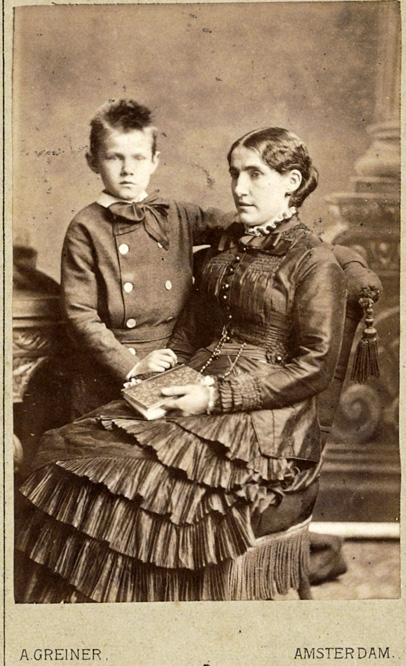
Kee Vos Stricker with her son Jan ca 1879/1880
In Nuenen, van Gogh devoted himself to drawing, and he gave money to boys to bring him birds' nests for subject matter for paintings, and he made many sketches and paintings of weavers in their cottages. In autumn 1884, Margot Begemann, a neighbor's daughter and ten years his senior, often joined him on his painting forays. She fell in love, and he reciprocated-though less enthusiastically. They decided to marry, but the idea was opposed by both families. As a result, Margot took an overdose of strychnine. She was saved when van Gogh rushed her to a nearby hospital. On 26 March 1885, his father died of a heart attack and he grieved deeply at the loss.
For the first time, there was interest from Paris in his work. That spring, he completed what is generally considered his first major work, The Potato Eaters, the culmination of several years' work painting peasant character studies. In August 1885, his work was exhibited for the first time, in the windows of a paint dealer, Leurs, in The Hague. When he was accused of forcing himself on one of his young peasant sitters Gordina de Groot who became pregnant that September the Catholic village priest forbade parishioners from modeling for him. During 1885, he painted several groups of still-life paintings.

Head of a Peasant woman with white hood (Gordina de Groot), 1885, Kröller-Müller Museum, Otterlo, Netherlands
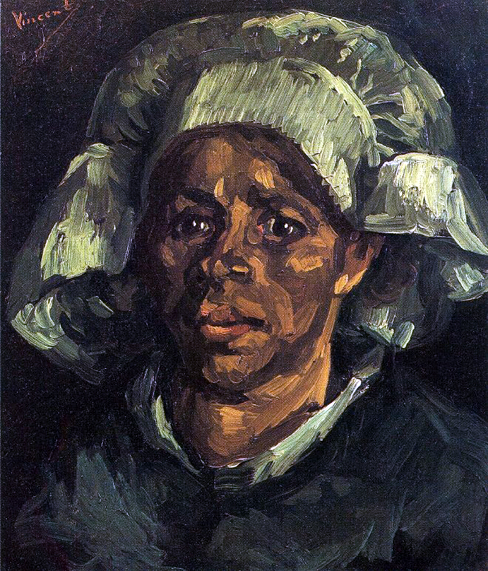
Peasant Woman, Portrait of Gordina de Groot: 1885

Peasant Woman, Portrait of Gordina de Groot: 1885
From this period, Still-Life with Straw Hat and Pipe and Still-life with Earthen Pot and Clogs are characterized by smooth, meticulous brushwork and fine shading of colors. During his two-year stay in Nuenen, he completed numerous drawings and watercolors and nearly 200 oil paintings. His palette consisted mainly of somber earth tones, particularly dark brown, and he showed no sign of developing the vivid coloration that distinguishes his later, best-known work. When he complained that Theo was not making enough effort to sell his paintings in Paris, his brother wrote back, telling him that the paintings were too dark and not in line with the current style of bright Impressionist paintings.

Still-Life with Straw Hat and Pipe
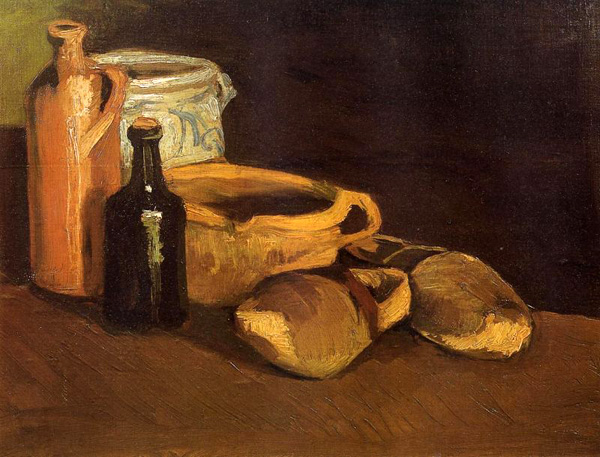
Earthen Pot and Clogs
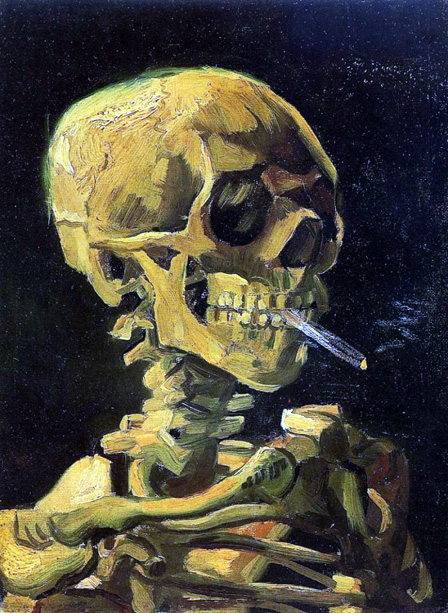
Skull of a Skeleton with Burning Cigarette, 1885–1886, oil on canvas, Van Gogh Museum
In November 1885, he moved to Antwerp and rented a small room above a paint dealer's shop in the Rue des Images (Lange Beeldekensstraat). He had little money and ate poorly, preferring to spend the money Theo sent on painting materials and models. Bread, coffee and tobacco were his staple intake. In February 1886, he wrote to Theo saying that he could only remember eating six hot meals since May of the previous year. His teeth became loose and painful. While in Antwerp he applied himself to the study of color theory and spent time in museums, particularly studying the work of Peter Paul Rubens, gaining encouragement to broaden his palette to carmine, cobalt and emerald green. He bought a number of Japanese Ukiyo-e woodcuts in the docklands, and incorporated their style into the background of a number of his paintings. While in Antwerp, van Gogh began to drink absinthe heavily. He was treated by Dr. Amadeus Cavenaile, whose practice was near the docklands, possibly for syphilis; the treatment of alum irrigation and sitz baths was jotted down by van Gogh in one of his notebooks. Despite his rejection of academic teaching, he took the higher-level admission exams at the Academy of Fine Arts in Antwerp, and in January 1886, matriculated in painting and drawing. For most of February, he was ill and run down by overwork, a poor diet and excessive smoking.
Van Gogh traveled to Paris in March 1886, where he shared Theo's Rue Laval apartment on Montmartre, to study at Fernand Cormon's studio. In June, they took a larger apartment further uphill, at 54 Rue Lepic. Because they had no need to write letters to communicate, little is known about this stay in Paris. In Paris he painted portraits of friends and acquaintances, still-life paintings, views of Le Moulin de la Galette, scenes in Montmartre, Asnières, and along the Seine.
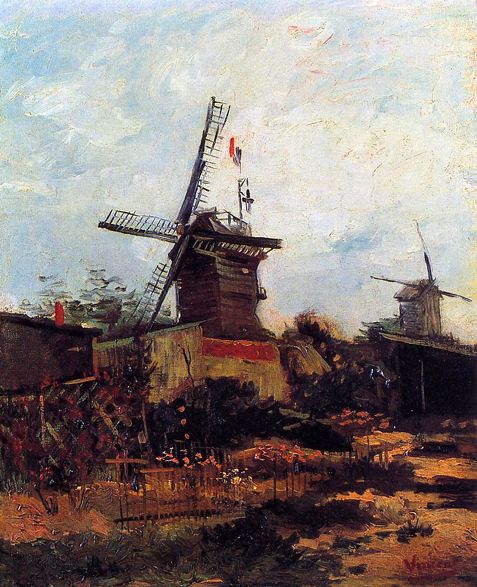
Le Moulin de BluteFin: 1886

Le Moulin de la Galette: 1886
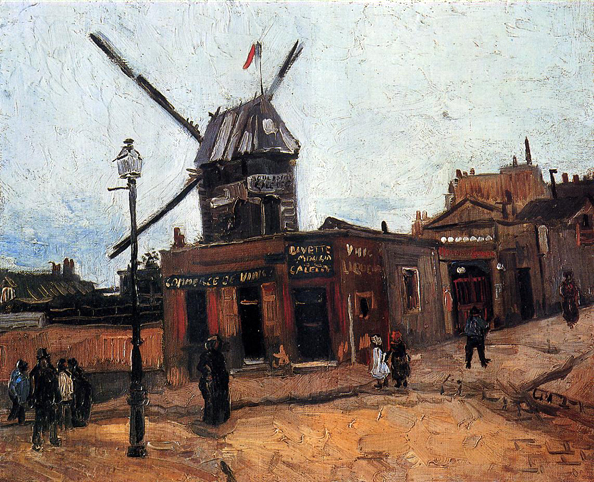
Le Moulin de la Galette: 1886

Le Moulin de la Galette: 1887
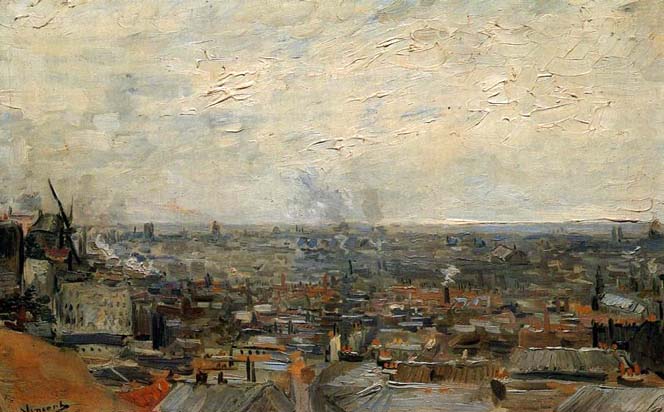
View of Paris from Montmartre: 1886
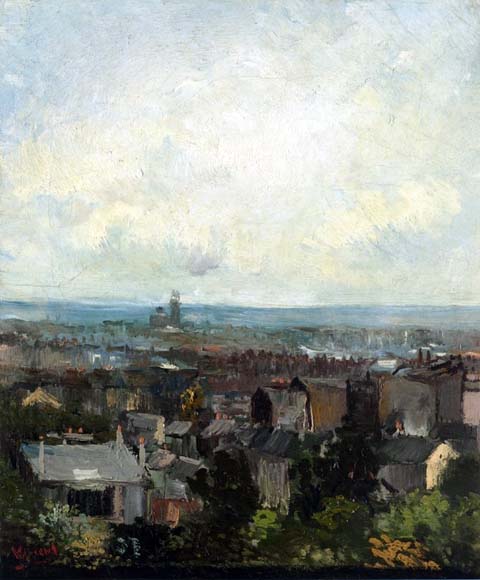
View of Paris from near Montmartre: 1886
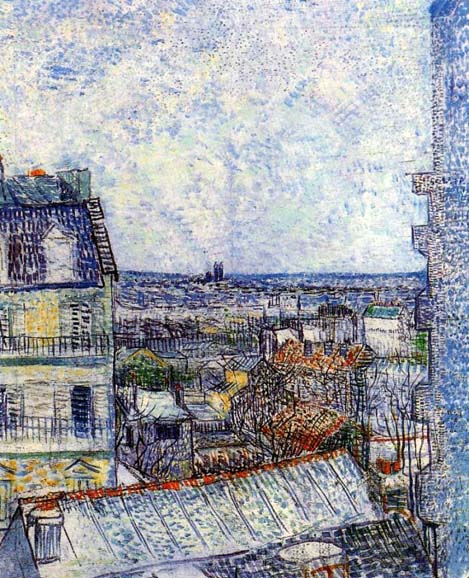
View of Paris from Vincent's Room in the Rue Lepic: 1887
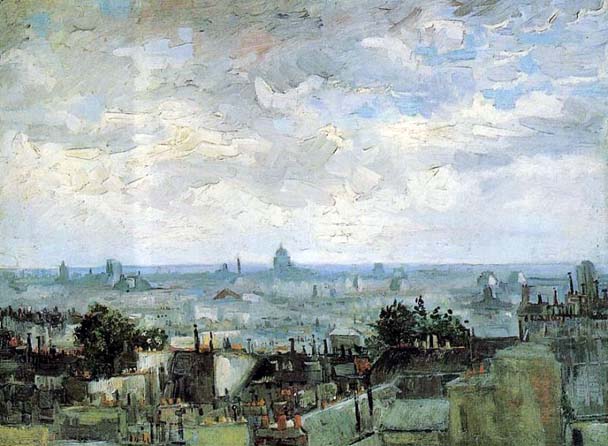
View of the Roofs of Paris: 1886
During his stay in Paris, he collected more Japanese ukiyo-e woodblock prints; he became interested in such works, when in 1885 in Antwerp he used them to decorate the walls of his studio. He collected hundreds of prints, which are visible in the backgrounds of several of his paintings. In his 1887 Portrait of Père Tanguy several can be seen hanging on the wall behind the main figure. In The Courtesan or Oiran (after Kesai Eisen) (1887), van Gogh traced the figure from a reproduction on the cover of the magazine Paris Illustre, which he then graphically enlarged in the painting. His 1888 Plum Tree in Blossom (After Hiroshige) is a vivid example of the admiration he had for the prints he collected. His version is slightly bolder than Hiroshige's original.
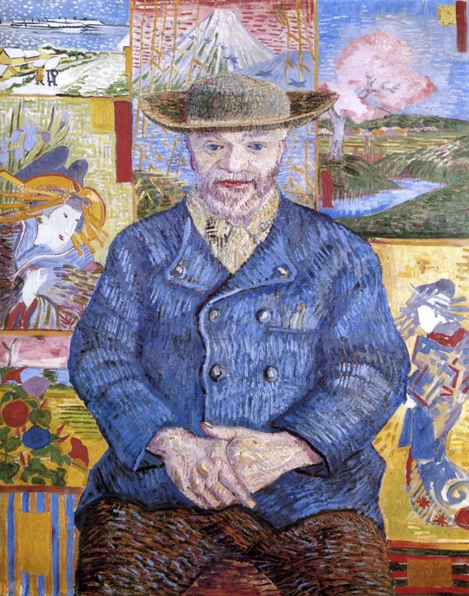
Portrait of Pere Tanguy: 1887
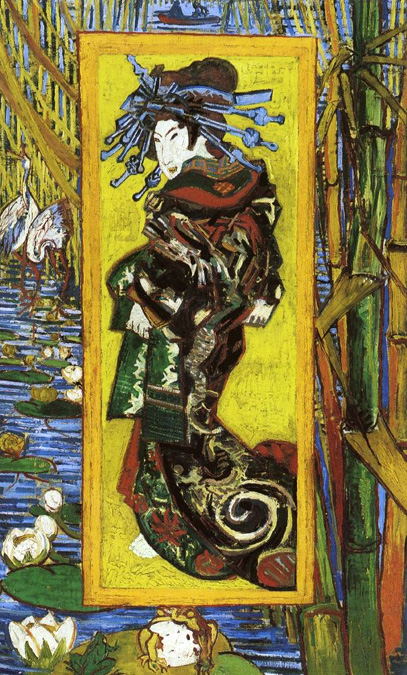
Japonaiserie, Oiran: 1887

Orchard with Blossoming Plum Trees: 1888

Japonaiserie: 1887
After seeing Adolphe Joseph Thomas Monticelli's work at the Galerie Delareybarette, which he admired, van Gogh immediately adopted a brighter palette and a bolder attack, particularly in paintings such as his Seascape at Saintes-Maries (1888). Two years later, in 1890, Vincent and Theo paid to have a book about Monticelli published, and van Gogh bought a number of Monticelli's paintings, adding them to his collection.
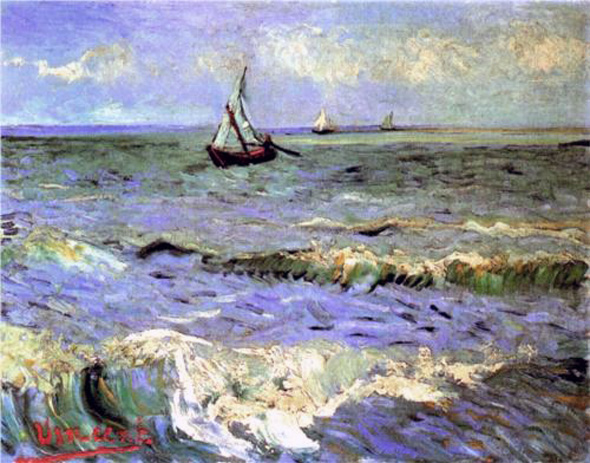
Seascape at Saintes-Maries: 1888
For months, van Gogh worked at Cormon's studio where he frequented the circle of the British-Australian artist John Peter Russell, and met fellow students like Émile Bernard, Louis Anquetin, and Henri de Toulouse-Lautrec-who painted a portrait of van Gogh with pastel. The group congregated at Julien "Père" Tanguy's paint store; at that time the only place where Paul Cézanne's paintings were displayed. He had easy access to Impressionist works in Paris at the time. In 1886, two large vanguard exhibitions were staged; shows where Neo-Impressionism was first exhibited and seen, with works by Georges Seurat and Paul Signac becoming the talk of the town. Though Theo kept a stock of Impressionist paintings in his gallery on Boulevard Montmartre-by artists including Claude Monet, Alfred Sisley, Edgar Degas and Camille Pissarro - van Gogh seemingly had problems acknowledging developments in how artists view and paint their subject matter.
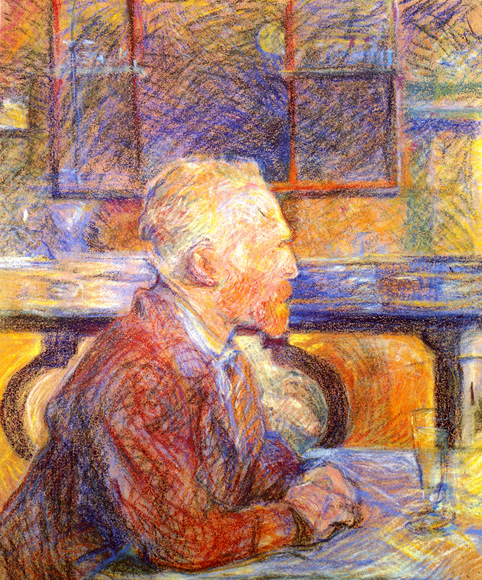
Henri de Toulouse-Lautrec, Portrait of Vincent van Gogh, 1887, pastel drawing, Van Gogh Museum
Conflicts arose between the brothers. At the end of 1886 Theo found that living with Vincent was "almost unbearable". By the spring of 1887, they were again at peace, although van Gogh moved to Asnières a northwestern suburb of Paris, where he became acquainted with Signac. With Émile Bernard he adopted elements of pointillism, a technique in which a multitude of small colored dots are applied to the canvas that, when seen from a distance, create an optical blend of hues. The style stresses the value of complementary colors-including blue and orange-to form vibrant contrasts that are enhanced when juxtaposed. While in Asnières he painted parks and restaurants and the Seine, including Bridges across the Seine at Asnières.
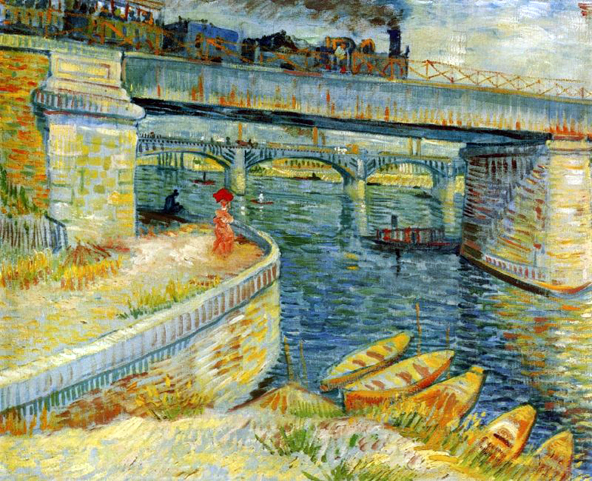
Bridges across the Seine at Asnieres: 1887
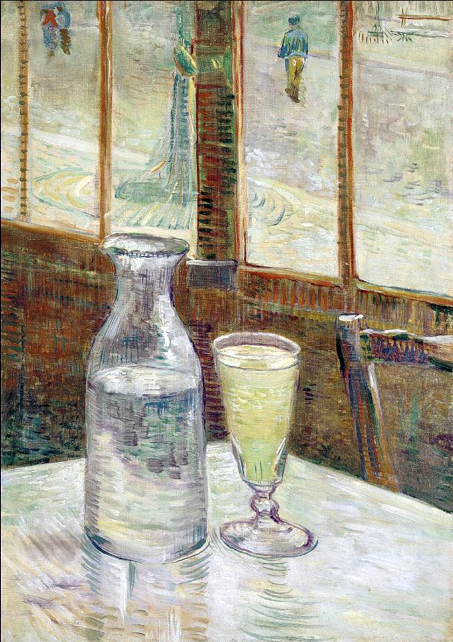
Cafe Table with Absinthe: 1887
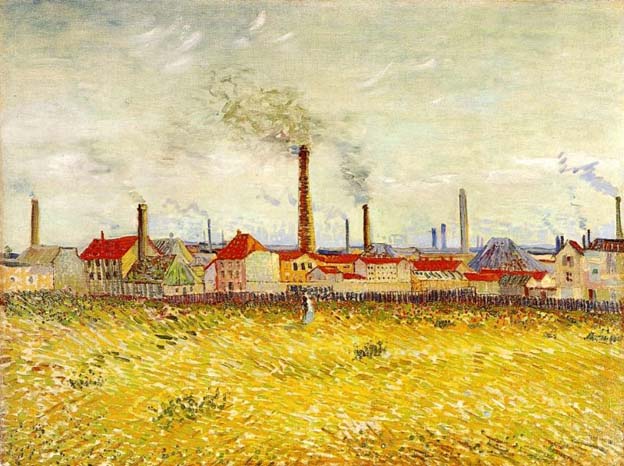
Factories at Asnieres: 1887
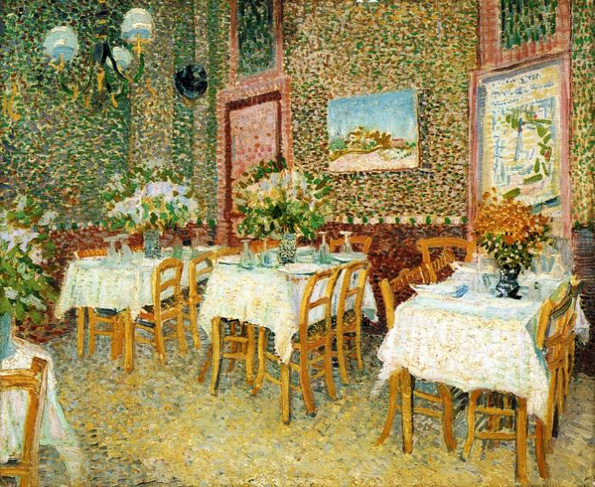
Interior of a Restaurant: 1887
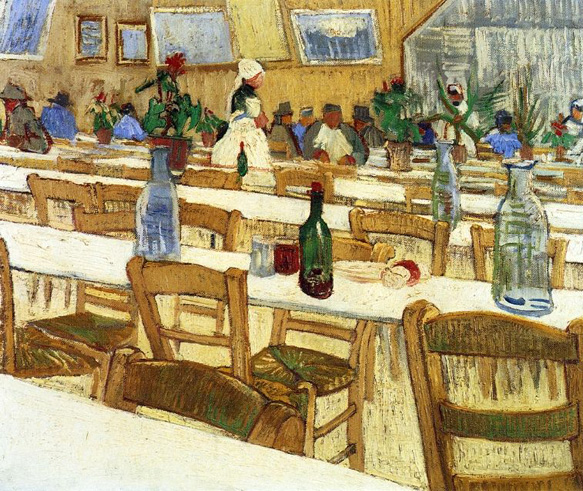
Interior of a Restaurant: 1887

Lane in Voyer d'Argenson Park at Asnieres: 1887
In November 1887, Theo and Vincent met and befriended Paul Gauguin who had just arrived in Paris. Towards the end of the year, Vincent arranged an exhibition of paintings by himself, Bernard, Anquetin, and probably Toulouse-Lautrec in the Grand-Bouillon Restaurant du Chalet, 43 Avenue de Clichy, in Montmartre. In a contemporary account, Emile Bernard wrote of the event: "On the avenue de Clichy a new restaurant was opened. Vincent used to eat there. He proposed to the manager that an exhibition be held there.... Canvases by Anquetin, by Lautrec, by Koning ...filled the hall....It really had the impact of something new; it was more modern than anything that was made in Paris at that moment." There Bernard and Anquetin sold their first paintings, and van Gogh exchanged work with Gauguin who soon departed to Pont-Aven. Discussions on art, artists and their social situations that started during this exhibition continued and expanded to include visitors to the show like Pissarro and his son Lucien, Signac and Seurat. Finally in February 1888, feeling worn out from life in Paris, he left, having painted over 200 paintings during his two years in the city. Only hours before his departure, accompanied by Theo, he paid his first and only visit to Seurat in his atelier (studio).
Van Gogh moved to Arles hoping for refuge at a time when he was ill from drink and suffering from smoker's cough. He arrived on 21 February 1888, and took a room at the Hôtel-Restaurant Carrel, which, idealistically, he had expected to look like one of Hokusai (1760-1849) or Utamaro's (1753-1806) prints. He seems to have had moved to the town with thoughts of founding a utopian art colony. The Danish artist Christian Mourier-Petersen (1858-1945), became his companion for two months, and at first Arles appeared exotic and filthy. In a letter he described it as a foreign country: "The Zouaves, the brothels, the adorable little Arlesiennes going to their First Communion, the priest in his surplice, who looks like a dangerous rhinoceros, the people drinking absinthe, all seem to me creatures from another world". A hundred years later, van Gogh was remembered by 113-year-old Jeanne Calment-who, as a 13 year old, was serving in her uncle's fabric shop where van Gogh wanted to buy some canvas-as "dirty, badly dressed and disagreeable", and "very ugly, ungracious, impolite, sick". She also recalled selling him colored pencils.
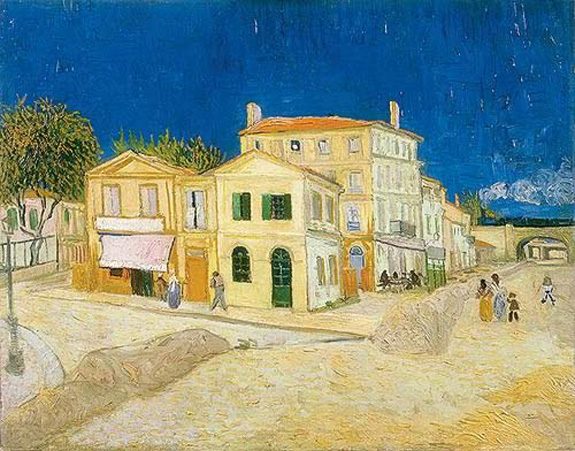
The Yellow House, Arles
In February 1888, van Gogh arrived in the town of Arles in southern France, where he dreamed of founding a "Studio of the South." A Greek colony in the sixth-century B.C., Arles later became a major urban center within the ancient Roman Empire, boasting many important monuments-an amphitheater (the largest in France), a theater, a circus, and public baths-before suffering centuries of decline. Although Arles enjoyed a second flourishing in the 12th through 15th centuries, by the time van Gogh arrived, it had reverted to a sleepy provincial town of about 30,000 inhabitants.
Van Gogh rented a small yellow house situated on the Place Lamartine. He intended that it would become the center of his Studio of the South. In a letter to his sister, he described the cheerful building as "a little yellow house with a green door and green blinds, whitewashed inside-on the white walls very brightly colored Japanese prints, red tiles on the floor-the house in the full sunlight-and over it an intensely blue sky…."
Soon after renting the yellow house in early May, he began to dream that Gauguin would join him as the head of the artists' colony. In anticipation of Gauguin's arrival, van Gogh launched an ambitious campaign to furnish and decorate his studio, producing some of his best-loved paintings. In August he reported that he was working on "half a dozen pictures of 'Sunflowers,' a decoration in which the raw or broken chrome yellows will blaze forth on various backgrounds," ranging from "the palest malachite green to royal blue." In October he completed another decorative scheme intended for Gauguin's bedroom. The series, which he called "the Poet's Garden," featured the park across the street.
By the time Gauguin arrived on October 23, 1888, he found the yellow house ablaze with van Gogh's canvases, and the Studio of the South was officially underway.
Quoted From: The Art Institute of Chicago
Van Gogh was enchanted by the local landscape and light, and his works from the period are richly draped in yellow, ultramarine and mauve. His portrayals of the Arles landscape are informed by his Dutch upbringing; the patchwork of fields and avenues appear flat and lack perspective, but excel in their intensity of color. The vibrant light in Arles excited him, and his newfound appreciation is seen in the range and scope of his work. That March he painted local landscapes using a gridded "perspective frame". Three of these paintings were shown at the annual exhibition of the Société des Artistes Indépendants. In April, he was visited by the American artist Dodge MacKnight, who was living nearby at Fontvieille. On 1 May, he signed a lease for 15 francs a month in the eastern wing of the Yellow House at No. 2 Place Lamartine. The rooms were unfurnished and uninhabited for some time. He was still at the Hôtel Restaurant Carrel, but the rate charged by the hotel was 5 francs a week, which he found excessive. He disputed the price, took the case to a local arbitrator and was awarded a twelve franc reduction on the total bill.
He moved from the Hôtel Carrel to the Café de la Gare on 7 May, where he became friends with the proprietors, Joseph and Marie Ginoux. Although the Yellow House had to be furnished before he could fully move in, van Gogh was able to utilize it as a studio. Hoping to have a gallery to display his work, his project at this time was a series of paintings including Van Gogh's Chair (1888), Bedroom in Arles (1888), The Night Café (1888), Cafe Terrace at Night (September 1888), Starry Night Over the Rhone (1888), Still Life: Vase with Twelve Sunflowers (1888), all intended to form the décoration for the Yellow House. van Gogh wrote about The Night Café: "I have tried to express the idea that the café is a place where one can ruin oneself, go mad, or commit a crime."
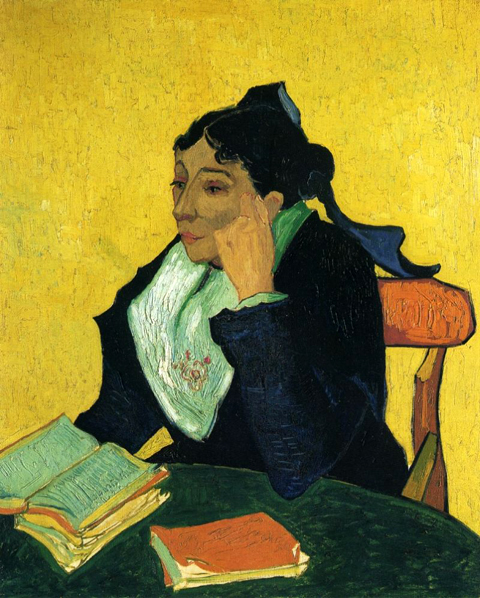
L'Arlesienne, Portrait of Madame Ginoux: 1888
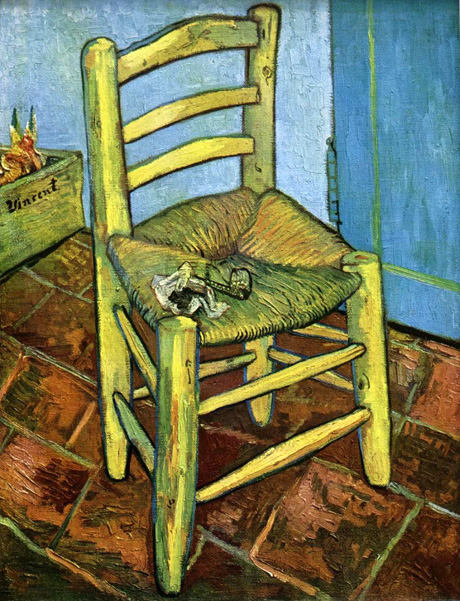
Van Gough's Chair: 1888
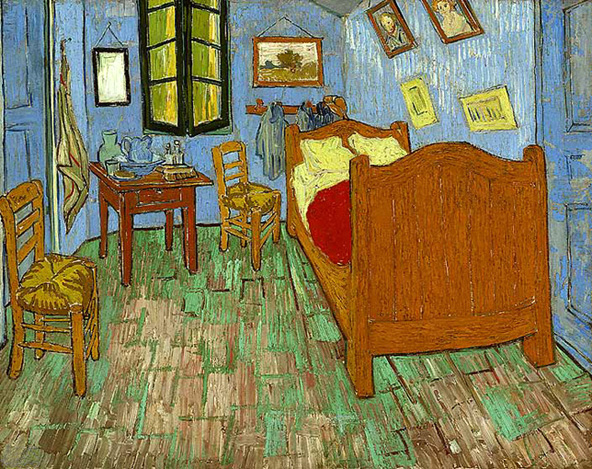
The Bedroom in Arles, 1888
Here, Van Gogh has depicted his bedroom in the Yellow House, furnished with simple pine furniture
and his own paintings. Over the bed hang his portraits of the poet Eugène Boch and the soldier Paul-Eugène Milliet.
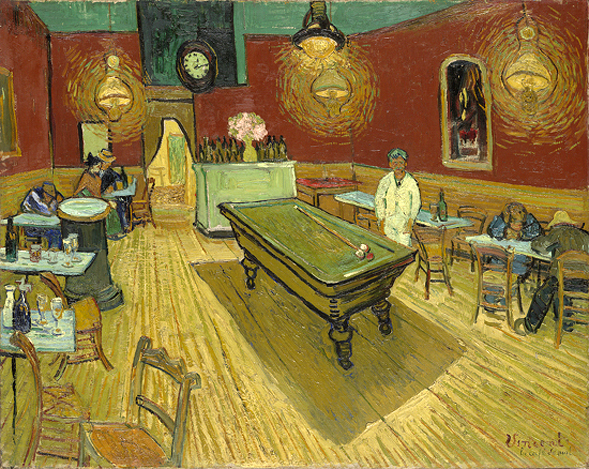
The Night Cafe: 1888
The interior depicted is the Café de la Gare, 30 Place Lamartine, run by Joseph-Michel and his wife Marie Ginoux,
who in November 1888 posed for Van Gogh's and Gauguin's Arlésienne; a bit later, Joseph Ginoux evidently posed for both artists, too.
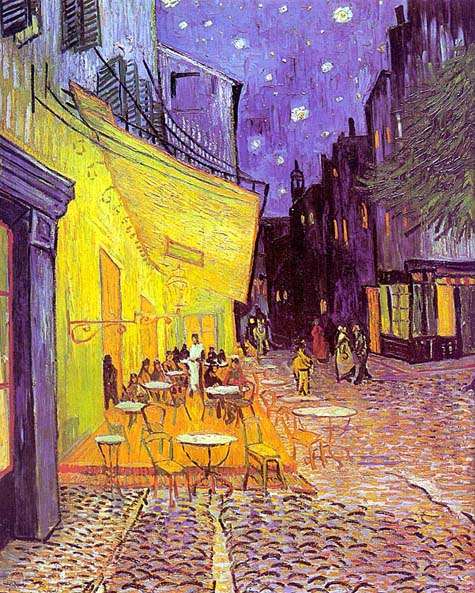
Cafe Terrace at Night: 1888
Café Terrace at Night, also known as The Cafe Terrace on the Place du Forum, is a colored oil painting executed by the Dutch artist Vincent van Gogh on an industrially primed canvas of size 25 (Toile de 25 figure) in Arles, France, mid-September 1888. The painting is not signed, but described and mentioned by the artist in his letters on various occasions. There is also a large pen drawing of the composition which originates from the artist's estate.
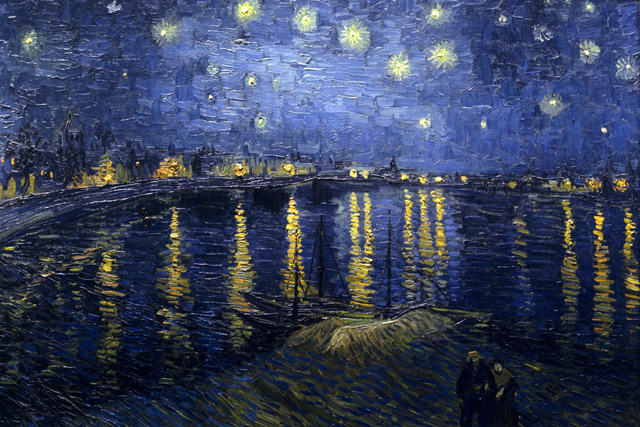
Starry Night Over the Rhone: 1888
Starry Night Over the Rhone (September 1888) is one of Vincent van Gogh's paintings of Arles at night; it was painted at a spot on the river bank that was only a minute or two's walk from the Yellow House on the Place Lamartine which Van Gogh was renting at the time. The night sky and the effects of light at night provided the subject for some of his more famous paintings, including Cafe Terrace at Night (painted earlier the same month) and the later canvas from Saint-Rémy, The Starry Night.

Vase with Twelve Sunflowers: 1888
When he visited Saintes-Maries-de-la-Mer that June he gave drawing lessons to a Zouave second lieutenant, Paul-Eugène Milliet and painted boats on the sea and the village. MacKnight introduced van Gogh to Eugène Boch, a Belgian painter who stayed at times in Fontvieille, and the two exchanged visits in July.
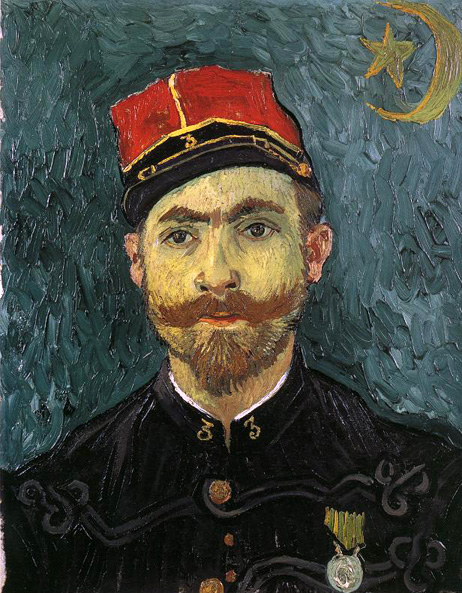
Paul-Eugene Milliet
When Gauguin agreed to visit Arles, van Gogh hoped for friendship and for his utopian idea of a collective of artists. In anticipation that August he painted sunflowers. When Boch visited again, van Gogh painted a portrait of him, as well as the study The Poet Against a Starry Sky. Boch's sister Anna (1848-1936), also an artist, purchased The Red Vineyard in 1890. In preparation for Gauguin's visit he bought two beds, on advice from his friend the station's postal supervisor Joseph Roulin, whose portrait he painted, and on 17 September spent the first night in the still sparsely furnished Yellow House. When Gauguin consented to work and live side-by-side in Arles with van Gogh, he started to work on The Décoration for the Yellow House, probably the most ambitious effort he ever undertook. van Gogh did two chair paintings: Van Gogh's Chair and Gauguin's Chair.
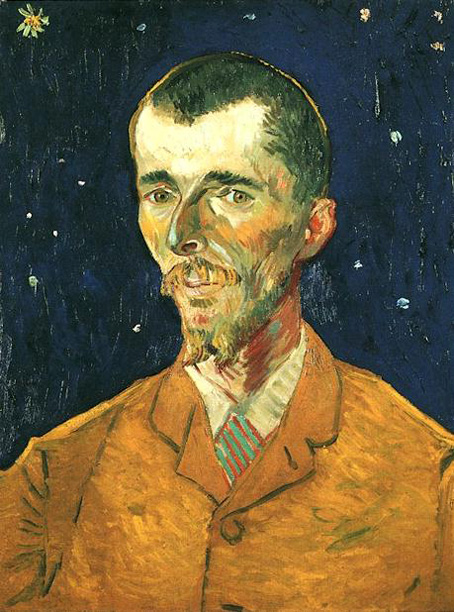
Portrait of Eugene Boch
Eugène Boch (1855-1941) was a Belgian painter, born in Saint-Vaast, Hainaut, who was the younger brother of Anna Boch, a founding member of Les XX. Born into a wealthy dynasty of manufacturers of fine china and ceramics, still active today under the firm of Villeroy & Boch, Eugène Boch enrolled in the private atelier of Léon Bonnat in Paris, in 1879. Since 1882, when Bonnat closed his atelier, he studied at the atelier of Fernand Cormon. Paintings of him were admitted to the Salon in 1882, 1883 and 1885. In June 1888, he was introduced by Dodge MacKnight to Vincent van Gogh.
The portrait was executed in the first days of September 1888, a few days before Boch's departure. In the first version of Van Gogh's Bedroom, executed in October 1888, this portrait is shown hanging to the left of the portrait of Paul-Eugène Milliet. Arranged this way, both portraits may have formed part of the Décoration for the Yellow House.
When Eugène Boch died in 1941, he bequested The Poet (that is Van Gogh's title for his portrait of Eugène Boch, which Boch received from Johanna van Gogh-Bonger as a present in July 1891) to the Louvre.
Quoted From: Wikipedia, Eugène Boch
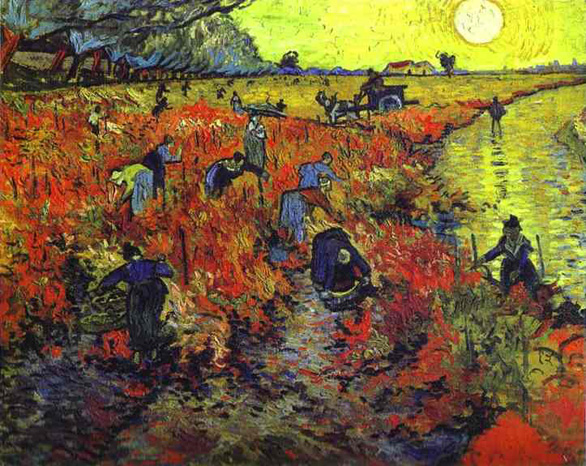
Red Vineyards: 1888
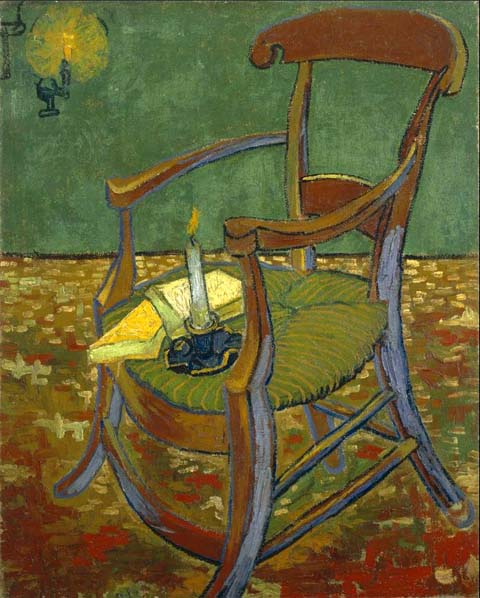
Gauguin's Chair: 1888
It is evening or nighttime. The central object in this painting is a chair of dark brown wood, with curved backrests and an upholstered seat, upon which books lie. The space is illuminated by gaslight. With great sureness of touch, Van Gogh painted the blue shadows and reflections thrown by the lamplight onto the shining wood of the chair. This painting of his friend's chair was made in November 1888, when Gauguin was staying with Van Gogh in the so-called Yellow House.
Quoted From: The Van Gogh Museum, Amsterdam
After repeated requests, Gauguin finally arrived in Arles on 23 October. During November, the two painted together. Gauguin painted van Gogh's portrait The Painter of Sunflowers: Portrait of Vincent van Gogh, and uncharacteristically, van Gogh painted some pictures from memory-deferring to Gauguin's ideas in this-as well as his The Red Vineyard. Their first joint outdoor painting exercise produced Les Alyscamps, and was conducted at the Alyscamps.
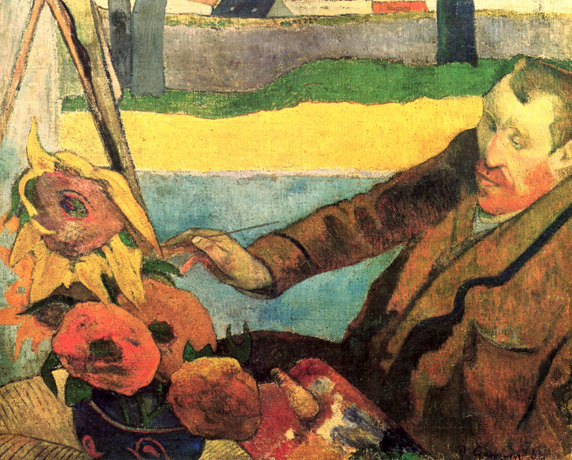
Portrait of Vincent van Gogh
by Paul Gauguin
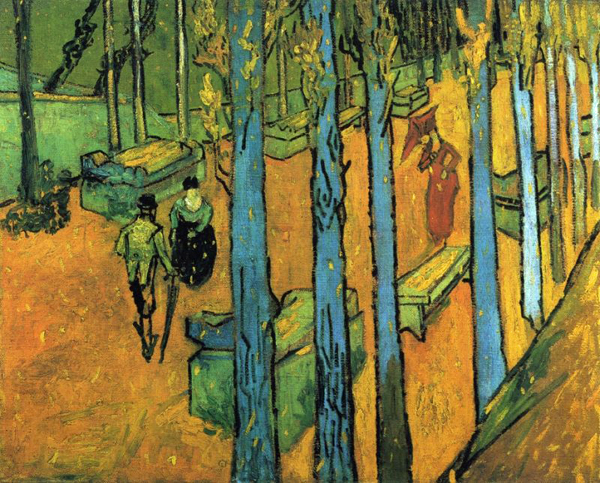
Les Alychamps, Autumn 1888
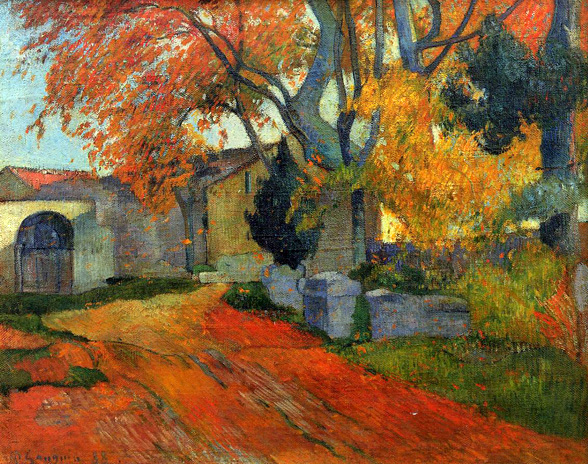
Lane at Alchamps, Arles 1888 by Paul Gauguin
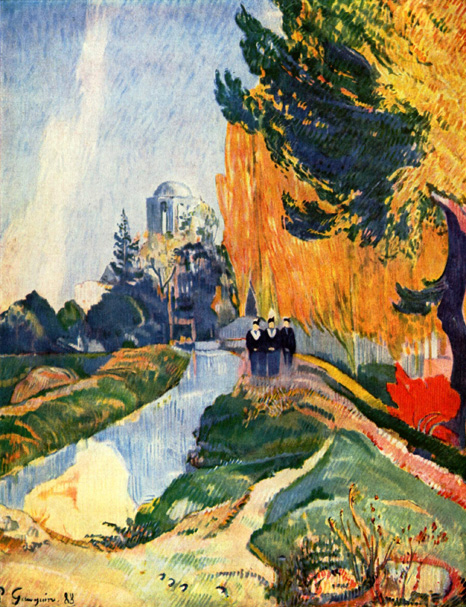
Paul Gauguin, Les Alychamps: 1888

Van Gogh, Alyscamps
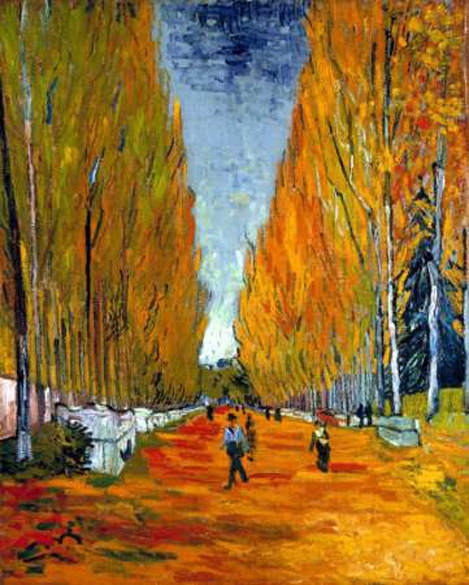
Van Gogh, Lallee Des Alyscamps
The two visited Montpellier that December and viewed works in the Alfred Bruyas collection by Courbet and Delacroix in the Musée Fabre, but their relationship began to deteriorate. Van Gogh greatly admired Gauguin, and desperately wanted to be treated as his equal. But Gauguin was arrogant and domineering, a fact that often frustrated van Gogh. They quarreled fiercely about art; van Gogh felt an increasing fear that Gauguin was going to desert him, as a situation he described as one of "excessive tension" reached crisis point.
On 23 December 1888, frustrated and ill, van Gogh confronted Gauguin with a razor blade, but in panic, left and fled to a local brothel. Deeply lonely at the time, he often visited the prostitutes at a brothel on Rue du Bout d'Aeles as his single emotional and sensuous point of contact with other people. While there, he cut off his left ear, though it is often claimed that it was only the lower part of his left earlobe. He wrapped the severed ear in newspaper and handed it to a prostitute named Rachel, asking her to "keep this object carefully." He staggered home, where he was later found by Gauguin lying unconscious with his head covered in blood.
Van Gogh was taken to a hospital and remained in a critical state for several days. He asked for Gauguin continually over the next number of days, but the Frenchman stayed away. Gauguin told one of the policeman attending the case, "Be kind enough, Monsieur, to awaken this man with great care, and if he asks for me tell him I have left for Paris; the sight of me might prove fatal for him." Gauguin wrote of van Gogh, "His state is worse, he wants to sleep with the patients, chase the nurses, and washes himself in the coal bucket. That is to say, he continues the biblical mortifications." Theo was notified by Gauguin and visited, as did both Madame Ginoux and Roulin. Gauguin left Arles and never saw van Gogh again. In January 1889, van Gogh returned to the Yellow House, but spent the following month between the hospital and home, suffering from hallucinations and delusions that he was being poisoned. In March, the police closed his house after a petition by 30 townspeople, who called him "fou roux" (the redheaded madman). Paul Signac visited him in the hospital and van Gogh was allowed home in his company. In April, he moved into rooms owned by Dr. Rey, after floods damaged paintings in his own home. Around this time, he wrote, "Sometimes moods of indescribable anguish, sometimes moments when the veil of time and fatality of circumstances seemed to be torn apart for an instant." Two months later he had left Arles and entered an asylum in Saint-Rémy-de-Provence.
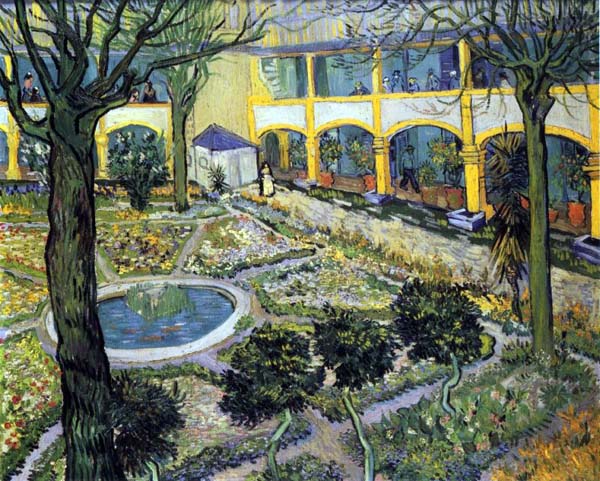
Courtyard of the Hospital in Arles: 1889
On 8 May 1889, accompanied by his care giver, the Reverend Salles, van Gogh committed himself to the hospital at Saint Paul-de-Mausole. A former monastery in Saint-Rémy less than 20 miles from Arles, the monastery is located in an area of cornfields, vineyards and olive trees at the time run by a former naval doctor, Dr. Théophile Peyron. Theo arranged for two small rooms-adjoining cells with barred windows. The second was to be used as a studio.
During his stay, the clinic and its garden became the main subjects of his paintings. He made several studies of the hospital interiors, such as Vestibule of the Asylum and Saint-Remy (September 1889). Some of the work from this time is characterized by swirls-including one of his best-known paintings The Starry Night. He was allowed short supervised walks, which led to paintings of cypresses and olive trees, like Olive Trees with the Alpilles in the Background 1889, Cypresses 1889, Cornfield with Cypresses (1889), and Country road in Provence by Night (1890). That September he also produced a further two versions of Bedroom in Arles.
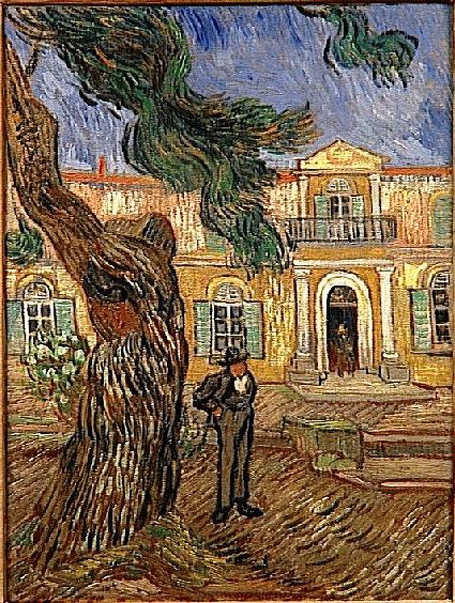
Hospital in Saint-Remy: 1889
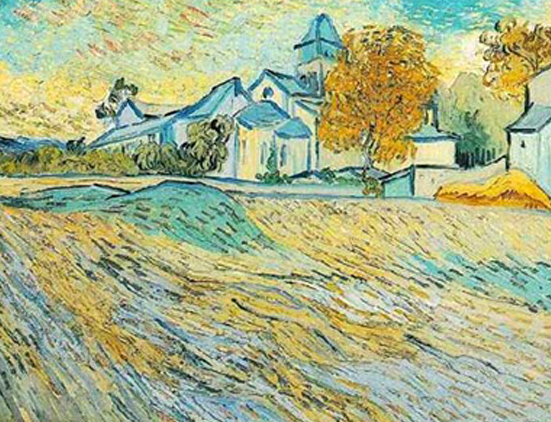
View of the Asylum and Chapel at Saint Remy: 1889
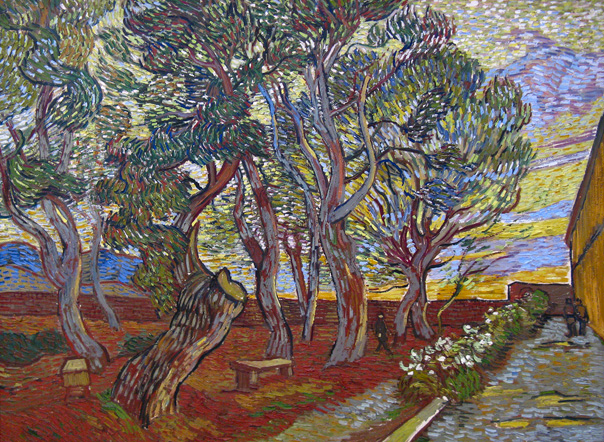
The Garden of Saint-Paul Hospital: 1889
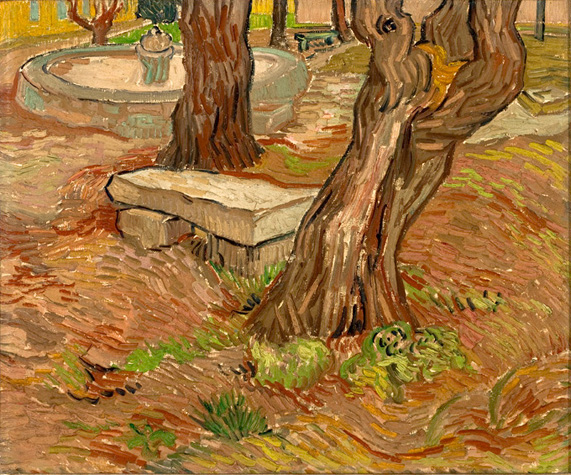
Stone Bench in the Garden of Saint-Paul Hospital: 1889
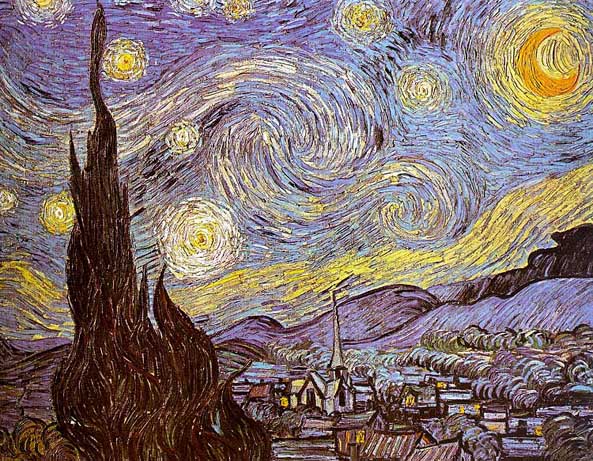
The Starry Night: 1889
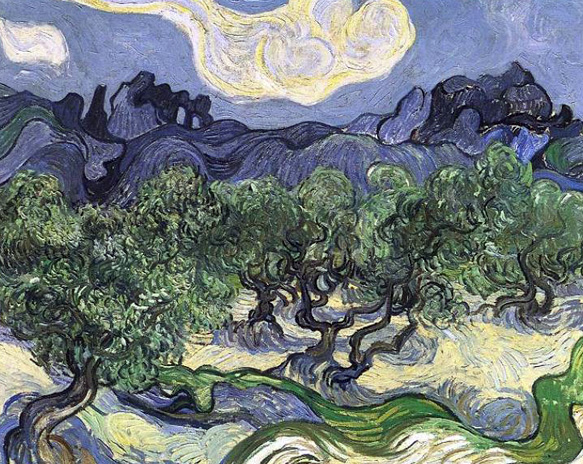
Olive Trees with the Alpilles in the Background: 1889

Cypresses: 1889
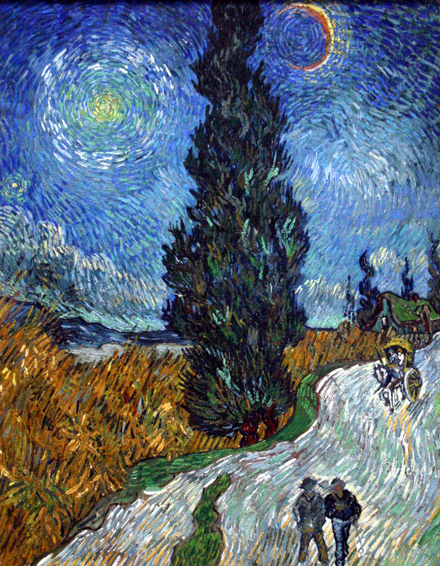
Country Road in Provence by Night: 1889
Limited access to the world outside the clinic resulted in a shortage of subject matter. He was left to work on interpretations of other artist's paintings, such as Millet's The Sower and Noon - Rest from Work (after Millet), as well as variations on his own earlier work. Van Gogh was an admirer of the Realism of Jules Breton, Gustave Courbet and Millet and compared his copies to a musician's interpreting Beethoven. Many of his most compelling works date from this period. His The Round of the Prisoners (1890) was painted after an engraving by Gustave Doré (1832-1883). It is suggested that the face of the prisoner in the center of the painting and looking toward the viewer is van Gogh himself, although the noted van Gogh scholar Jan Hulsker discounts this.
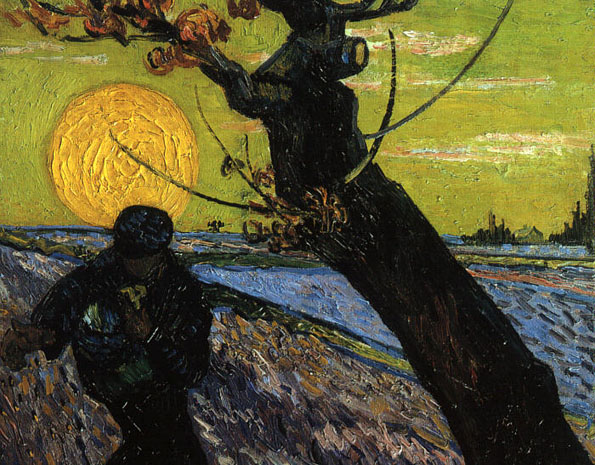
The Sower: 1888

Noon, Rest from Work
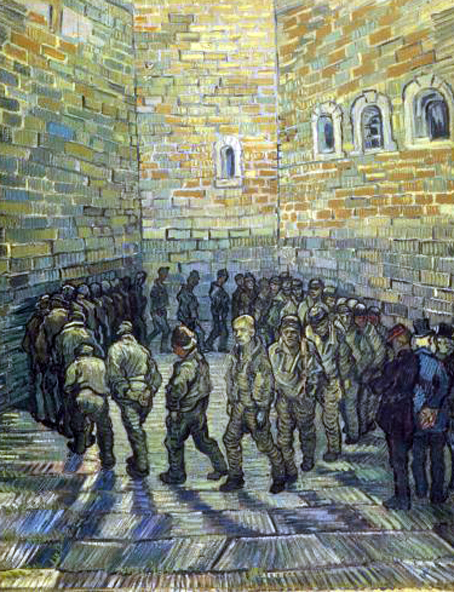
The Round of the Prisoners: 1890
Towards the end of his stay, van Gogh suffered a severe relapse lasting two month between February and April 1890. Nevertheless he was able to paint and draw a little during this time and he later wrote Theo that he had made a few small canvases "from memory ... reminisces of the North". Among these was Two Peasant Women Digging in a Snow-Covered Field at Sunset. Hulsker believes that this small group of paintings formed the nucleus of a large number of drawings and study sheets depicting landscapes and figures that van Gogh worked on during this time. He comments that, save for this short period, van Gogh's illness had hardly any effect on his work but in these he sees a reflection of van Gogh's mental health at the time. Also belonging to this period is Sorrowing Old Man ('At Eternity's Gate'), a color study that Hulsker describes as "another unmistakable remembrance of times long past.
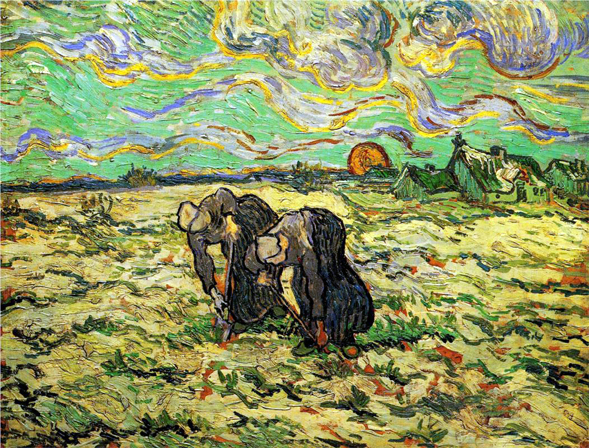
Two Peasant Women Digging in a Snow-Covered Field at Sunset: 1890
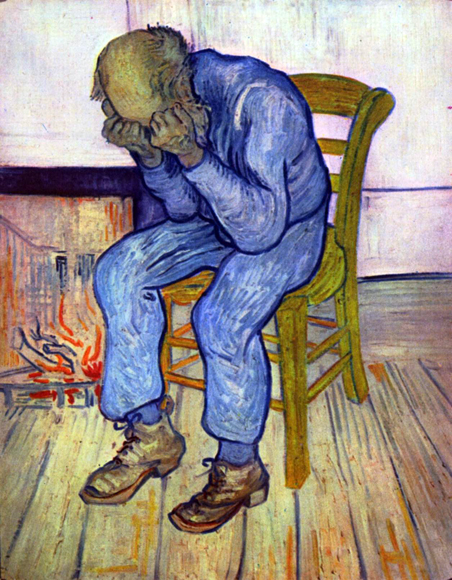
Sorrowing Old Man At Eternity's Gate: 1890
In February 1890 he painted five versions of L'Arlésienne (Madame Ginoux), based on a charcoal sketch Gauguin had produced when Madame Ginoux sat for both artists at the beginning of November 1888. The version intended for Madame Ginoux is lost. It was attempting to deliver this painting to Madame Ginoux in Arles that precipitated his February relapse.
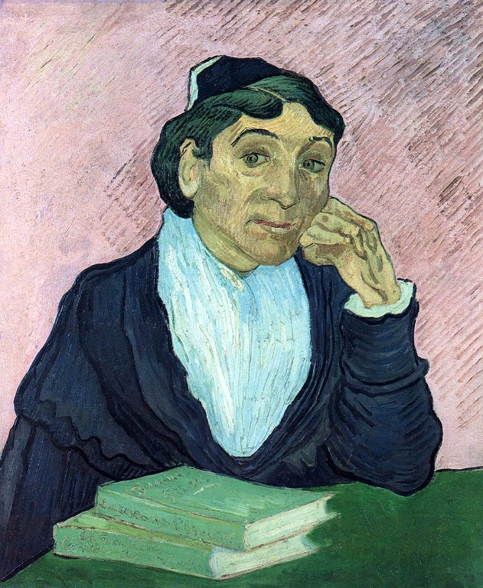
L'Arlesienne, Portrait of Madame Ginoux: 1890
His work was praised by Albert Aurier in the Mercure de France in January 1890, when he was described as "a genius". That February he was invited by Les XX, a society of avant-garde painters in Brussels, to participate in their annual exhibition. At the opening dinner, Les XX member Henry de Groux insulted van Gogh's work. Toulouse-Lautrec demanded satisfaction, while Signac declared he would continue to fight for van Gogh's honor if Lautrec should surrender. Later, while van Gogh's exhibit was on display with the Artistes Indépendants in Paris, Monet said that his work was the best in the show. In February 1890, following the birth of his nephew Vincent Willem, he wrote in a letter to his mother, that with the new addition to the family, he "started right away to make a picture for him, to hang in their bedroom, branches of white almond blossom against a blue sky."
In May 1890, van Gogh left the clinic in Saint-Rémy to move nearer the physician Dr. Paul Gachet in Auvers-sur-Oise, and also to Theo. Gachet was recommended by Camille Pissarro, had treated several other artists, and was himself an amateur artist. Van Gogh's first impression was that Gachet was "...sicker than I am, I think, or shall we say just as much." In June 1890 he painted a number of portraits of the physician, including Portrait of Dr. Gachet, and his only etching; in each the emphasis is on Gachet's melancholic disposition. Van Gogh stayed at the Auberge Ravoux, where he paid 3 francs and 50 centimes to rent an attic room measuring 75 square feet.
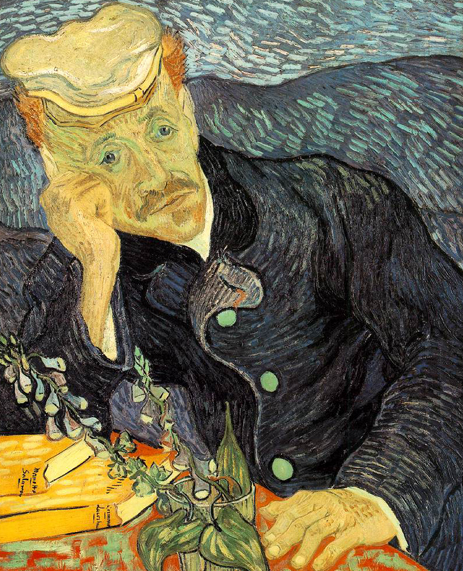
Portrait of Dr. Gachet: 1890
Before he left, in his last weeks at Saint-Rémy, van Gogh's thoughts returned to his "memories of the North", and several of the approximately 70 oils he painted during his 70 days in Auvers-sur-Oise, such as The Church at Auvers, are reminiscent of northern scenes.
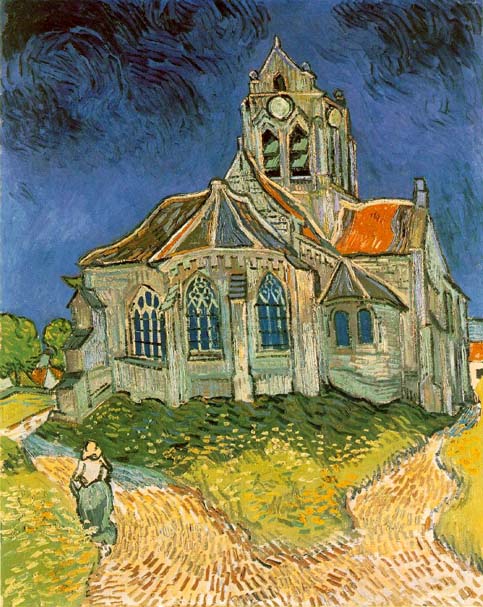
Church at Auvers: 1890
Wheat Field with Crows (July 1890) is an example of the double square technique he developed in the last weeks of his life. In its turbulent intensity, it is among his most haunting and elemental works. It is often mistakenly believed to be his last work, Hulsker lists seven paintings that postdate it.

Wheatfield with Crows: 1890
Barbizon painter Charles Daubigny had moved to Auvers in 1861, and this in turn drew other artists there, including Camille Corot and Honoré Daumier. In July 1890, van Gogh completed two paintings of Daubigny's Garden; one of these is likely to be his final work. There are also paintings that show evidence of being unfinished, including Thatched Cottages by a Hill.
Daubigny's Garden
(Daubigny's Garden, painted three times by Vincent van Gogh, depicts the enclosed garden of Charles-François Daubigny, a painter whom Van Gogh admired throughout his life.)

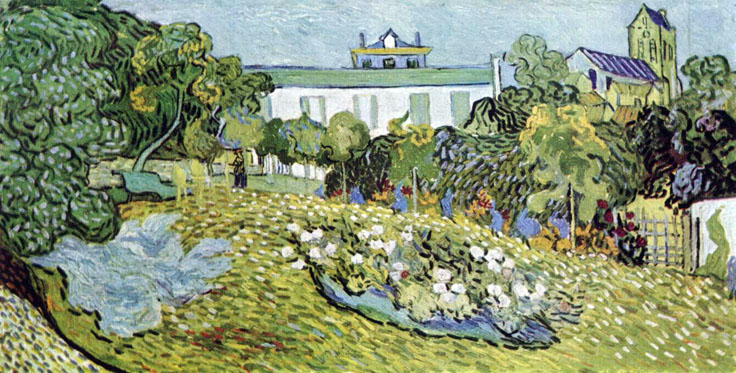


Thatched Cottages by a Hill: 1890
On 22 February 1890, van Gogh suffered a new crisis that was "the starting point for one of the saddest episodes in a life already rife with sad events". This period lasted until the end of April, during which time he was unable to bring himself to write though he did continue to draw and paint. Hughes writes that from May 1889 to May 1890 he, "had fits of despair and hallucination during which he could not work, and in between them, long clear months in which he could and did, punctuated by extreme visionary ecstasy."
On 27 July 1890, aged 37, van Gogh shot himself in the chest with a revolver. Where he was when he shot himself is unclear. Ingo Walther writes that "Some think van Gogh shot himself in the wheat field that had engaged his attention as an artist of late; others think he did it at a barn near the inn." Biographer David Sweetman writes that the bullet was deflected by a rib bone and passed through his chest without doing apparent damage to internal organs, probably stopped by his spine. He was able to walk back to the Auberge Ravoux. He was attended by two physicians neither with the capability to perform surgery to remove the bullet who left him alone in his room, smoking his pipe. The following morning (Monday), as soon as he was notified, Theo rushed to be with Vincent, to find him in surprisingly good shape; within hours, however, he began to fail, the result of untreated infection in the wound. Vincent died in the evening, 29 hours after he shot himself. Theo reported his brother's last words as "The sadness will last forever."
Van Gogh was buried on 30 July in the municipal cemetery of Auvers-sur-Oise at a funeral attended by Theo van Gogh, Andries Bonger, Charles Laval, Lucien Pissarro, Émile Bernard, Julien Tanguy and Dr. Gachet among some 20 family and friends, as well as a number of locals. The funeral was described by Émile Bernard in a letter to Albert Aurier. Theo suffered from syphilis and his health declined rapidly after Vincent's death. Weak and unable to come to terms with Vincent's absence, he died six months later, on 25 January, at Den Dolder. The original burial plot was leased for 15 years; the intention was to bury Vincent alongside Theo. Vincent's remains were exhumed on 13 June 1905, in the presence of Jo Bonger, Dr. Gachet and others, and relocated, eventually for Theo to be buried beside him. The precise location of the original grave is no longer known. In 1914, the year she had van Gogh's letters published, Jo Bonger had Theo moved from Utrecht and reburied with Vincent.
While many of Vincent's late paintings are somber, they are essentially optimistic and reflect his desire to return to lucid mental health right up to the time of his death. Yet some of his final works reflect his deepening concerns. Referring to his paintings of wheat fields under troubled skies, he commented in a letter to his brother Theo: "I did not have to go out of my way very much in order to try to express sadness and extreme loneliness." Nevertheless, he adds in the same paragraph: "... these canvases will tell you what I cannot say in words, that is, how healthy and invigorating I find the countryside".
There has been much debate over the years as to the source of van Gogh's illness and its effect on his work. Over 150 psychiatrists have attempted to label its root, with some 30 different diagnoses. Diagnoses include schizophrenia, bipolar disorder, syphilis, poisoning from swallowed paints, temporal lobe epilepsy and acute intermittent porphyria. Any of these could have caused his death. The culprit was probably aggravated by malnutrition, overwork, insomnia and consumption of alcohol, especially absinthe.
In Van Gogh: the Life, a biography published in 2011, authors Steven Naifeh and Gregory White Smith argue that van Gogh did not commit suicide. They contend that he was shot accidentally by two boys he knew who had "a malfunctioning gun". However experts at the Van Gogh Museum remain unconvinced. Prominent skeptic Joe Nickell also was not convinced. Nickell analyzed the questions raised by Naifeh and Smith to support their new theory and found that all can be addressed with a more likely answer. By ignoring the well-known psychological state of Van Gogh (given to self-inflicting harm, self-mortification) and much more reliable testimony (from Adeline Ravoux, daughter of the inn keeper Gustave Ravoux, the owner of the gun), Naifeh and Smith instead make a lot of assumptions on the circumstances around the incident, and misrepresent what Rene Secretan (one of the two boys) said sixty-six years later in 1956, who did not confess shooting Van Gogh. Nickell concludes that their theory is the result of the logical fallacy of 'confirmation bias' - "start the investigation with a supposed answer and work backward to the evidence".
Van Gogh drew and painted with watercolors while at school, however few survive and authorship is challenged on some of those that do. When he committed to art as an adult, he began at an elementary level, copying the Cours de dessin, a drawing course edited by Charles Bargue. Within two years he had begun to seek commissions. In spring 1882, his uncle, Cornelis Marinus, owner of a well-known gallery of contemporary art in Amsterdam, asked him for drawings of the Hague. Van Gogh's work did not live up to his uncle's expectations. Marinus offered a second commission, this time specifying the subject matter in detail, but was once again disappointed with the result. Nevertheless, van Gogh persevered. He improved the lighting of his studio by installing variable shutters and experimented with a variety of drawing materials. For more than a year he worked on single figures-highly elaborated studies in "Black and White", which at the time gained him only criticism. Today, they are recognized as his first masterpieces.
Early in 1883, he began to work on multi-figure compositions, which he based on his drawings. He had some of them photographed, but when his brother remarked that they lacked liveliness and freshness, he destroyed them and turned to oil painting. By Autumn 1882, his brother had enabled him financially to turn out his first paintings, but all the money Theo could supply was soon spent. Then, in spring 1883, van Gogh turned to renowned Hague School artists like Weissenbruch and Blommers, and received technical support from them, as well as from painters like De Bock and Van der Weele, both second generation Hague School artists. When he moved to Nuenen after the intermezzo in Drenthe he began a number of large-sized paintings but destroyed most of them. The Potato Eaters and its companion pieces-The Old Tower on the Nuenen cemetery and The Cottage-are the only ones to have survived. Following a visit to the Rijksmuseum, Van Gogh was aware that many of his faults were due to lack of technical experience. So in November 1885 he traveled to Antwerp and later to Paris to learn and develop his skill.
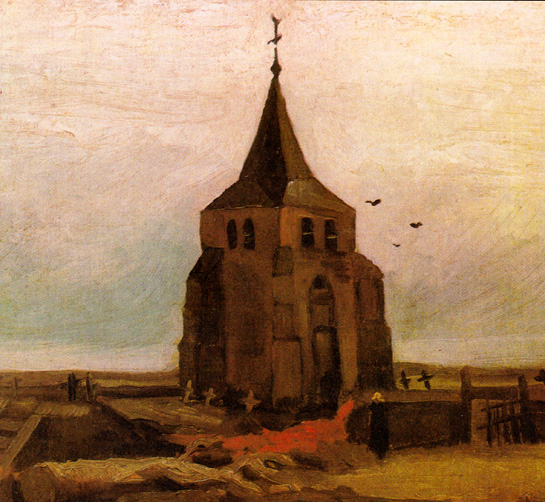
The Old Tower on the Nuenen Cemetery
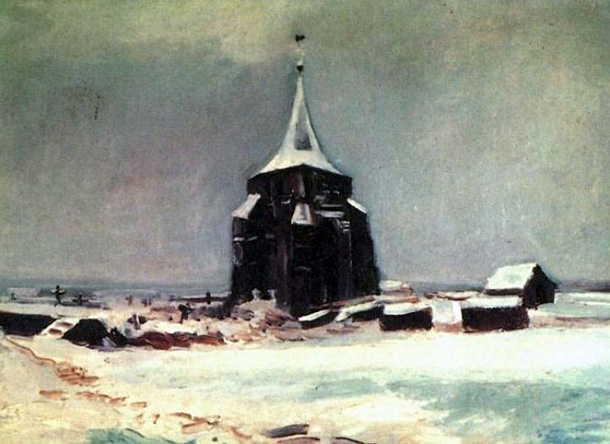
Old Cemetery Tower at Nuenen in the Snow
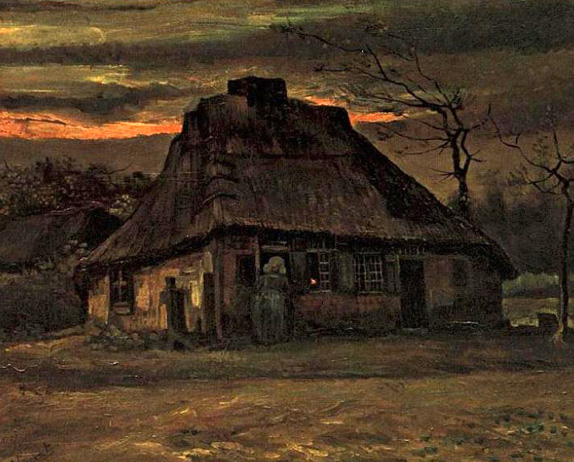
The Cottage: 1885
After becoming familiar with Impressionist and Neo-Impressionist techniques and theories, van Gogh went to Arles to develop on these new possibilities. But within a short time, older ideas on art and work reappeared: ideas such as working with serial imagery on related or contrasting subject matter, which would reflect on the purposes of art. As his work progressed, he painted many Self-Portraits. Already in 1884 in Nuenen he had worked on a series that was to decorate the dining room of a friend in Eindhoven. Similarly in Arles, in spring 1888 he arranged his Flowering Orchards into triptychs, began a series of figures that found its end in The Roulin Family Series, and finally, when Gauguin had consented to work and live in Arles side-by-side with Van Gogh, he started to work on The Décorations for the Yellow House, which was by some accounts the most ambitious effort he ever undertook. Most of his later work is involved with elaborating on or revising its fundamental settings. In the spring of 1889, he painted another, smaller group of orchards. In an April letter to Theo, he said, "I have 6 studies of Spring, two of them large orchards. There is little time because these effects are so short-lived."
Self-Portraits

Self-Portrait: 1886-87
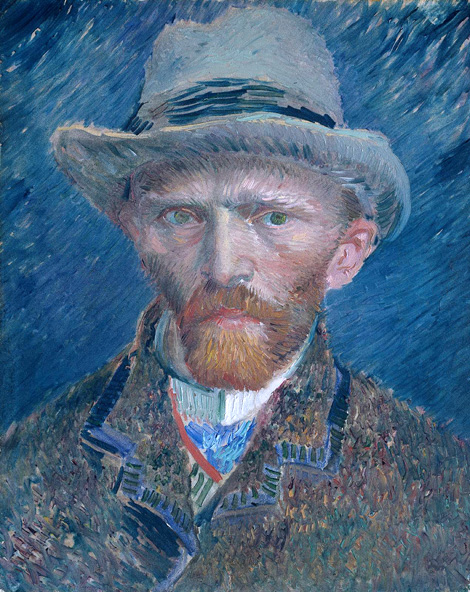
Self-Portrait: 1887
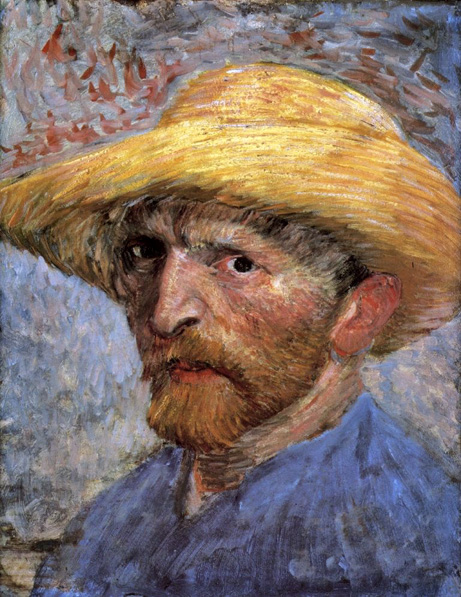
Self-Portrait: 1887
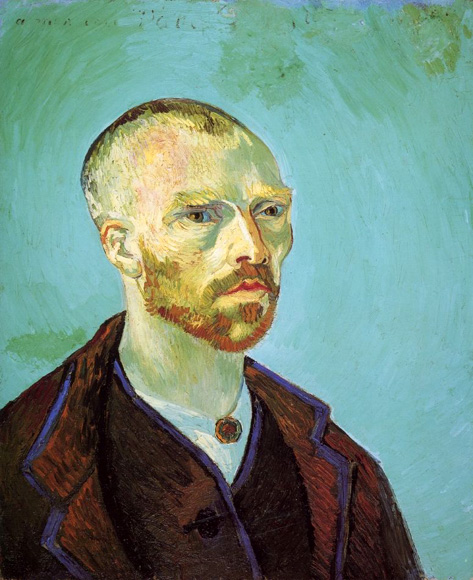
Self-Portrait: 1888
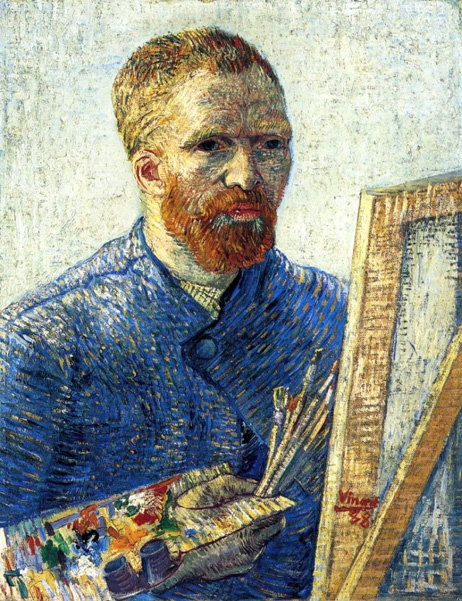
Self-Portrait as a Painter: 1888
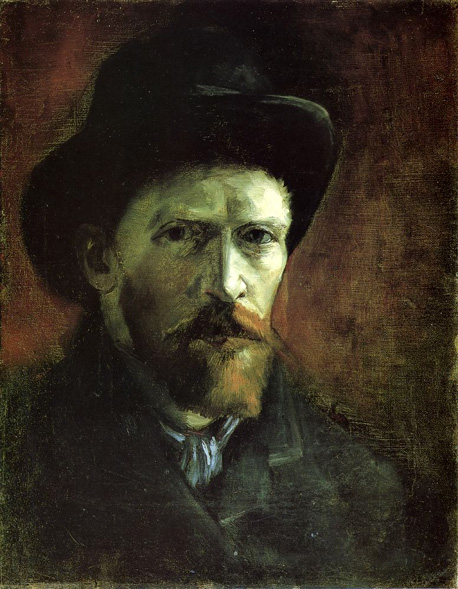
Self-Portrait in a Dark Felt Hat: 1886

Self-Portrait with a Felt Hat: 1888

Self-Portrait with Bandaged Ear and Pipe: 1889

Self-Portrait: 1887

Self-Portrait: 1887

Self-Portrait: 1887
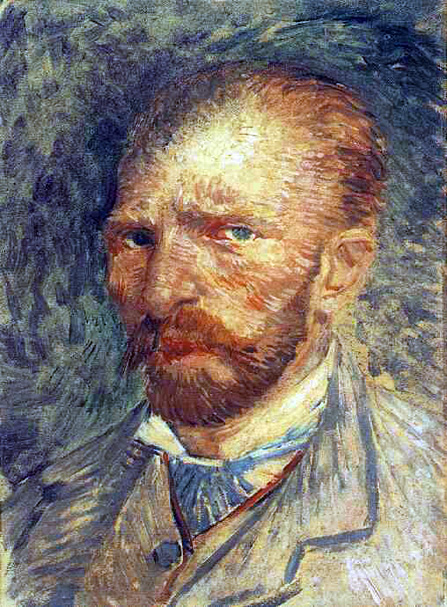
Self-Portrait: 1887
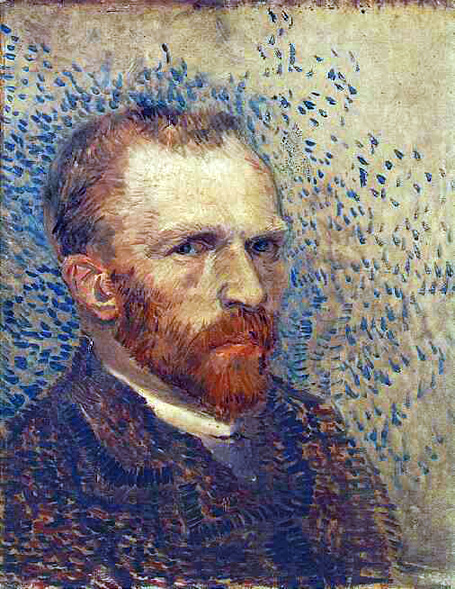
Self-Portrait: 1887
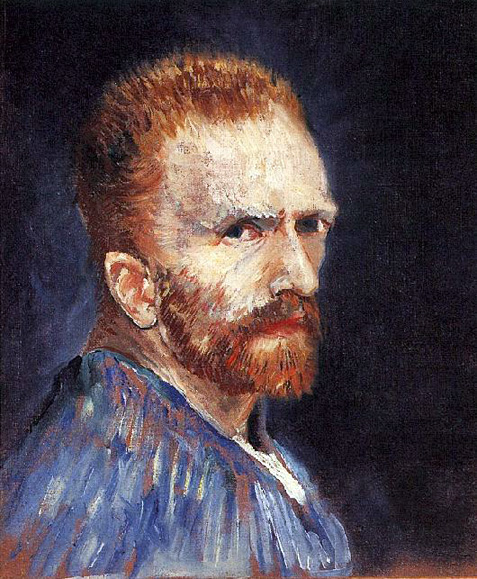
Self-Portrait: 1887
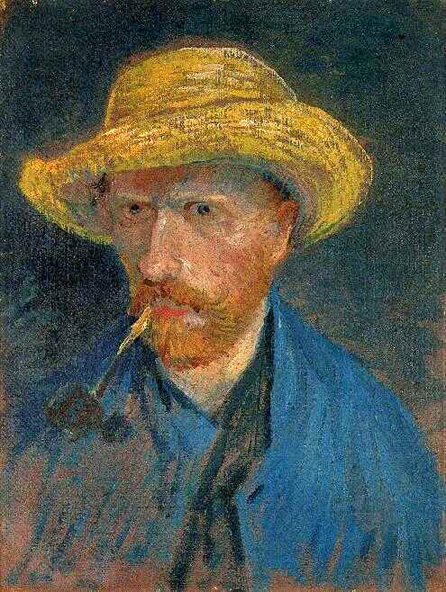
Self-Portrait: 1887
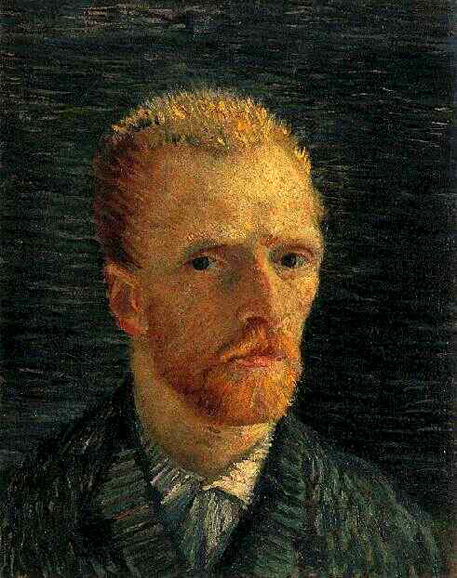
Self-Portrait: 1887
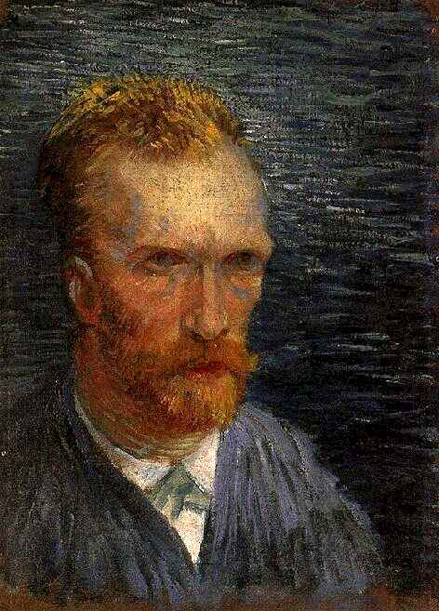
Self-Portrait: 1887
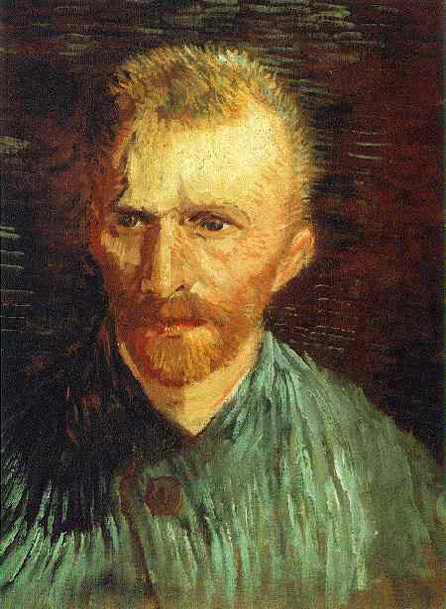
Self-Portrait: 1887
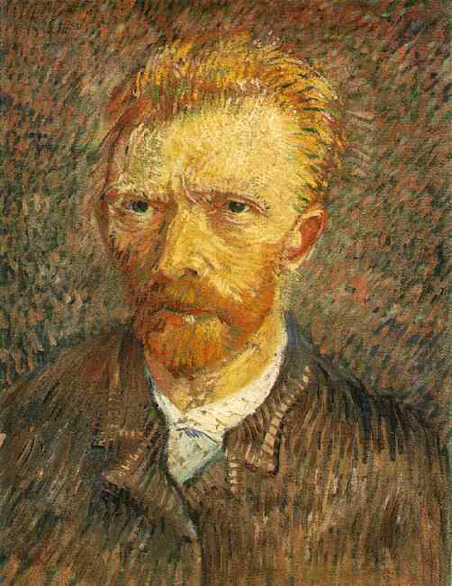
Self-Portrait: 1888

Self-Portrait: 1888
Flowering Orchards
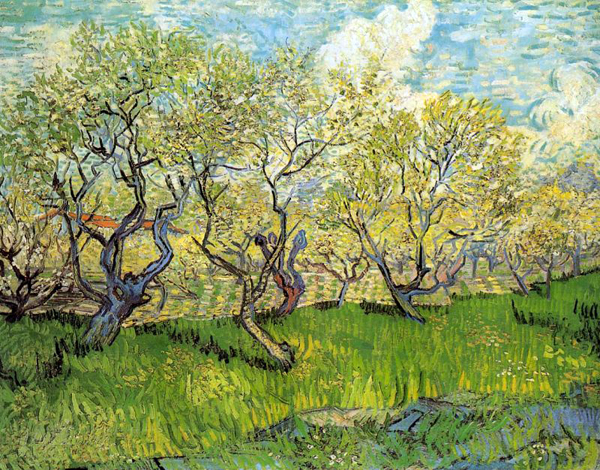
Orchard in Bloom: 1888
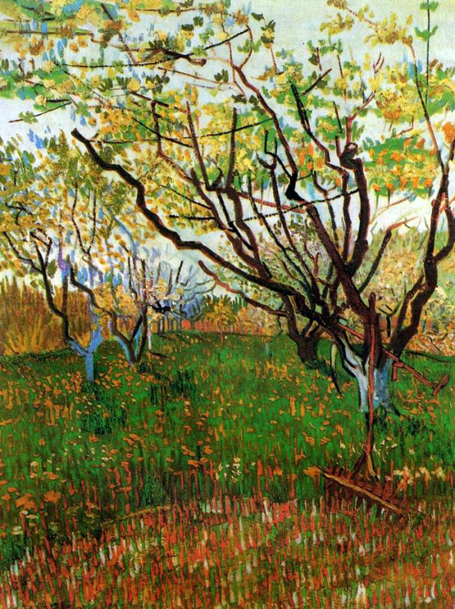
Orchard in Bloom: 1888
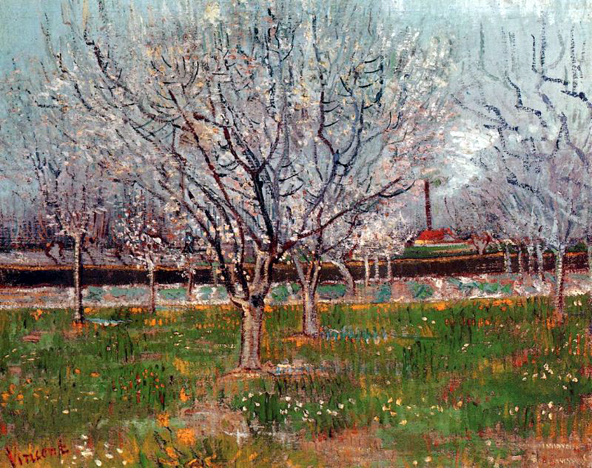
Orchard in Blossom: 1888
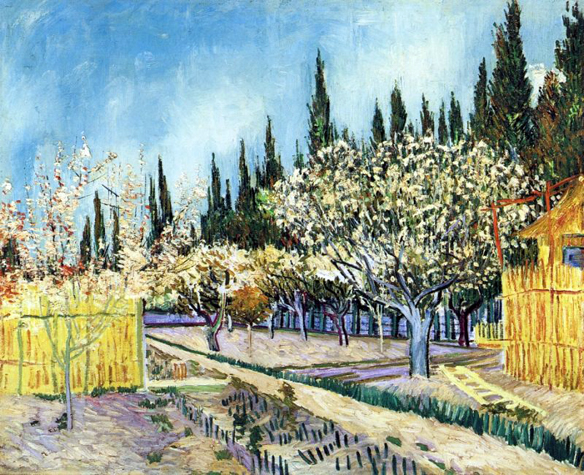
Orchard Surrounded by Cypresses: 1888
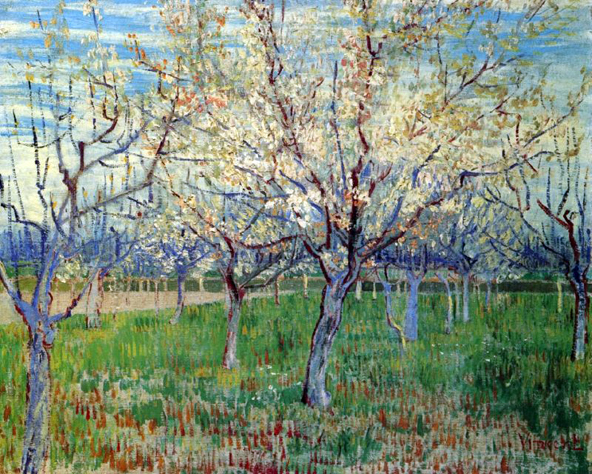
Orchard with Blossoming Apricot Trees: 1888

Orchard with Blossoming Plum Trees: 1888
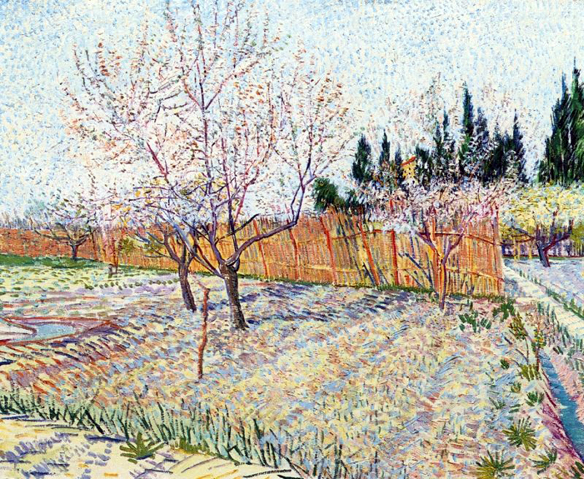
Orchard with Peach Trees in Blossom: 1888
The Roulin Family Series
Van Gogh and Joseph Roulin met and became good friends and drinking companions. Van Gogh compared Roulin to Socrates on many occasions; while Roulin was not the most attractive man, van Gogh found him to be "such a good soul and so wise and so full of feeling and so trustful." Strictly by appearance, Roulin reminded van Gogh of Russian novelist Fyodor Dostoyevsky - the same broad forehead, broad nose, and shape of the beard. Roulin saw van Gogh good and the most difficult times, corresponding with his brother, Theo following his rift with Gauguin and being at his side during and following the hospital stay in Arles.
Quoted From: The Roulin Family (Van Gogh Series) - Wikipedia

The Postman Joseph Roulin: 1888

The Postman Joseph Roulin: 1889
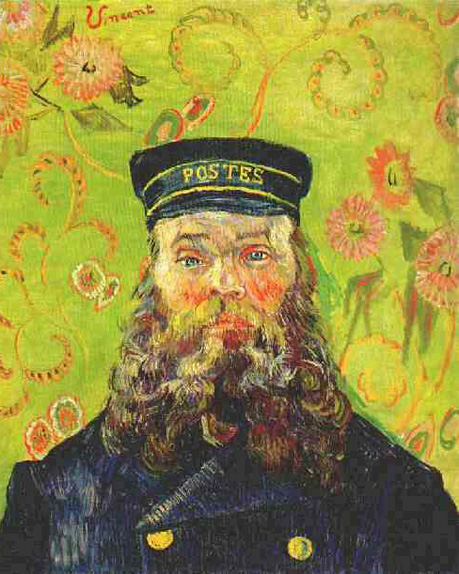
The Postman Joseph Roulin
Augustine Roulin was born on 9 October 1851 in Lambesc and died on 5 April 1930.
After her husband had posed for several works with van Gogh, Augustine sat for Van Gogh and Paul Gauguin in the Yellow House the two men shared. During the sitting, she kept her gaze on Gauguin, possibly for reassurance because, according to her daughter, she was not comfortable in the presence of van Gogh. She sat in the corner of the room for the evening sitting. Both men produce works.
Gauguin's reflect the light and shadow from the gas light fixture. The painting behind her back was a picture he recently completed entitled Blue Trees. He painted Augustine essentially as she was in size and appearance.
In comparison, Van Gogh's work appeared more quickly executed and more thickly painted than that of Gauguin's painting. Van Gogh admired the work of Dutch master Frans Halswhere with a single brush stroke he could paint a head, nose, eyes and mouth without need of retouching. The yellow brushstrokes on the side of her head depict the gaslight. Instead of depicting the evening mood, he painted pots of sprouting bulbs. Van Gogh made a connection to her earthy nature by the depiction of germinating bulbs, essentially declaring her a "human tuber." Days after working on this painting Van Gogh began painting the remaining Roulin family members, including the four-month-old baby, Marcelle.
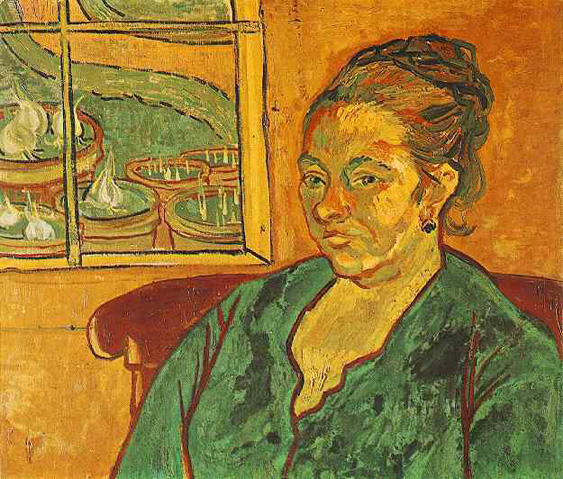
Portrait of Madame Augustine Roulin: 1888

Madame Roulin
In addition to the mother-daughter works where Marcelle is visible, Van Gogh also created several La Berceuse works where Augustine rocked her unseen cradle by a string. Van Gogh labeled the group of work La Berceuse meaning "our lullaby or the woman rocking the cradle." The color and setting was intended to set the scene of a lullaby, meant to give comfort to "lonely souls." Van Gogh imagined the painting in several types of settings, such as on an Icelandic fishing boat cabin walls -- or the center piece to two Sunflower paintings.

La Berceuse, Portrait of Madame Roulin: 1889
,_January_1889,_The_Metropolitan_Museum_of_Art,_New_York.jpg)
La Berceuse (Augustine Roulin), January 1889, The Metropolitan Museum of Art, New York
,_Museum_of_Fine_Arts,_Boston.jpg)
La Berceuse (Augustine Roulin), Museum of Fine Arts, Boston

La Berceuse 1889, Stedelijk Museum
Armand Roulin, the eldest son, was born on 5 May 1871 in Lambesc, and died on 14 November 1945. He was 17 years of age when portrayed by Van Gogh.
Van Gogh's works depict a serious young man who at the time the paintings were made had left his parent's home, working as a blacksmith's apprentice. The Museum Folkwang work depicts Armand in what are likely his best clothes: an elegant fedora, vivid yellow coat, black waistcoat and tie. Armand's manner seems a bit sad, or perhaps bored by sitting. His figure fills the picture plane giving the impression that he is a confident, masculine young man.
The second work, with his body slightly turned aside and his eyes looking down, appears to be a sad young man. Even the angle of the hat seems to indicate sadness.
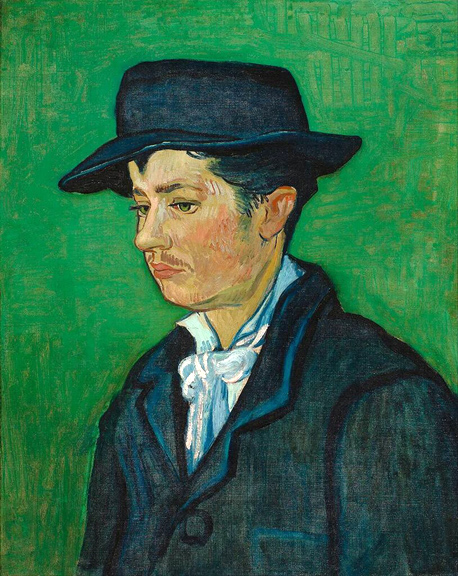
Portrait of Armand Roulin, 1888, Museum Boijmans Van Beuningen, Rotterda
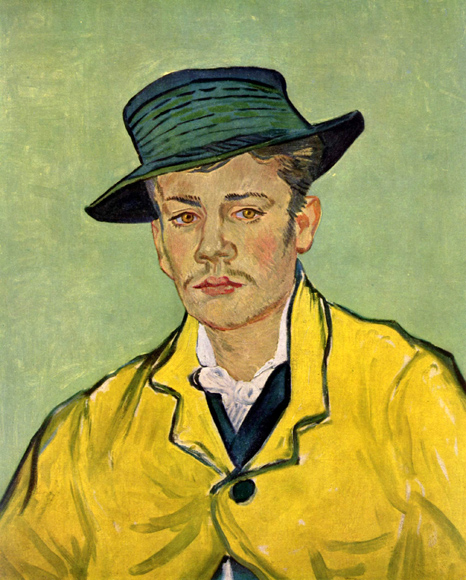
Portrait of Armand Roulin, 1888, Museum Folkwang, Essen
,_1888,_Private_Collection,_Zurich,_Switzerland.jpg)
Young Man with a Cap (Armand Roulin), 1888,Private Collection, Zürich, Switzerland
Camille Roulin, the middle child, was born in Lambesc in southern France, on 10 July 1877, and died on 4 June 1922. When his portrait was painted, Camille was eleven years of age. The Van Gogh Museum painting shows Camille's head and shoulders. Yellow brush strokes behind him are evocative of the sun.
In The Schoolboy with Uniform Cap Camille seems to be staring off in space. His arm is over the back of a chair, mouth gaped open, possibly lost in thought. This was the larger of the two works made of Camille.
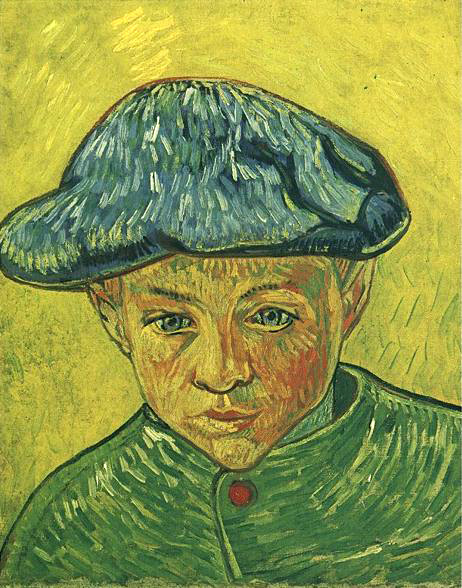
Portrait of Camille Roulin, 1888, Van Gogh Museum, Amsterdam, Netherlands

Portrait of Camille Roulin, 1888, Philadelphia Museum of Art, Philadelphia, Pennsylvania

The Schoolboy with Uniform Cap (Camille Roulin), early December, 1888, Museu de Arte de Sao Paulo, Sao Paulo, Brazil
Marcelle Roulin, the youngest child (31 July 1888 - 22 February 1980) was four months old, when Van Gogh made her portraits. She was painted three times by herself and twice on her mother's lap. The three works show the same head and shoulders image of Marcelle with her chubby cheeks and arms against a green background.
When Johanna van Gogh, pregnant at the time, saw the painting, she wrote: "I like to imagine that ours will be just as strong, just as beautiful - and that his uncle will one day paint his portrait!" A version titled Roulin's Baby resides at the National Gallery of Art in Washington, D.C.
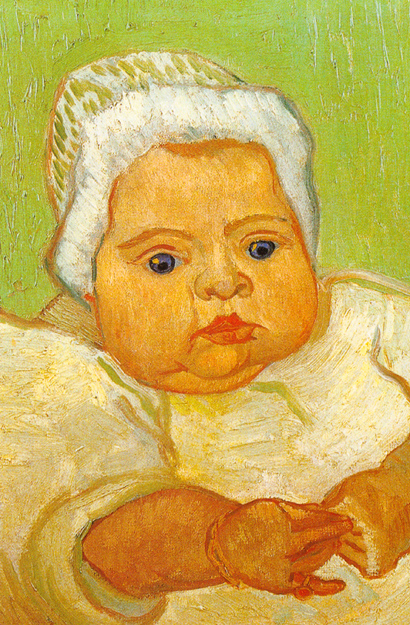
Portrait of Marcelle Roulin, 1888, Van Gogh Museum, Amsterdam, Netherland
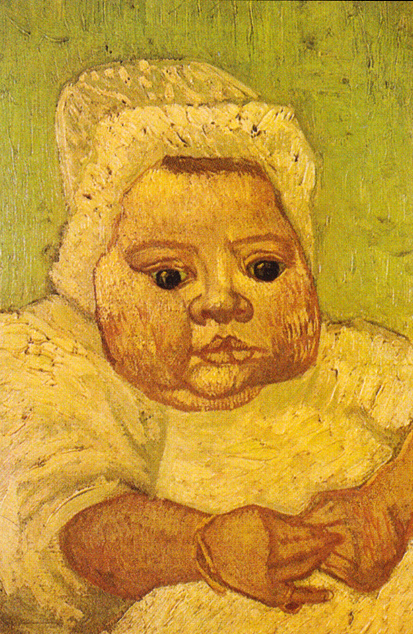
Portrait of Marcelle Roulin, 1888, Fondation Socindec, Vaduz, Liechtenstein
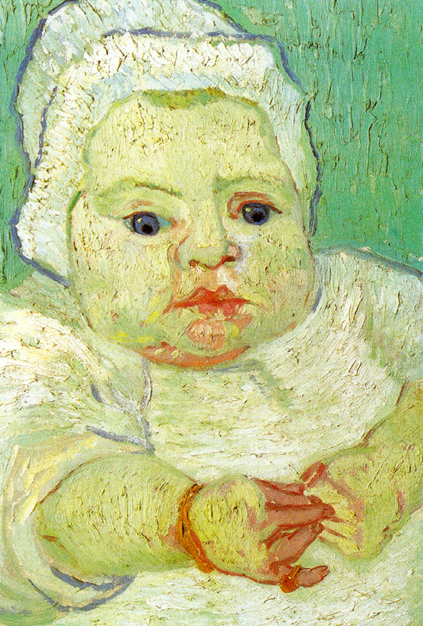
Roulin's Baby, 1888, National Gallery of Art, Washington, D.C.
Vincent van Gogh's Décoration for the Yellow House

The Décoration for the Yellow House was the main project Vincent van Gogh focused on in Arles, from August 1888 until his breakdown the day before Christmas. This Décoration had no pre-defined form or size; the central idea of the Décoration grew step by step, with the progress of his work. Starting with the Sunflowers, portraits were included in the next step. Finally, mid-September 1888, the idea took shape: from this time on he concentrated on size 30 canvases (Toiles de 30), which were all meant to form part of this Décoration.
Quoted From: Vincent van Gogh's Décoration for the Yellow House - Wikipedia
There will be some repetition from earlier portions of this page but I wanted to show the Yellow House as van Gogh and Gauguin experienced.
~ Senex Magister
First Idea: The Sunflowers, August 1888
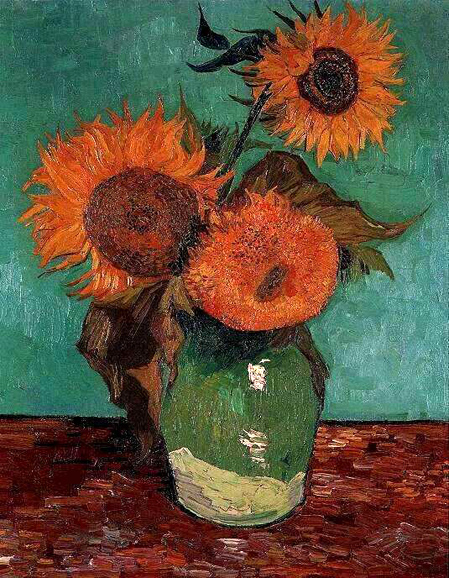
Vase with three sunflowers(Arles, August 1888)Private Collection
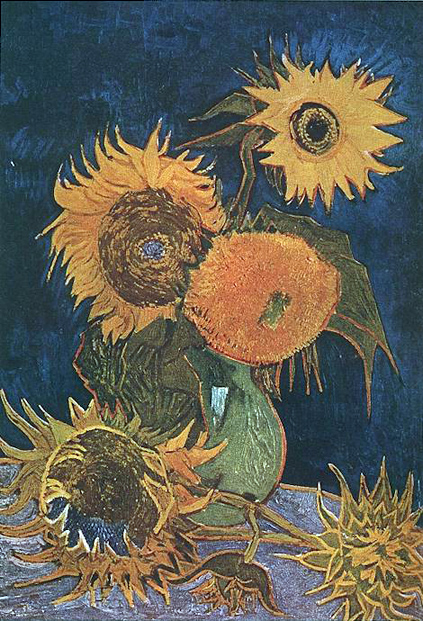
Vase with Five Sunflowers (Arles, August 1888) Private collection, Japan, destroyed by fire in World War II on 6 August 1945

Vase with Twelve Sunflowers (Arles, August 1888) Neue Pinakothek, Munich

Vase with Fifteen Sunflowers (Arles, August 1888) National Gallery, London
Second Step: The Portraits, September - October 1888
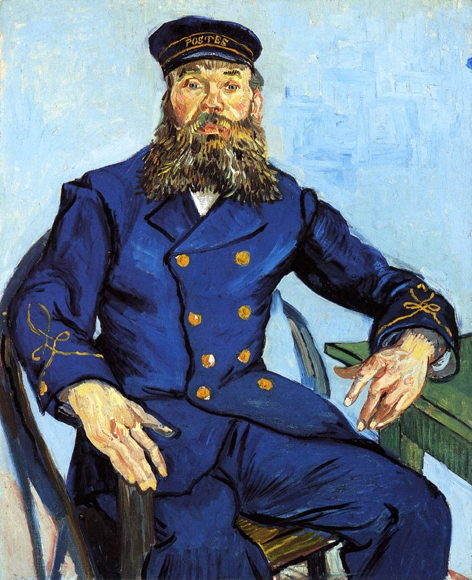
Joseph Roulin (The Postmaster) Museum of Fine Arts, Boston
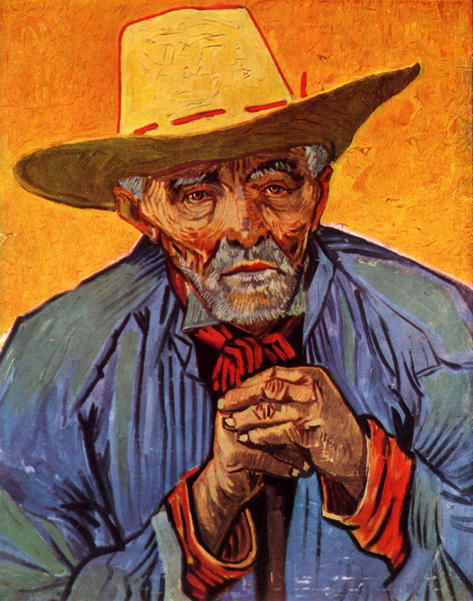
Patience Escalier (The Old Peasant) Private Collection

Eugène Boch (The Poet) Musée d'Orsay, Paris

Paul-Eugène Milliet (The Lover) Kröller-Müller Museum, Otterlo
Third Step and Definite Solution: The Toiles de 30-Décoration, October - December 1888

The Night Café (September 1888) Yale University Art Gallery
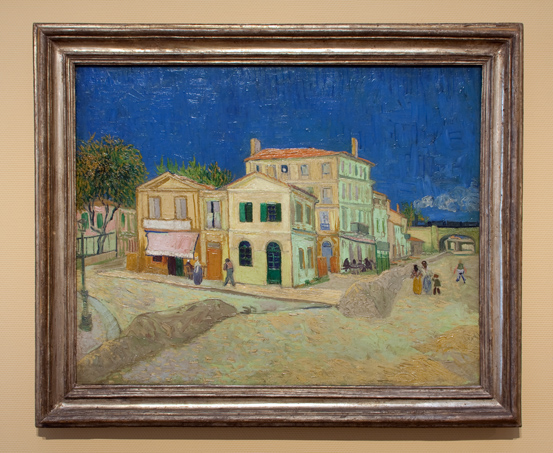
The Yellow House (September 1888) Van Gogh Museum, Amsterdam

Starry Night Over the Rhone (September 1888) Musée d'Orsay, Paris
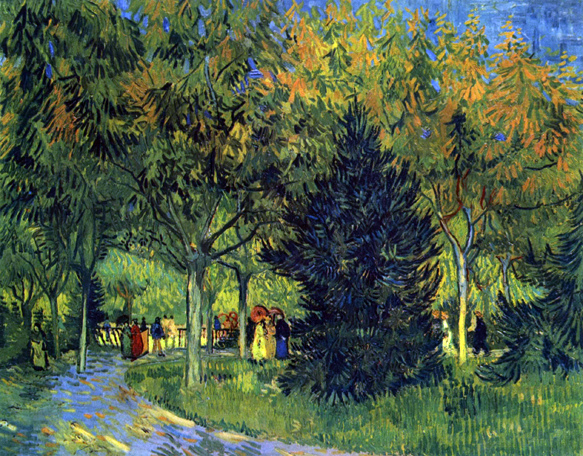
Public Garden Kröller-Müller Museum, Otterlo
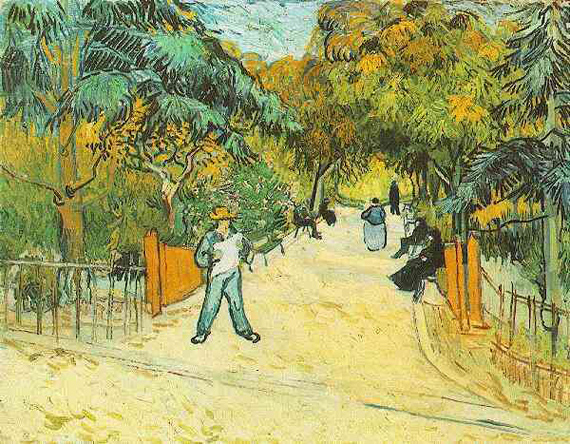
Public Garden Phillips Collection, Washington D.C.
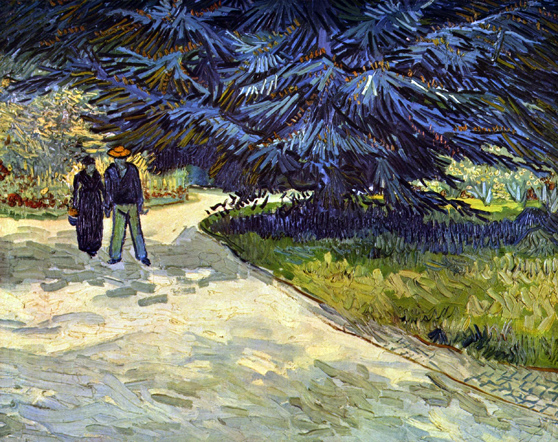
Garden of the Poet III (October 1888) Private Collection

Railway Bridge (October 1888) Private Collection
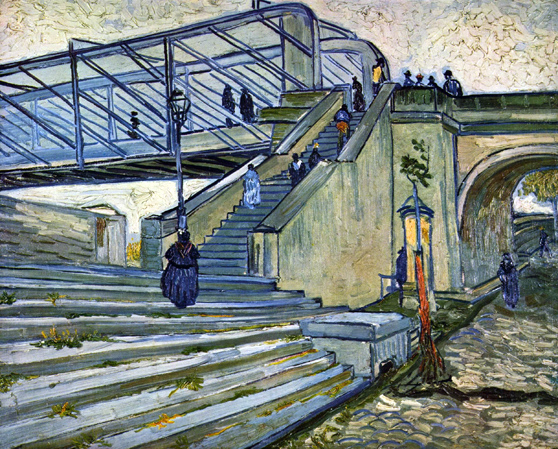
Trinquetaille Bridge (October 1888) Private Collection

Bedroom in Arles (October 1888) Van Gogh Museum, Amsterdam
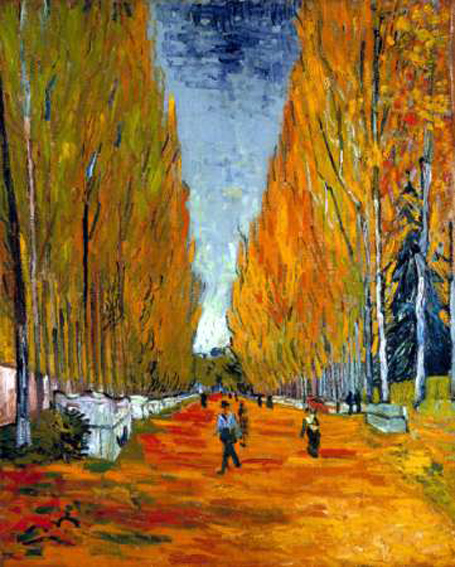
Les Alyscamps (October 1888) Private Collection

The Red Vineyard (November 1888) sold to Anna Boch Moscow

Vincent's Chair (November 1888) National Gallery, London

Gauguin's Armchair (November 1888) Van Gogh Museum, Amsterdam
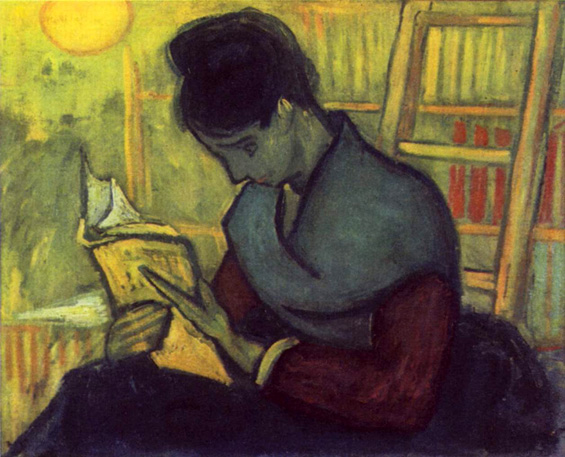
In the Library (November 1888) Private Collection
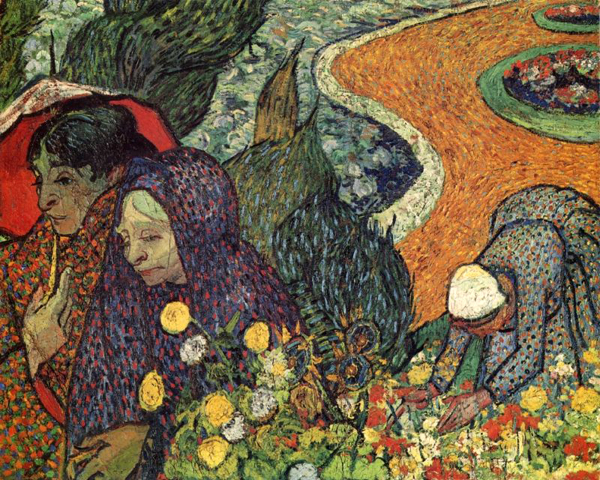
Souvenir du jardin (November 1888) Hermitage Museum, St. Petersburg
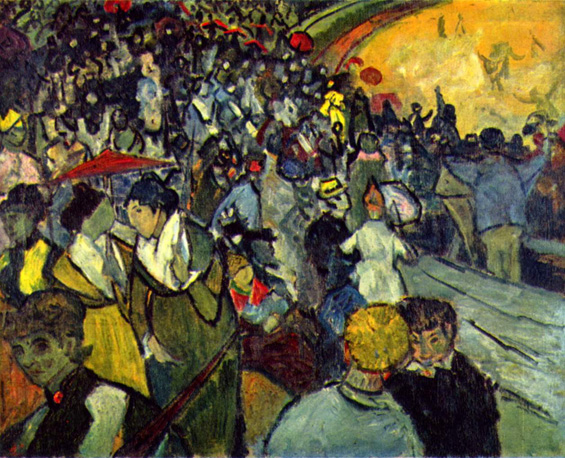
Les Arènes (December 1888) Hermitage Museum, St. Petersburg

L'Arlésienne (November 1888) Musée d'Orsay, Paris
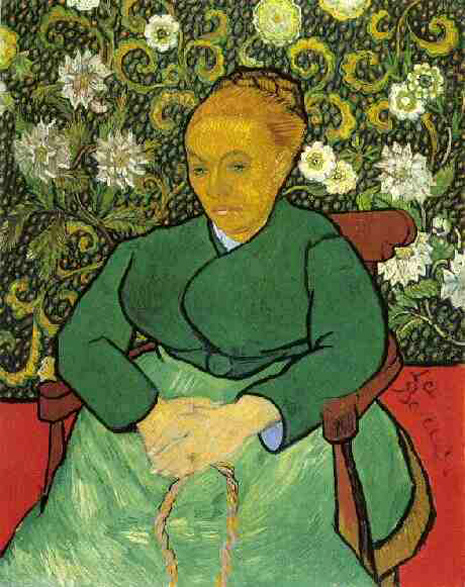
La Berceuse (December 1888) Kröller-Müller Museum, Otterlo
Epilogue: The Toiles de 30, January - April 1889
Repetitions

Vase with twelve flowers (Arles, January 1889) Philadelphia Museum of Art, Philadelphia
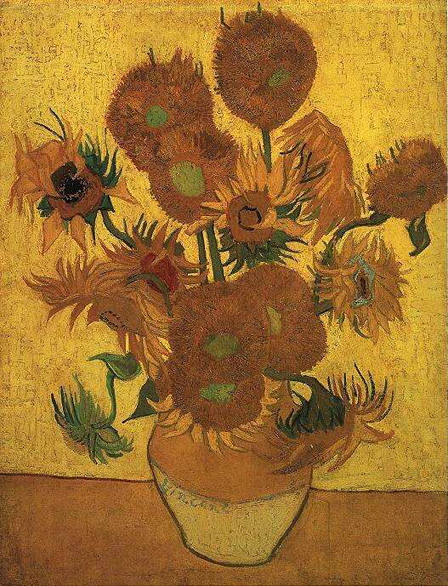
Vase with Fifteen Sunflowers (Arles, January, 1889) Van Gogh Museum, Amsterdam
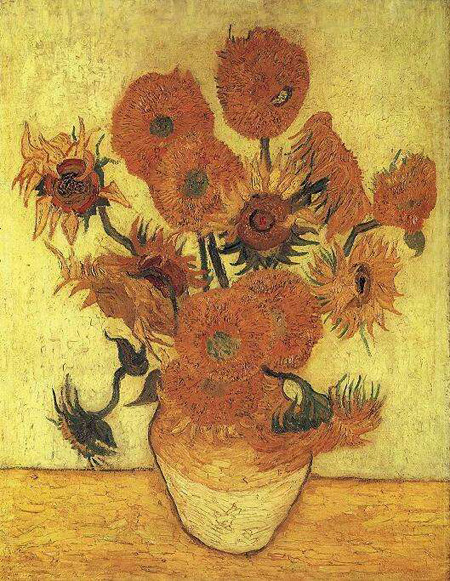
Vase with Fifteen Sunflowers (Arles, January 1889) Sompo Japan Museum of Art, Tokyo
,_Museum_of_Fine_Arts,_Boston.jpg)
La Berceuse - Museum of Fine Arts, Boston

L'Arlésienne Metropolitan Museum of Art, New York
Spring Subjects
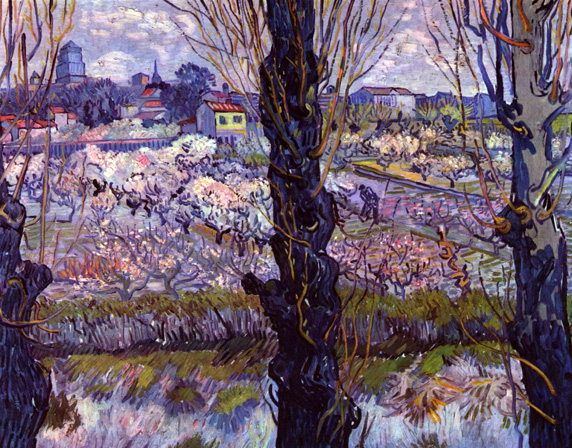
View of Arles, Flowering Orchards, Spring 1889 Neue Pinakothek, Munich
Art historian Albert Boime believes that van Gogh-even in seemingly fantastical compositions like Starry Night-based his work in reality. The White House at Night shows a house at twilight with a prominent star surrounded by a yellow halo in the sky. Astronomers at Southwest Texas State University in San Marcos calculated that the star is Venus, which was bright in the evening sky in June 1890 when Van Gogh is believed to have painted the picture.
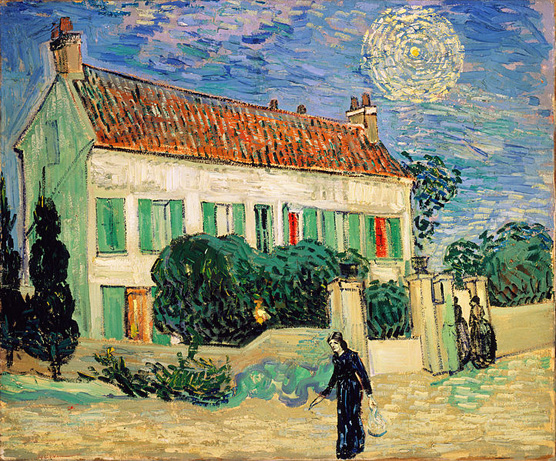
The White House at Night: 1890
Quoted From: Vincent van Gogh, Wikipedia
Various Painting of Vincent van Gogh
A Digger: 1881
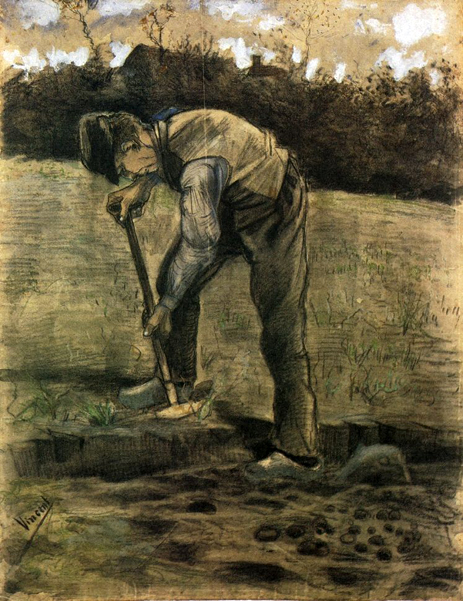
A Girl in White in the Woods: 1882
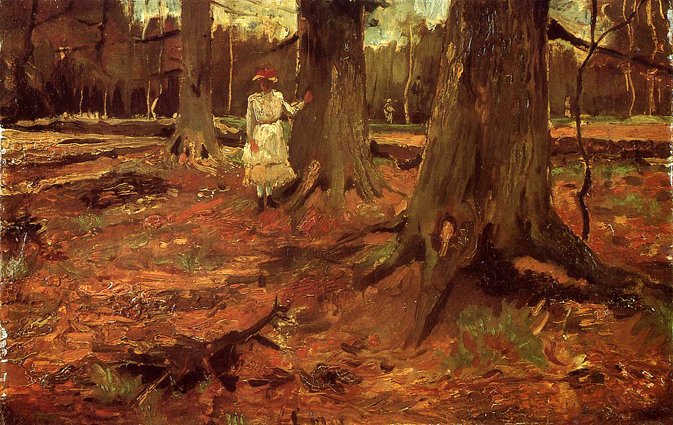
Of a study that Van Gogh made for Girl in a Wood or Girl in White in the Woods, he remarked at how much he enjoyed the work and explains how he wishes to trigger the audience's senses and how they may experience the painting: "The other study in the wood is of some large green beech trunks on a stretch of ground covered with dry sticks, and the little figure of a girl in white. There was the great difficulty of keeping it clear, and of getting space between the trunks standing at different distances - and the place and relative bulk of those trunks change with the perspective - to make it so that one can breathe and walk around in it, and to make you smell the fragrance of the wood".
Quoted From: Girl in White in the Woods - Wikipedia
A Girl Raking: 1881
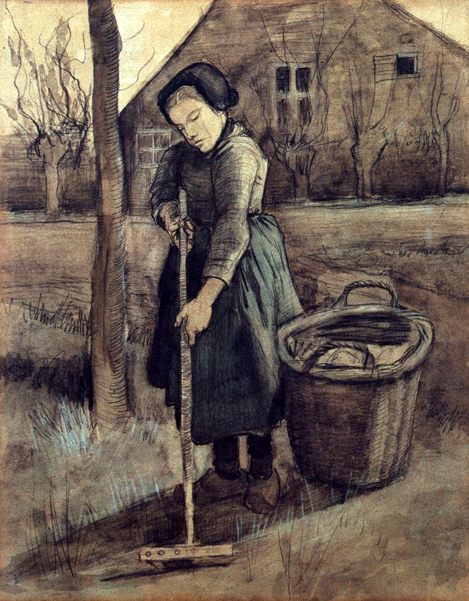
A Group of Cottages: 1890
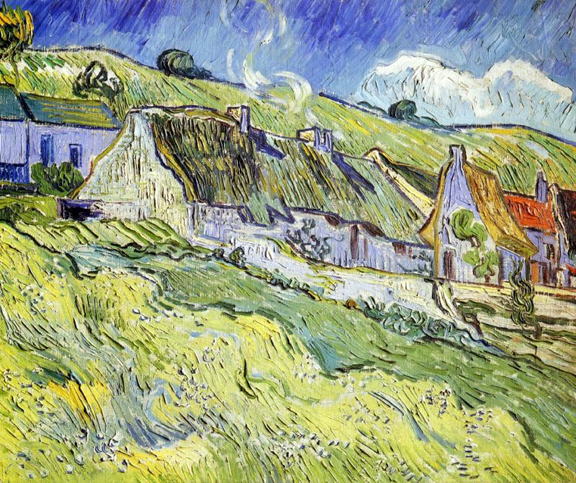
A Man with a Broom: 1881
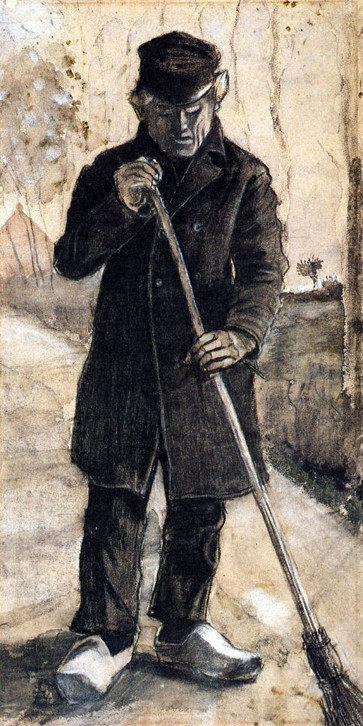
A Marsh: 1881
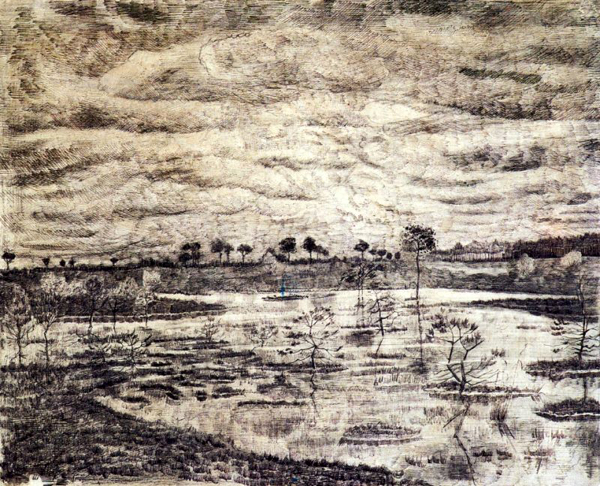
A Pair of Shoes: 1886
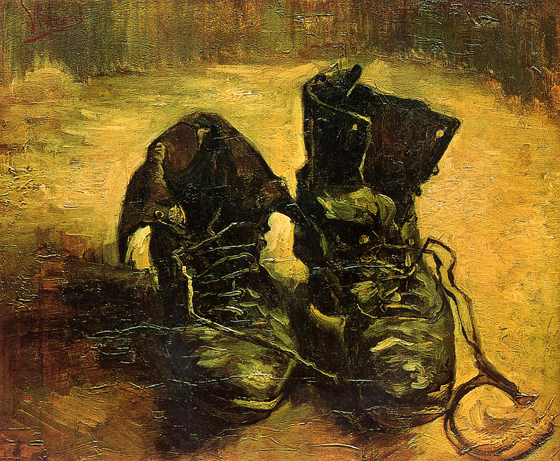
This painting of a pair of down-at-heel shoes prompts speculation on a variety of psychological questions. They have been seen as symbolizing Van Gogh's difficult passage through life.
A fellow student in Paris reported that Vincent bought these workman's boots at a flea market, intending to use them in a still life. Finding them still a little too smart, however, he wore them on a long and rainy walk. Only then were they fit to be painted.
Van Gogh made a number of still lives with old shoes. To him, as to several of his contemporaries, they may have been symbolic of the hard yet picturesque life of the laborer.
Quoted From: Van Gogh Museum - A Pair of Shoes
A Pair of Shoes: 1887
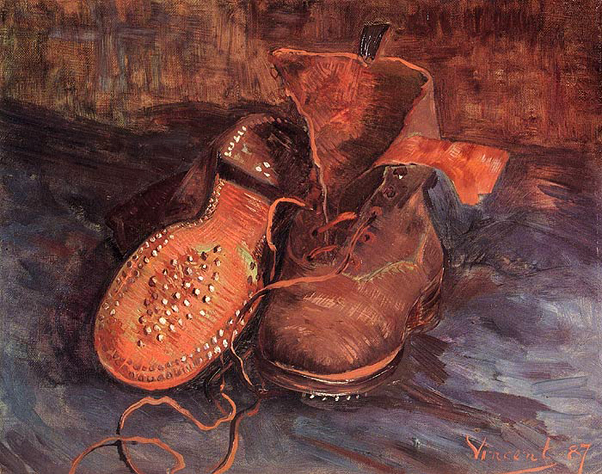
A Path Through a Ravine: 1889
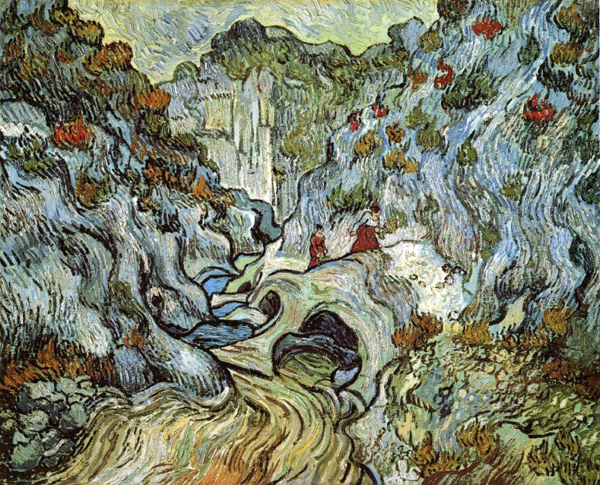
Agostina Sagatori Sitting in the Cafe du Tambourin: 1887
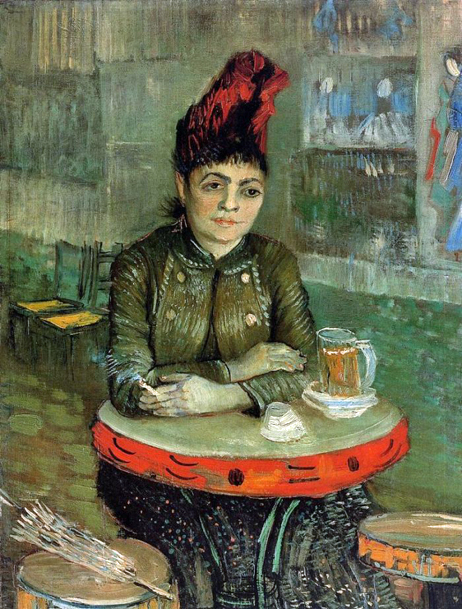
Agostina Segatori Sitting in the Café du Tambourin was painted by Vincent van Gogh in 1887. Agostina Segatori owned the café that Van Gogh knew intimately. It was a gathering spot for Parisian artists, a place where their work was exhibited. Van Gogh, unable to pay in cash for his meals, exchanged paintings for meals. The paintings then adorned the restaurant. He held a special exhibit of his Japanese prints in the café as well. His connection with Agostina and the cafe came to a sad end when she went bankrupt and Van Gogh's paintings were confiscated by creditors. This painting, however, demonstrates an artistic discovery that culminated in his unique, creative style not quite on the brink of being understood and revered.
Quoted From: Agostina Segatori Sitting in the Café du Tambourin - Wikipedia
An Old Man Putting Dry Rice on the Hearth: 1881
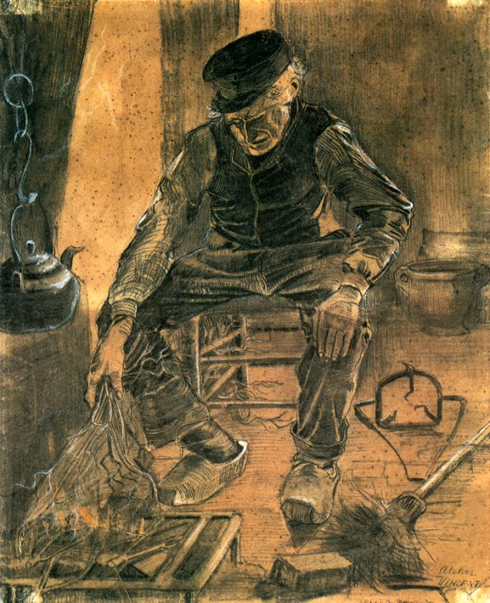
Apricot Tree in Bloom: 1888
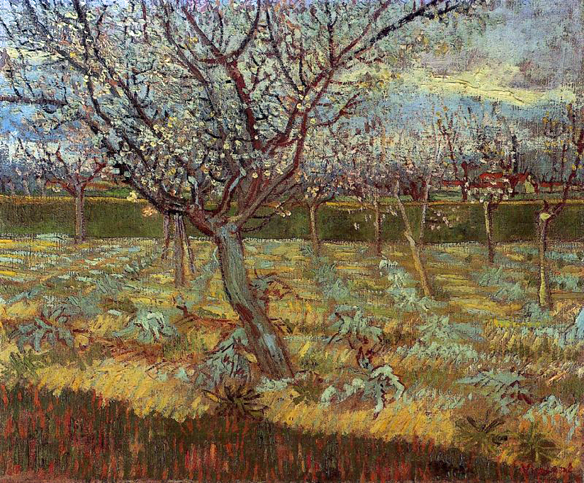
Autumn Landscape: 1885
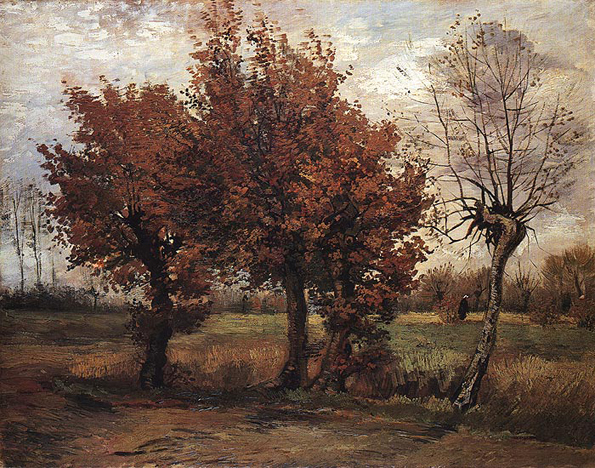
Autumn Landscape: 1885

Avenue of Plane Trees near Arles Station: 1888
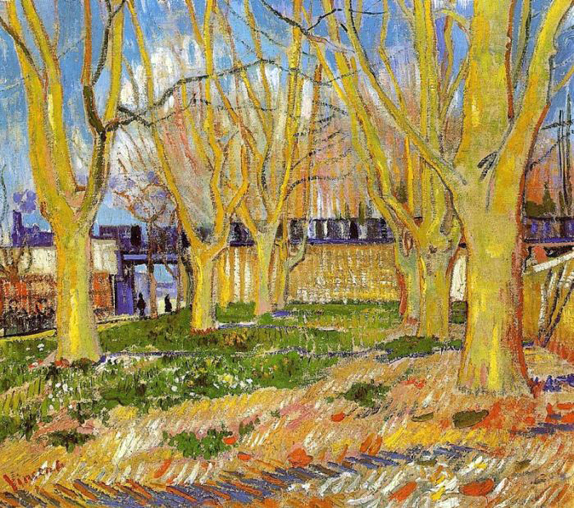
Avenue of Poplars at Sunset: 1884
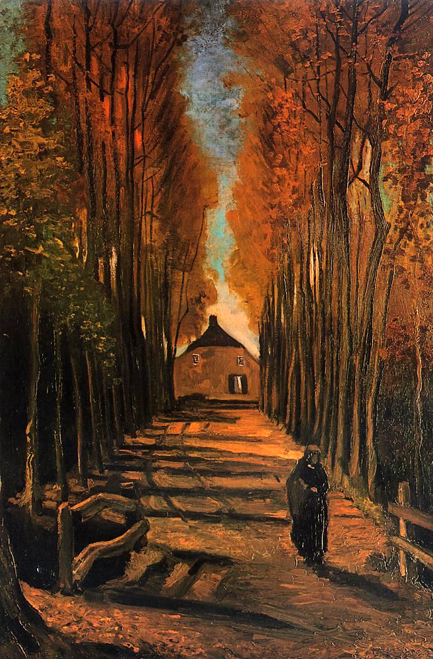
Avenue with Flowering Chestnut Trees: 1889
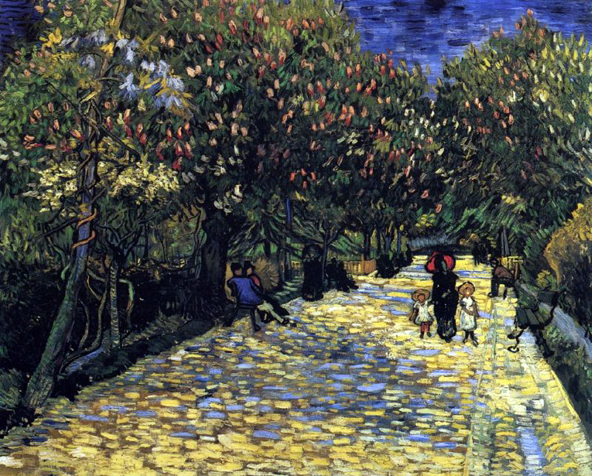
Backyards of Old Houses in Antwerp in the Snow: 1885
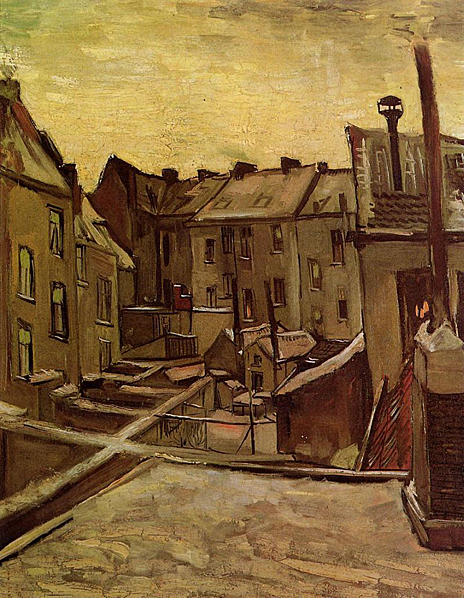
Barn with Moss Covered Roof: 1881
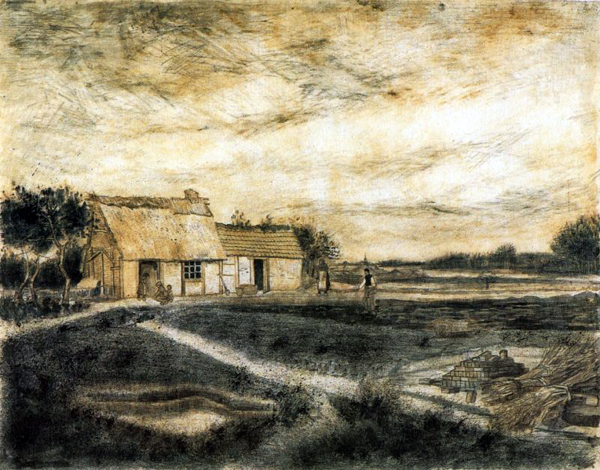
Basket of Carnations and Zinnias: 1886
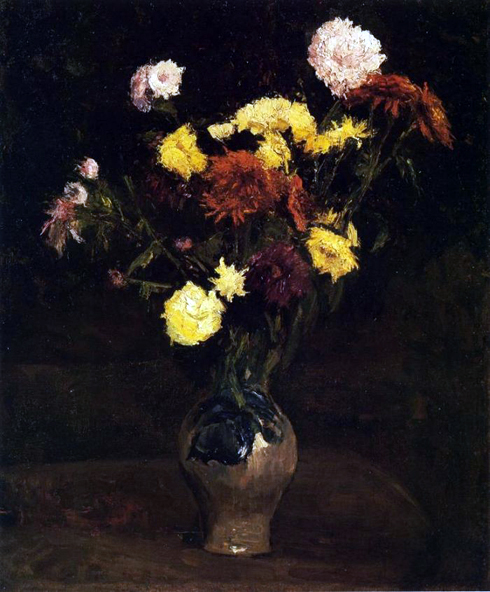
Beach at Scheveningen in Stormy Weather: 1882
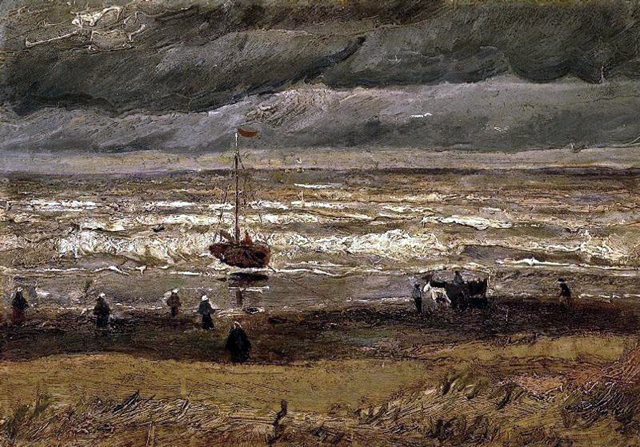
Bowl with Peonies and Roses: 1886
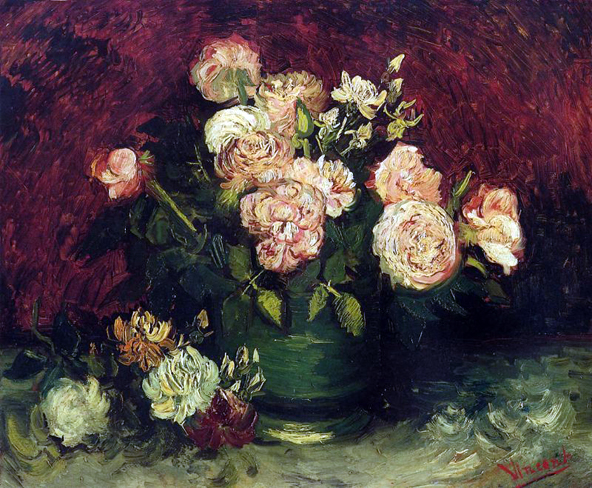
Branches with Almond Blossom: 1890

Almond Blossoms is a group of several paintings made in 1888 and 1890 by Vincent van Gogh in Arles and Saint-Rémy, southern France of blossoming almond trees. Flowering trees were special to Van Gogh. They represented awakening and hope. He enjoyed them aesthetically and found joy in painting flowering trees. The works reflect Impressionist, Divisionist and Japanese woodcut influences. Almond Blossoms was made to celebrate the birth of his nephew and namesake, son of his brother Theo and sister-in-law Jo.
Quoted From: Almond Blossoms (Van Gogh series) - Wikipedia
Branches with Almond Blossoms
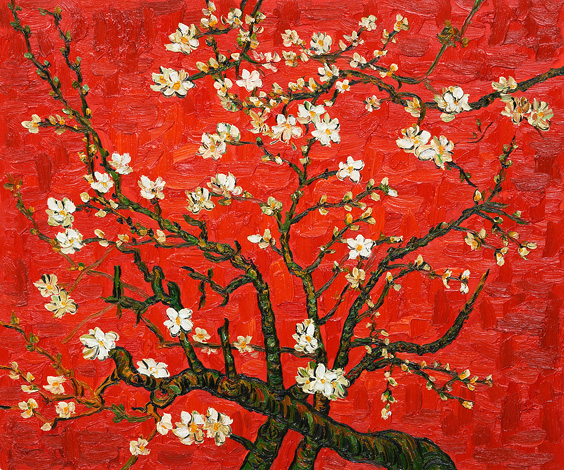
Bulb Fields: 1883
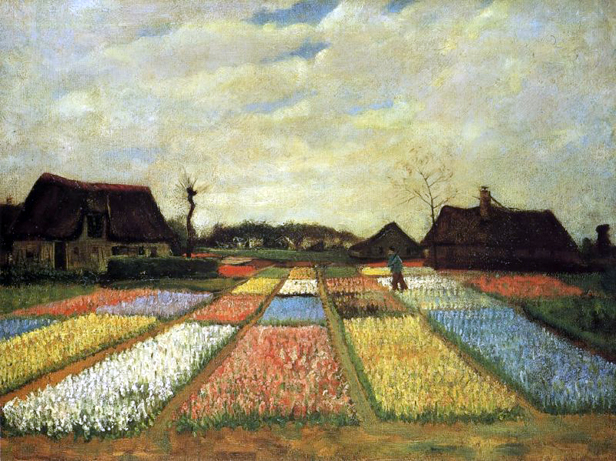
Carpenter's Workshop, Seen from the Artist's Studio: 1882
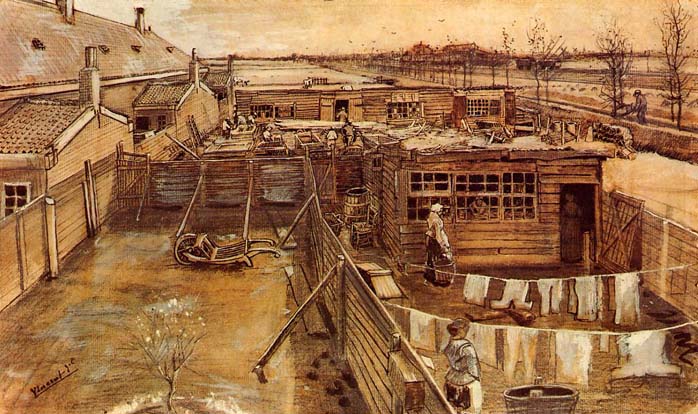
Chapel at Nuenen: 1884

Chestnut Tree in Bloom: 1887
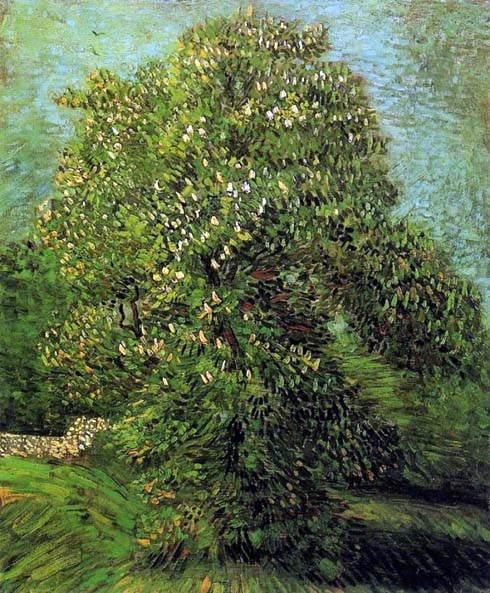
Coal Barges: 1890
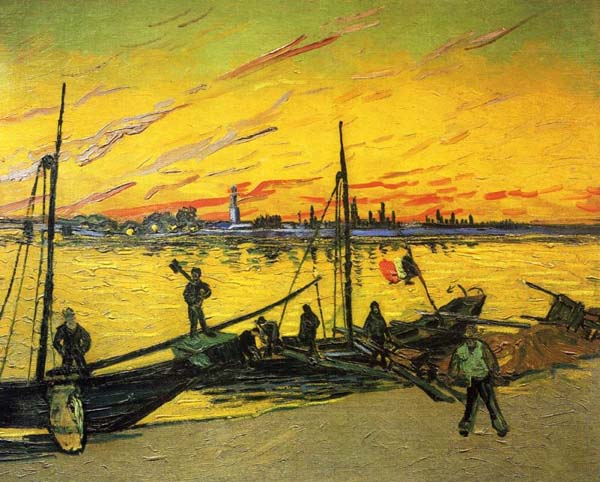
Cornfield with Cypresses: 1889
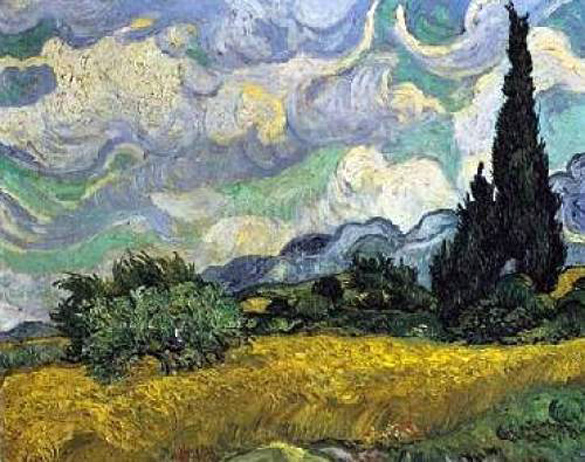
Vincent Van Gogh painted this landscape in 1889. He considered it one of his best landscape paintings because at that time he found interest only in cypresses. There were 3 very similar versions of this painting where the colour of the sky changed from blue to green based colours.
Quoted From: Similarities and Differences
Cottage and Woman with Goat: 1885
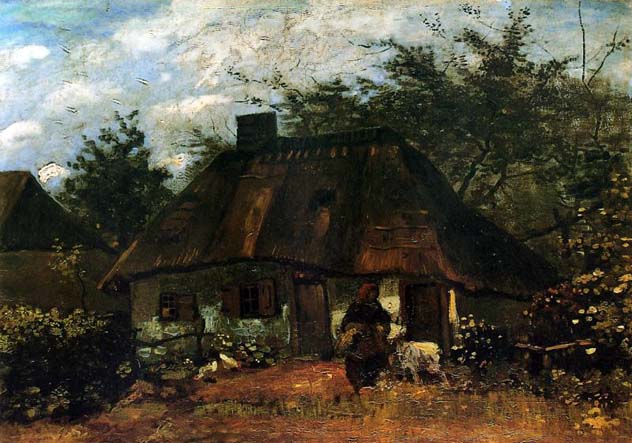
Cottage with Woman Digging: 1885
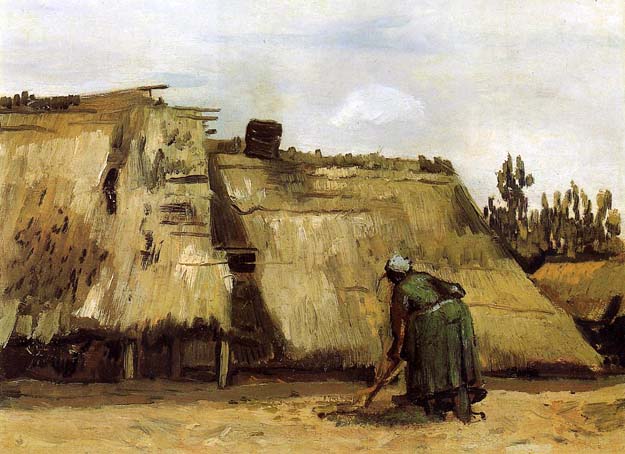
Country Churchyard and Old Church Tower: 1885

Drawbridge in Nieuw-Amsterdam: 1883
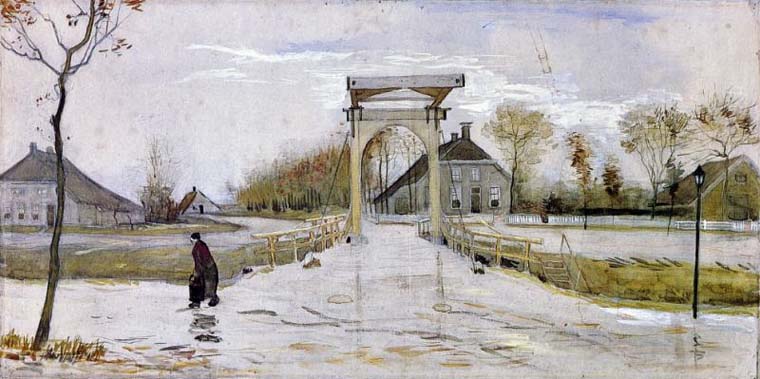
Dunes: 1882
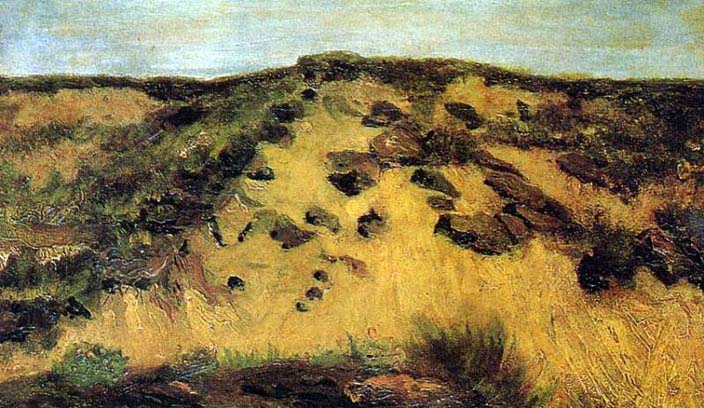
Edge of a Wood: 1882

Enclosed Field with Peasant: 1889
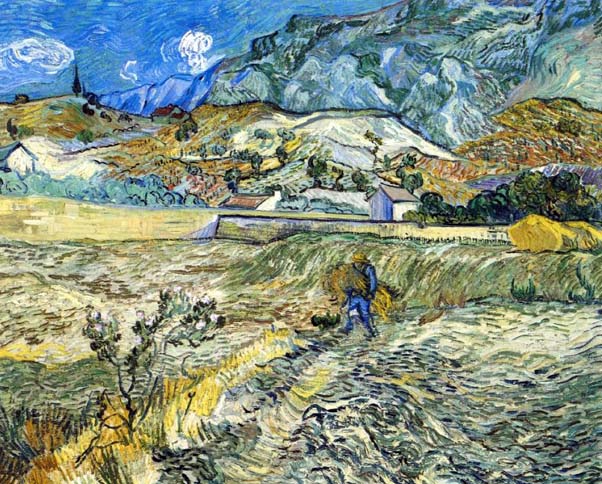
Enclosed Field with Peasant is an oil painting by Dutch artist Vincent Van Gogh, painted in October of 1889. It is currently part of the permanent collection at the Indianapolis Museum of Art.
Farmers Planting Potatoes: 1884
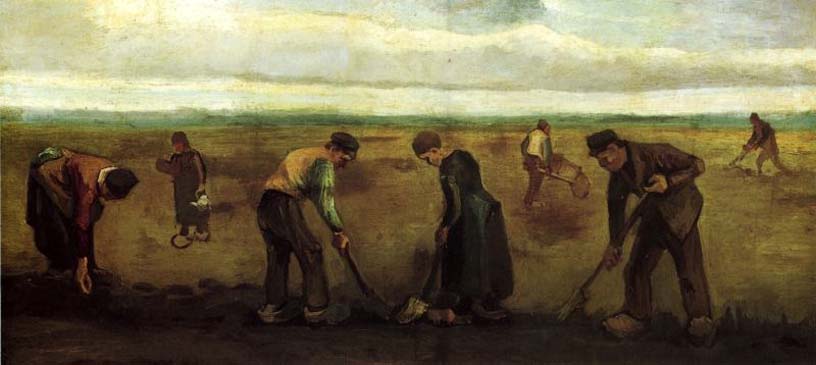
Farmhouse in a Wheat Field: 1888
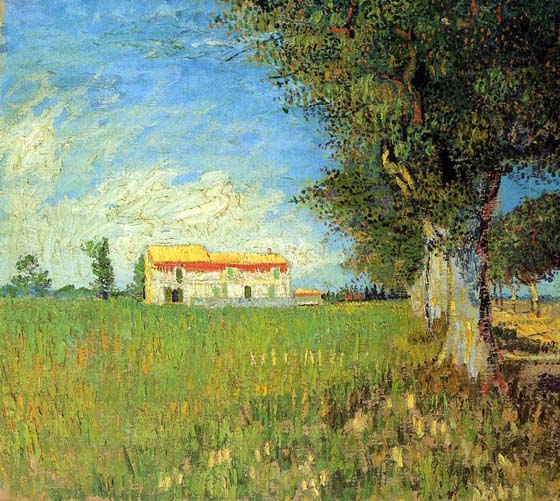
Farmhouse in Provence: 1888
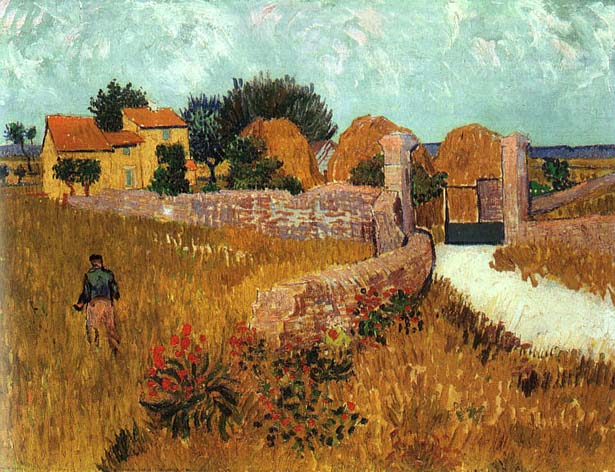
Farmhouse in Provence also known as Entrance Gate to a Farm with Haystacks was made in 1888 by Vincent van Gogh in Arles in Provence at the height of his career. Partially due to having been inspired by painter Adolphe Monticelli, Van Gogh sought the Provence region of France to further expand his painting skill and experience. Van Gogh used several pairs of complementary colors in the Farmhouse in Provence, the color contrast bringing an intensity to his work. The painting is owned by the National Gallery of Art of Washington, D.C.
Farmhouse with Peat Stacks: 1883

Farmhouses Among Trees: 1883
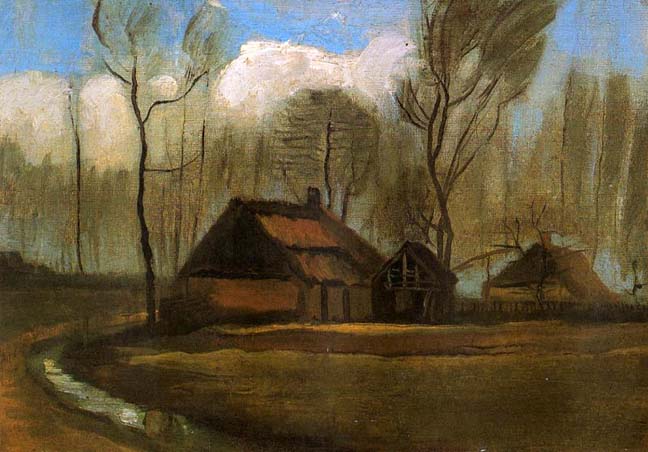
Farmhouses in Loosduinen near the Hague: 1883
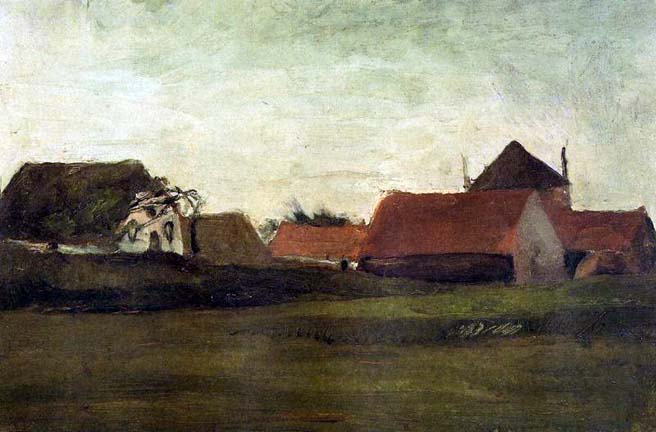
Field with Poppies: 1889

Field with Trees, the Chateau of Auvers: 1890
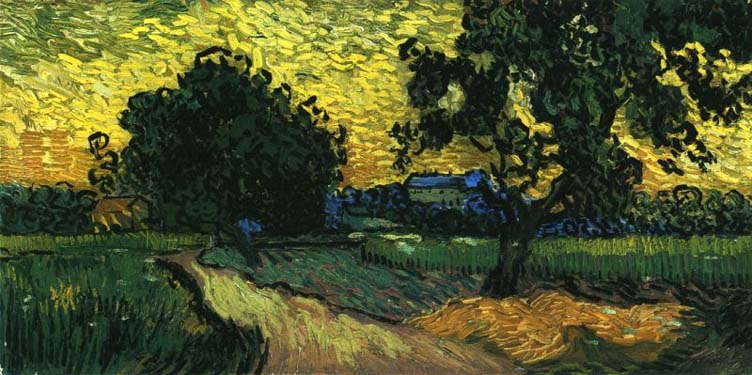
Fishing Boats at Sea: 1888
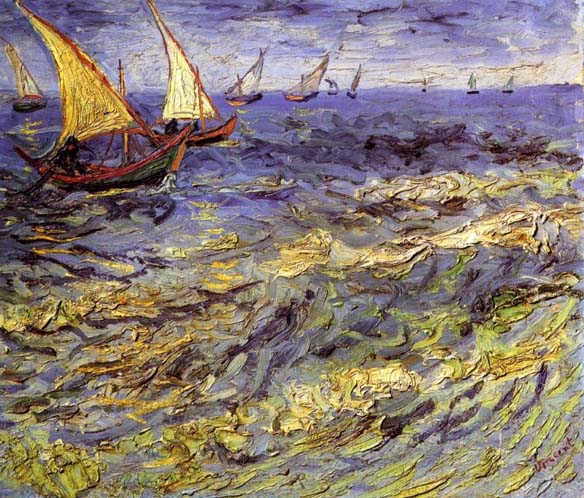
Fishing in the Spring, Pont de Clichy: 1887
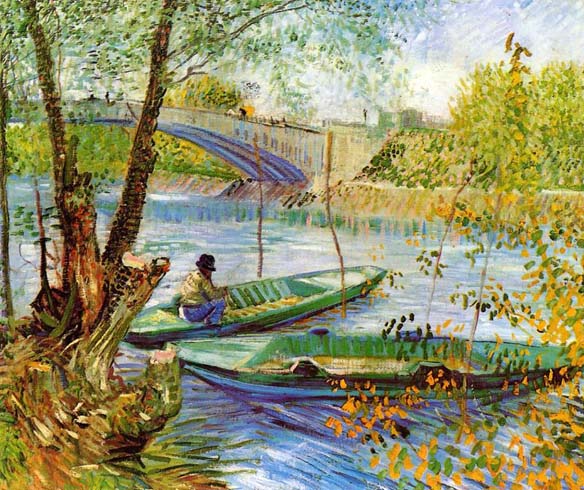
Seine (paintings) is the subject and location of paintings that Vincent van Gogh made in 1886 and 1887. The Seine has been an integral part of Parisian life for centuries for commerce, travel and entertainment. Here Van Gogh primarily captures the respite and relief from city life found in nature.
A few of the paintings were made in Paris and the rest in the northwestern suburbs of Paris in Clichy and Asnières. Through these works the audience can see a transition in Van Gogh's work from one of dark colors and serious themes to more joyous use of color and light and choice of themes.
In Holland Van Gogh was influenced by great Dutch masters as well as cousin-in-law Anton Mauve a Dutch realist painter who was a leading member of the Hague School. In Paris Van Gogh was exposed to and influenced by Impressionism, Symbolism, Pointillism, and Japanese woodblock print genres which were overtime integrated into his works. The spring of 1887 seemed to trigger an awakening within Van Gogh where he experimented with the genres to develop his personal style.
Quoted From: Seine (Van Gogh Series) - Wikipedia
Flowerpot with Chives: 1887
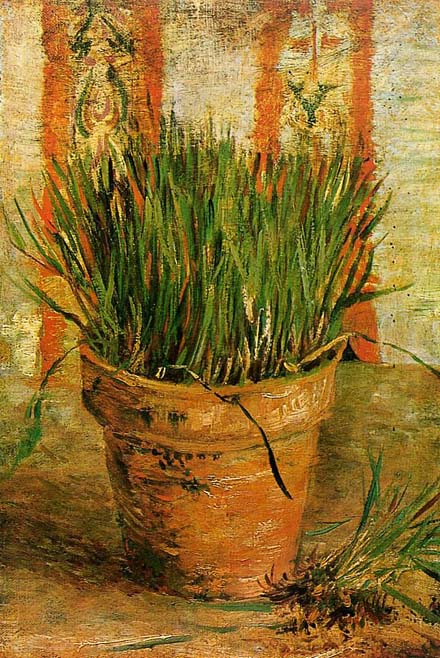
Flowers in a Vase: 1890

Four Peasants at a Meal: 1885
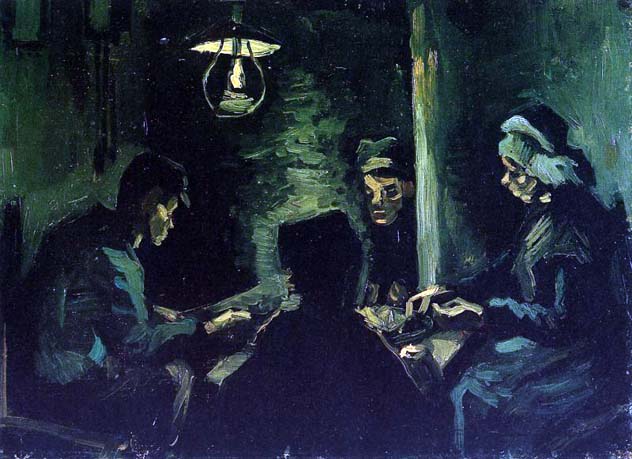
This canvas is the first study for The Potato Eaters. It includes only four figures round the table. The relaxed approach is emphasized by the sketchy brushwork.
Garden with Flowers: 1888
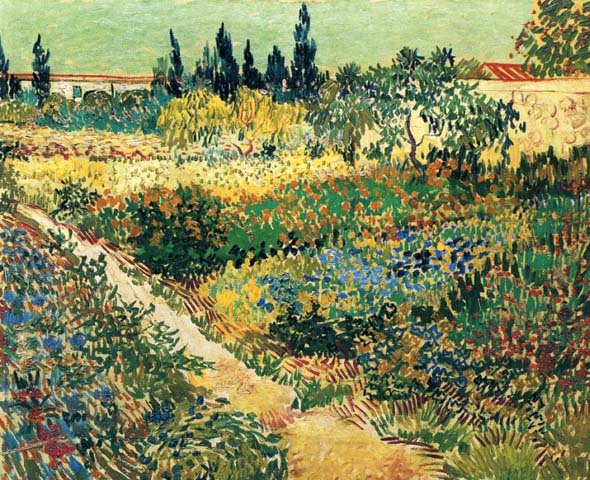
Garden_with_Weeping_Willow_1888
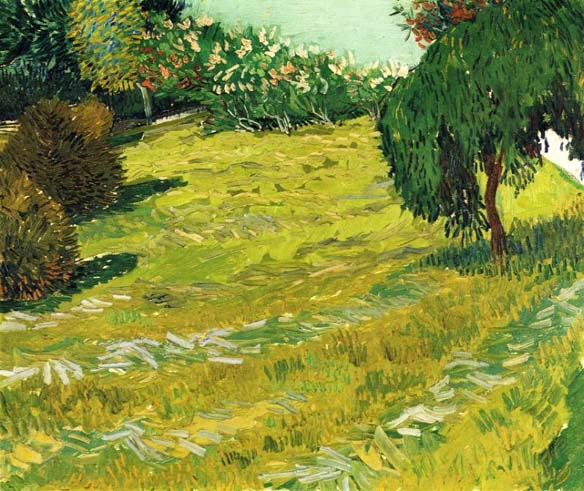
Girl in the Street: 1882
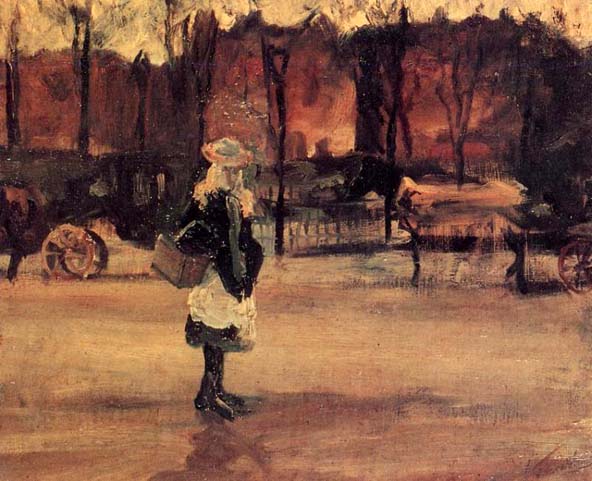
A Girl in the Street, Two Coaches in the Background is an oil painting created in 1882 by Vincent van Gogh is part of a private collection.
Girl in the Woods: 1882
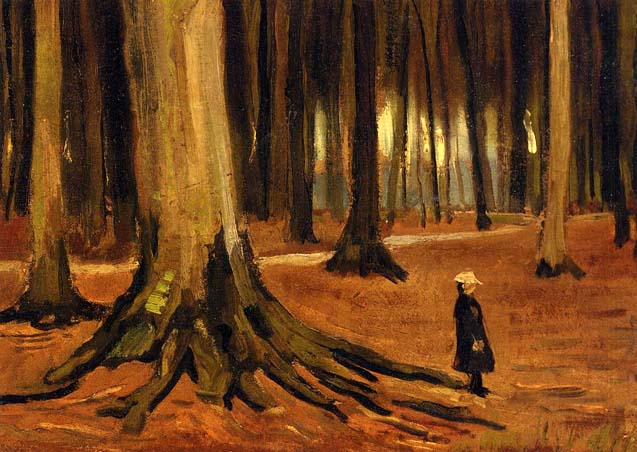
Girl in White in the Woods is an oil painting created in 1882 by Vincent van Gogh.
Of a study that Van Gogh made for Girl in a Wood or Girl in White in the Woods, he remarked at how much he enjoyed the work and explains how he wishes to trigger the audience's senses and how they may experience the painting: "The other study in the wood is of some large green beech trunks on a stretch of ground covered with dry sticks, and the little figure of a girl in white. There was the great difficulty of keeping it clear, and of getting space between the trunks standing at different distances - and the place and relative bulk of those trunks change with the perspective - to make it so that one can breathe and walk around in it, and to make you smell the fragrance of the wood".
Quoted From: Girl in White in the Woods - Wikipedia
Glass with Roses: 1886
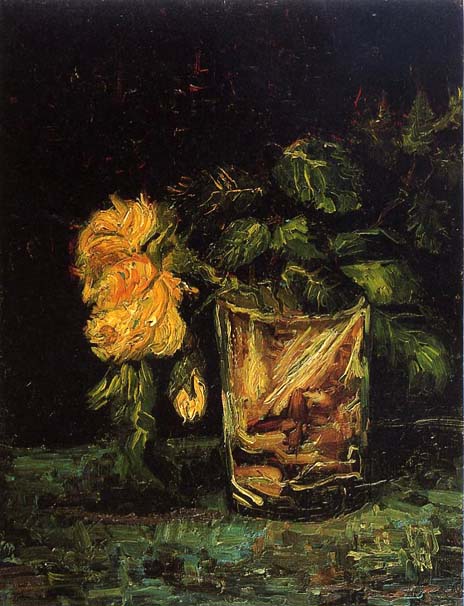
Green Wheat Field: 1889
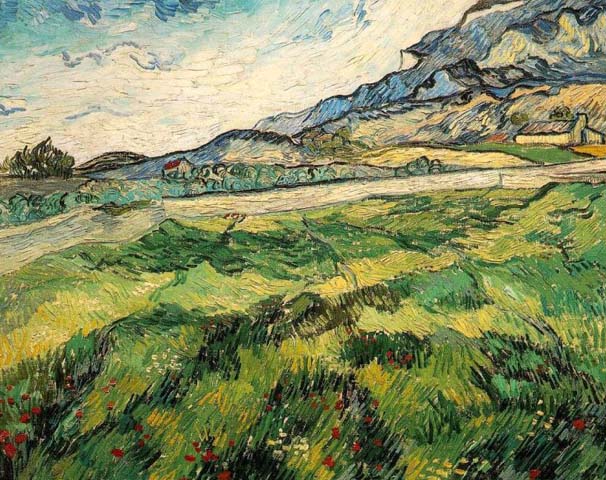
Green Wheat Field with Cypress: 1889
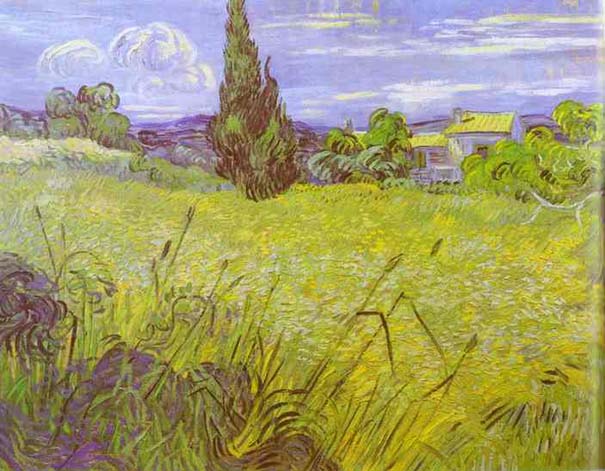
Van Gogh describes the ripening Green Wheat Field with Cypresses painted in June: "a field of wheat turning yellow, surrounded by blackberry bushes and green shrubs. At the end of the field there is a little house with a tall somber cypress which stands out against the far-off hills with their violet-like and bluish tones, and against a sky the colour of forget-me-nots with pink streaks, whose pure hues form a contrast with the scorched ears, which are already heavy, and have the warm tones of a bread crust."
Quoted From: Wheat Fields (Van Gogh Series) - Wikipedia
Harvest Landscape with Blue Cart: 1888
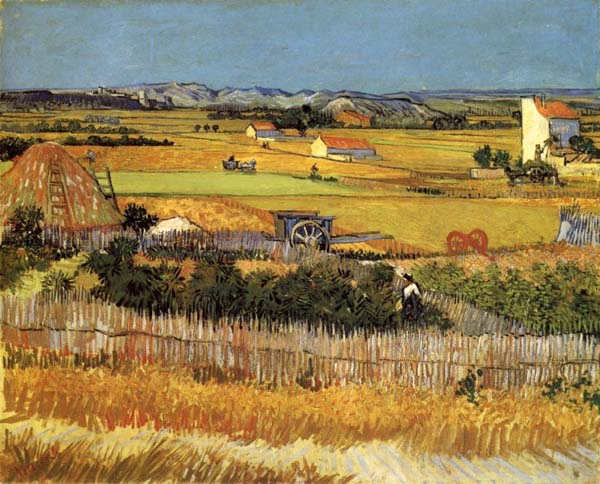
While in Arles, Van Gogh painted a number of series on various subjects. He had already carried out a sequence of blossoming orchards in the spring of 1888, and in June of that year he turned his attention to the harvest and wheatfields. In little more than a week he executed as many as ten paintings and five drawings on the theme. He worked daily in the fields under the burning sun, until a huge storm put an unexpected end to the harvest on June 20th.
Quoted From: Van Gogh Museum - The Harvest
Peasant Character Studies is a series of works that Vincent van Gogh made between 1881 and 1885.
Van Gogh had a particular attachment and sympathy for the working class fueled in several ways. He was particularly fond of the peasant genre work of Jean-François Millet and others. He found the subjects noble and important in the development of modern art. Van Gogh had seen the changing landscape in Holland as industrialization encroached on once pastoral settings and the livelihoods of the working poor with little opportunity to change vocation.
Van Gogh had a particular interest in creating character studies of working men and women in Holland and Belgium, such as farmers, weavers, and fishermen. Making up a large body of Van Gogh's work during this period, the character studies were an important, foundational component in his artistic development.
Quoted From: Peasant Character Studies (Van Gogh Series) - Wikipedia
Head of a Peasant: 1885

Head of a Peasant with a Pipe: 1884
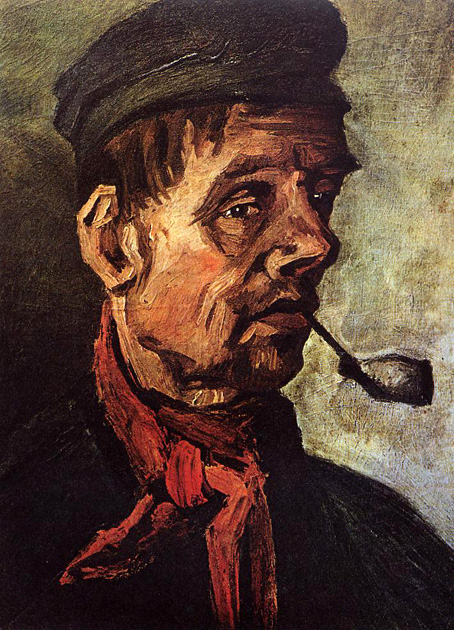
Head of a Peasant Woman with a Greenish Lace Cap: 1885
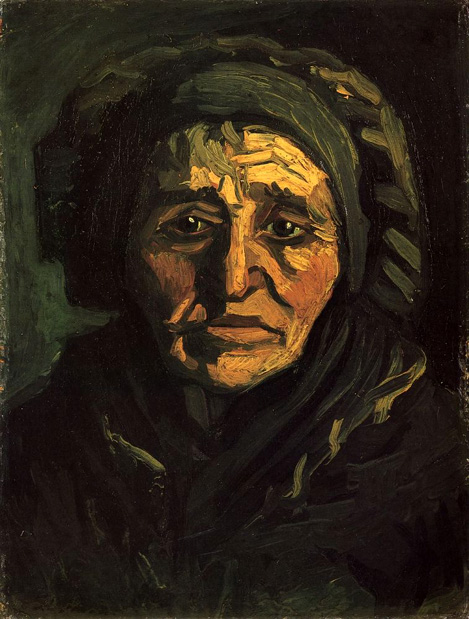
Head of a Peasant Woman with White Cap: 1885

Head of a Young Peasant in a Peaked Cap: 1885
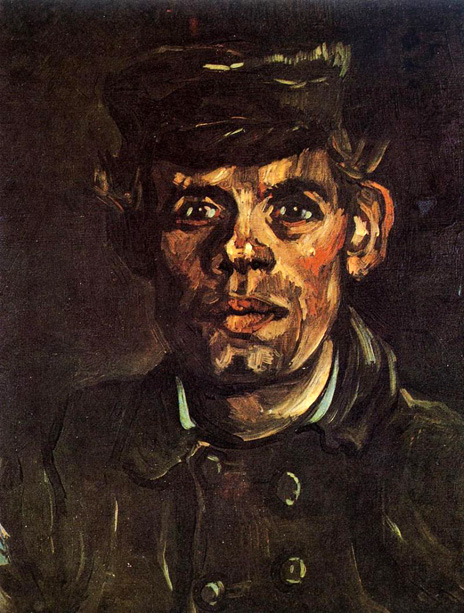
Head of an Old Woman in a White Cap: 1885
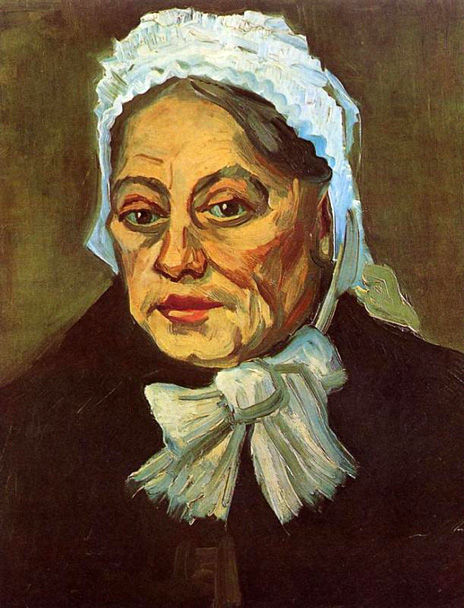
Houses with Thatched Roofs, Cordeville: 1890
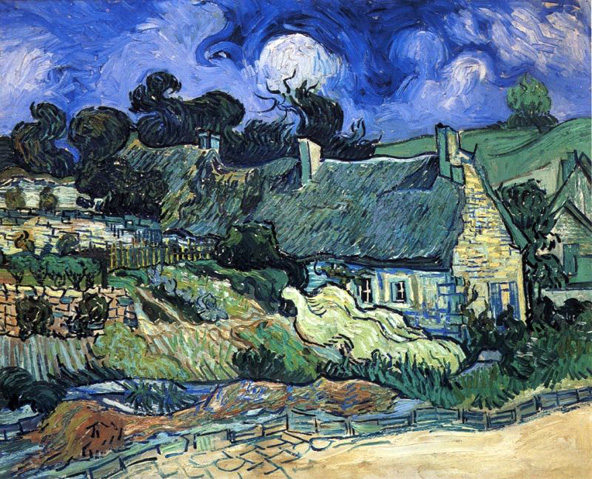
This picture was painted during the artist's most frenetic creative period, a few weeks before his tragic death. Van Gogh had left Provence in May 1890, at the end of his voluntary stay at the asylum in Saint-Rémy. He moved to Auvers-sur-Oise, north of Paris. On 10 June, he wrote to his brother Theo that "he was doing two studies of houses out in the countryside". Corot, Daubigny, Pissarro and Cézanne had already evoked the peaceful charm of Auvers. Van Gogh would transform it into a volcanic land where the houses seem to have been twisted by an earthquake.
Here the painter subjects the landscape to a veritable transmutation driven by psychic forces. The peaceful thatched cottages, which can still be seen in old photographs, seem to have been lifted by some powerful telluric force that has dilated them. The wild, swirling design makes the roof undulate, sends the tree branches up in spirals, transforms the clouds into arabesques... Moreover, the image is worked in thick impasto with real furrows gouged into the paint.
It is clear that this artist is not overwhelmed as the Romantics were by the awe-inspiring landscape. On the contrary, it is he who torments and inflames the lowliest hovel and the smallest cypress tree. Just as in Starry Night (New York, MoMA) from 1889, all the elements in the landscape unite in distorting their contours and give the whole scene a supernatural air.
Quoted From: Musée d'Orsay: Vincent van Gogh Thatched Cottages at Cordeville
Irises: 1889

Irises: 1890
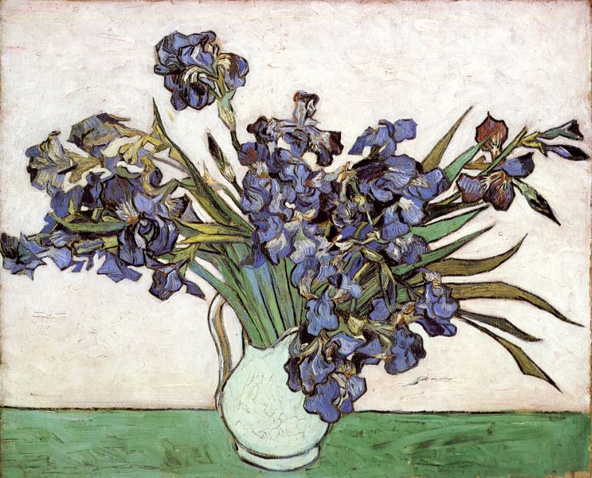
La Crau with Peach Trees in Bloom: 1889
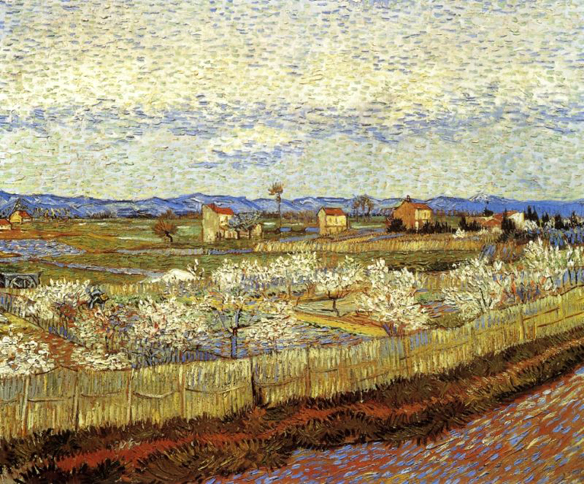
La Mousme: 1888
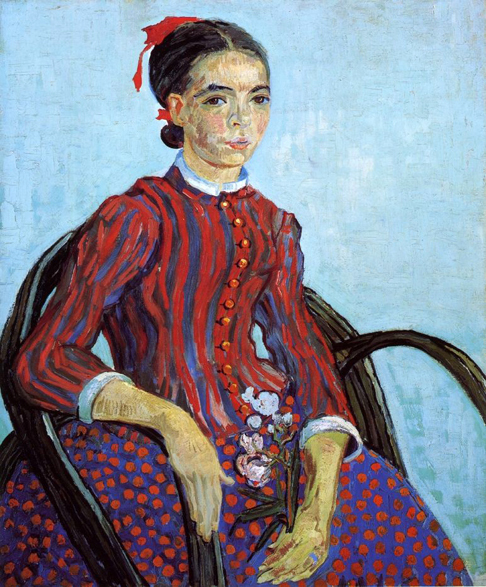
The sensational aspects of Van Gogh's life and suicide often cloud the intention and deliberation behind his highly charged and expressive style. In a letter to his brother Theo he described how this painting consumed his attention: "It took me a whole week...but I had to reserve my mental energy to do the mousmé well." This name, he explained, came from a character in a popular novel set in Japan. "A mousmé is a Japanese girl-Provençal in this case-twelve to fourteen years old."
The girl's costume is a contrast of patterns and complementary shades of blue and orange. The paint in these bold stripes and irregular dots stands out against the pale green lattice of vertical and horizontal brushstrokes in the background. The vigorous patterns express Van Gogh's sympathetic response to his young sitter, whose face is carefully modeled and finished to a greater degree than other parts of his picture. Compare her hands, for example, which are more sketchily painted.
La Mousmé is one of a series of portraits that Van Gogh painted while living in Arles. They were, he wrote, "the only thing in painting that excites me to the depths of my soul, and which made me feel the infinite more than anything else." The flowering branch the girl holds is probably related to Van Gogh's pantheistic faith in the power of nature's cycles of life and renewal.
Quoted From: La Mousmé - National Gallery of Art, Washington, DC
Landscape at Dusk: 1885
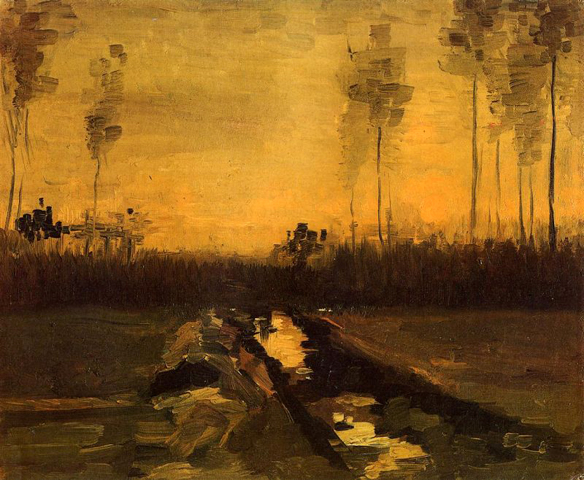
Landscape in the Rain: 1890
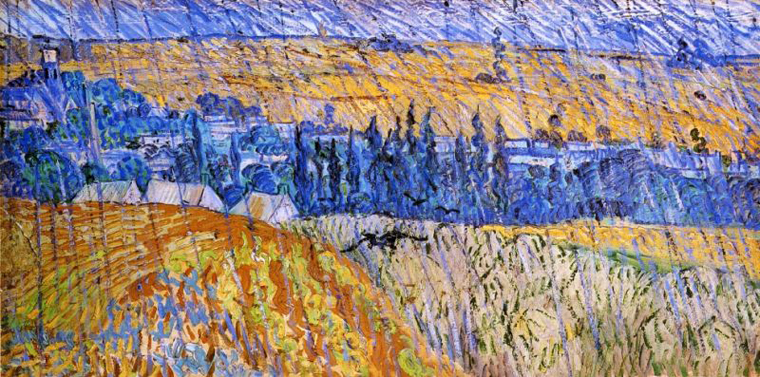
Landscape Under A Stormy Sky: 1888
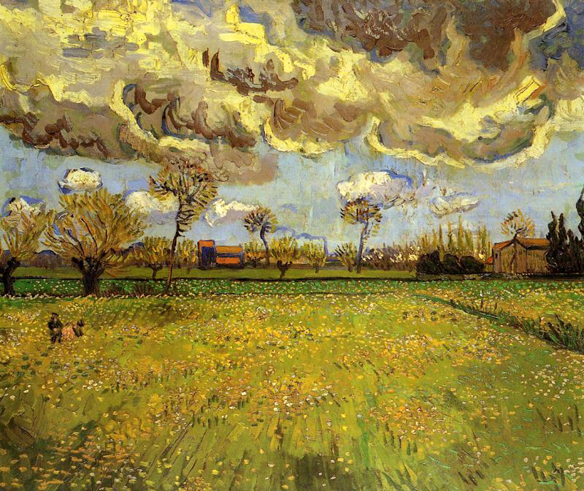
Landscape with Church and Farms: 1885

Male Nude: 1886
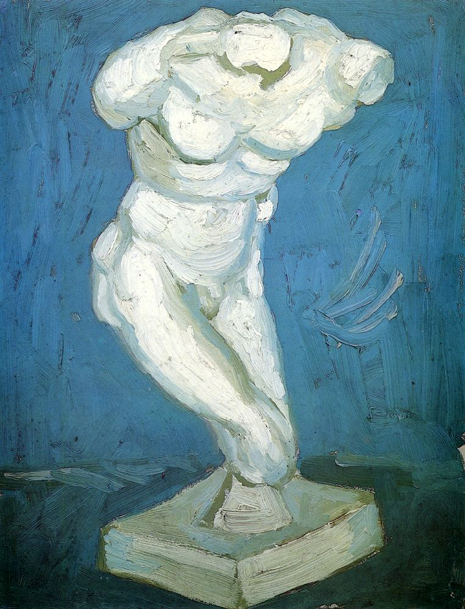
Man Digging: 1882
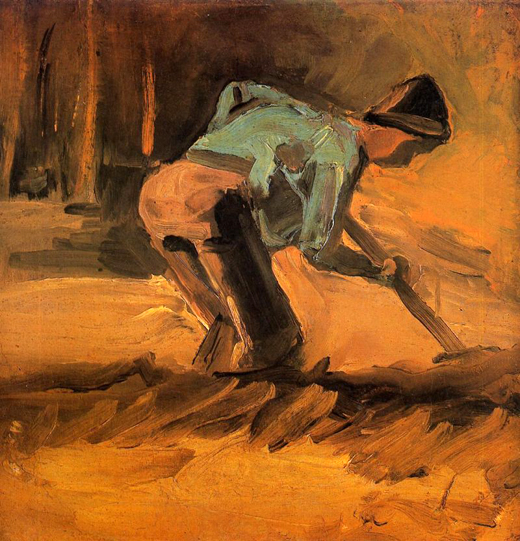
Man with Spade in a Suburb of Paris: 1887

Van Gogh liked to explore the outskirts of Paris, searching for pastoral settings in parks and the wooded areas of the suburbs. His goal was to find scenes that would allow him to explore techniques he learned in Paris.
Marguerite Gachet at the Piano: 1890
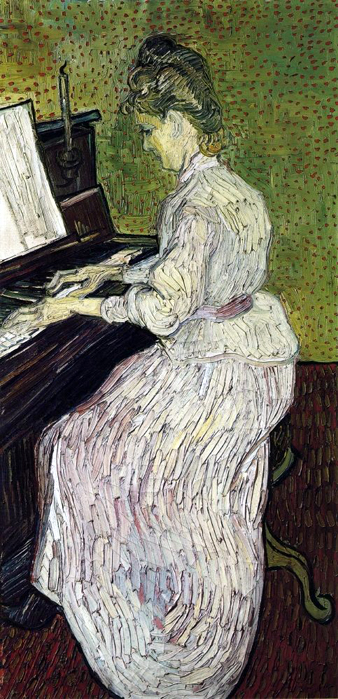
Meadows near Rijswijk: 1882

Montmartre the Quarry and Windmills: 1886
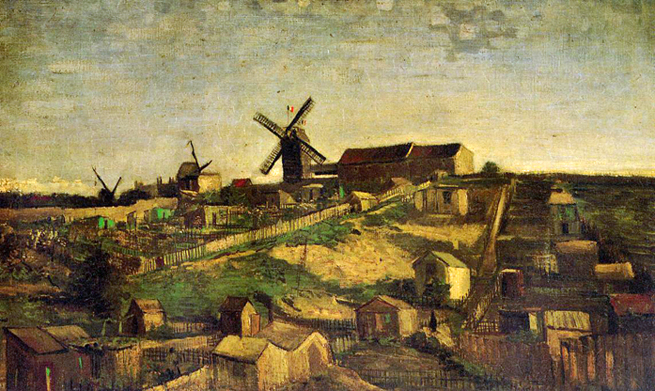
Montmartre the Quarry and Windmills: 1886
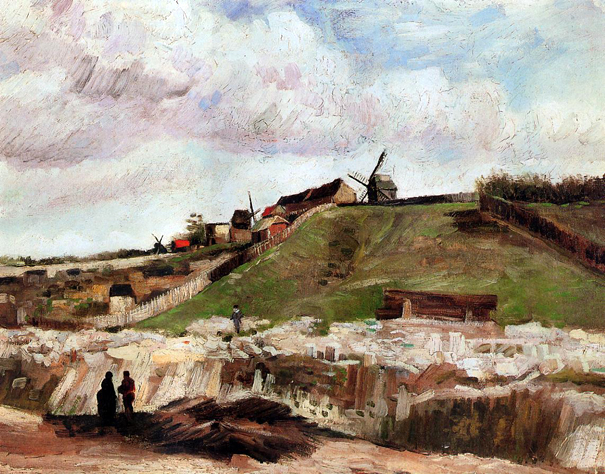
The Montmartre paintings are a group of works that Vincent van Gogh made in 1886 and 1887 of the Paris district of Montmartre while living there with his brother Theo. Rather than capture urban settings in Paris, Van Gogh preferred pastoral scenes, such as Montmartre and Asnières in the northwest suburbs. Of the two years in Paris, the work from 1886 often has the dark, somber tones of his early works from Holland and Brussels. By the spring of 1887 Van Gogh embraced use of color and light and created his own brushstroke techniques based upon Impressionism and Pointillism. The works in the series provide examples of his work during that period of time and the progression he made as an artist.
Quoted From: Montmartre (Van Gogh Series) - Wikipedia
Old Cottages, Chaponval: 1890

Olive Grove: 1889
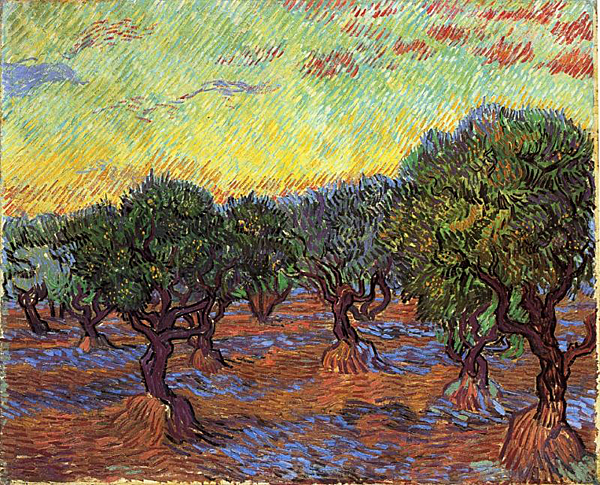
Olive Grove: 1889
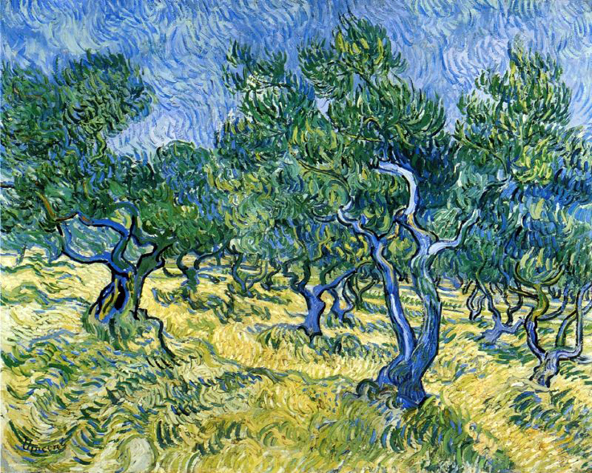
Olive Grove: 1889
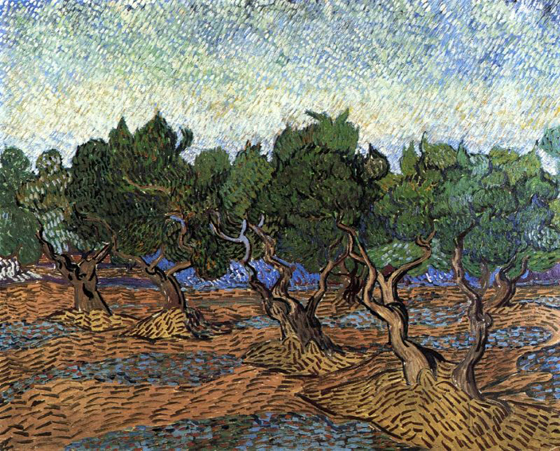
Vincent van Gogh painted at least 18 paintings of olive trees, mostly in Saint-Rémy in 1889. At his own request, he lived at an asylum there from May 1889 through May 1890 painting the gardens of the asylum and, when he had permission to venture outside its walls, nearby olive trees, cypresses and wheat fields.
One painting, Olive Trees in a Mountainous Landscape, was a complement to The Starry Night.
The olive tree paintings had special significance for Van Gogh. A group in May 1889 represented life, the divine and the cycle of life while those from November 1889 arose out of Van Gogh's attempt to symbolize his feelings about Christ in Gethsemane. His paintings of olive pickers demonstrate the relationship between man and nature by depicting one of the cycles of life, harvesting or death. It is also an example of how individuals, through interaction with nature, can connect with the divine.
Van Gogh found respite and relief in interaction with nature. When the series of olive tree paintings was made in 1889 Van Gogh was subject to illness and emotional turmoil, yet the paintings are among his finest works.
Quoted From: Olive Trees (Van Gogh Series) - Wikipedia
Olive Trees: 1889
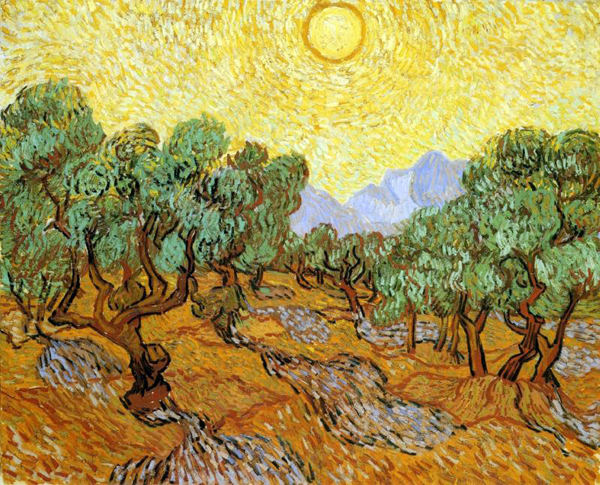
Outskirts of Paris: 1886
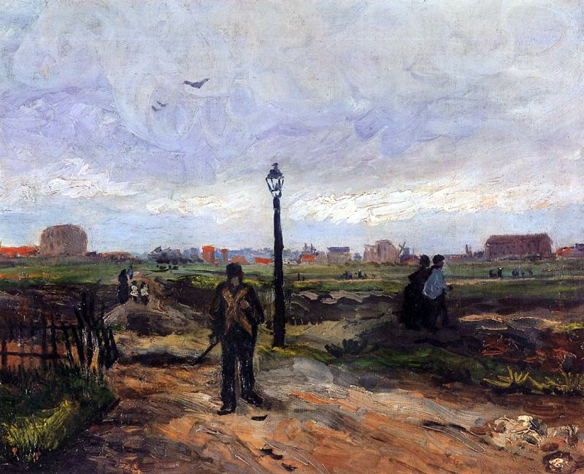
Peach Trees in Blossom: 1888
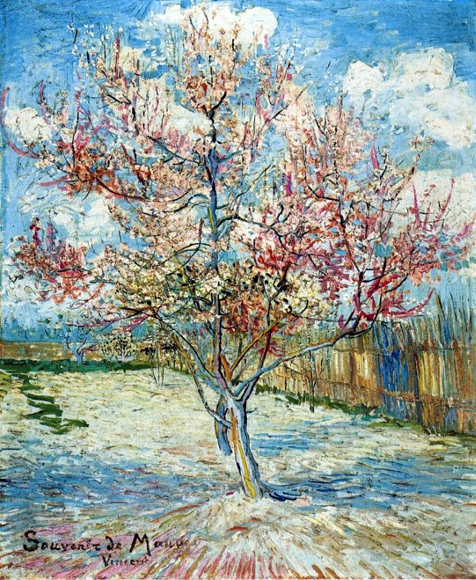
Pear Tree in Blossom: 1888

Peasant Burning Weeds: 1883
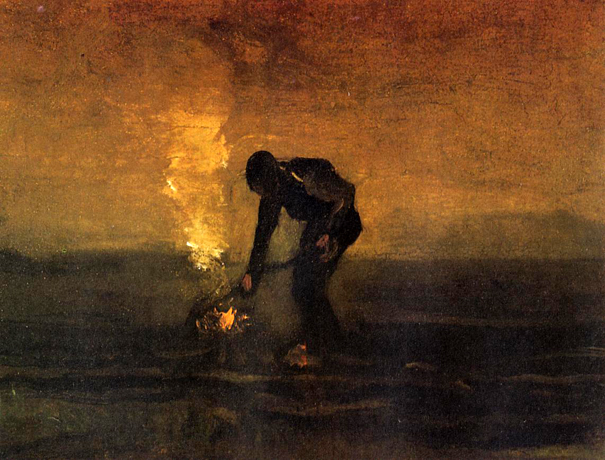
Peasant Girl with Yellow Straw Hat: 1890
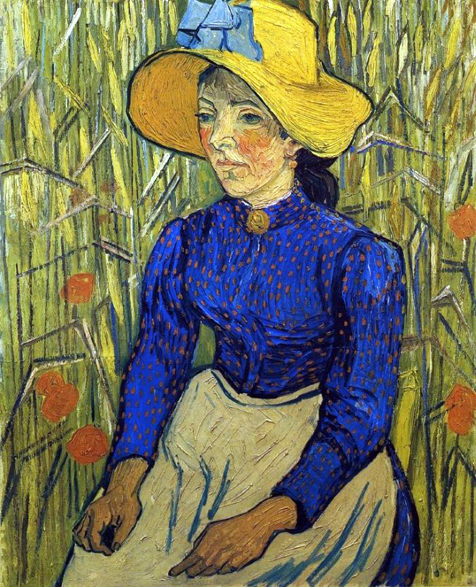
Peasant Man and Woman Planting Potatoes: 1885
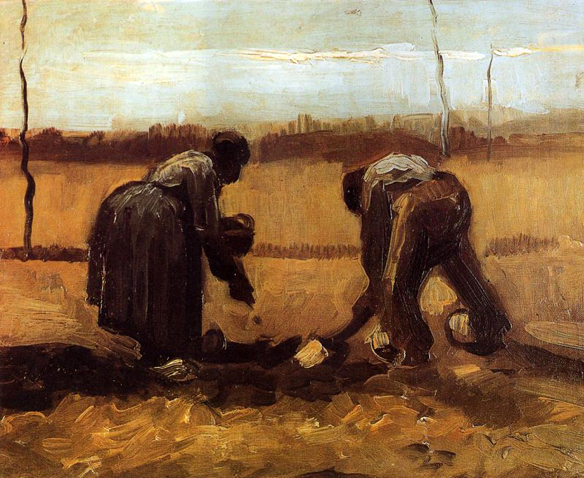
Peasant Woman by the Fireplace: 1885
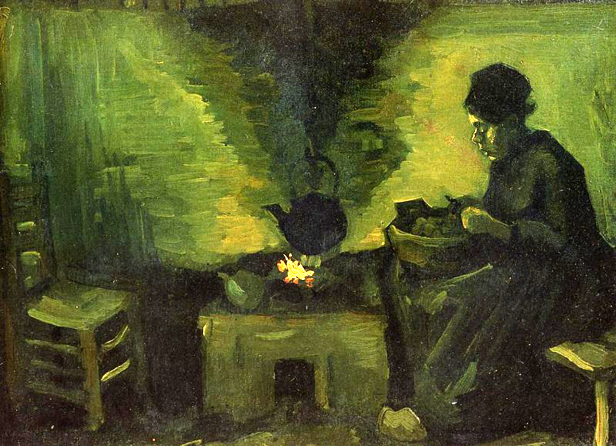
Peasant Woman Digging: 1885
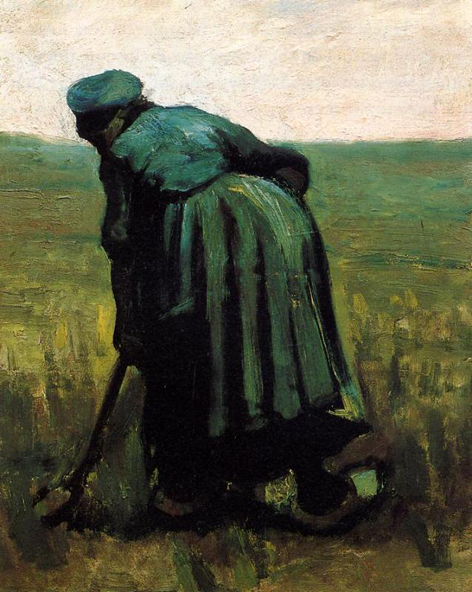
Peasant Woman Peeling Potatoes: 1885
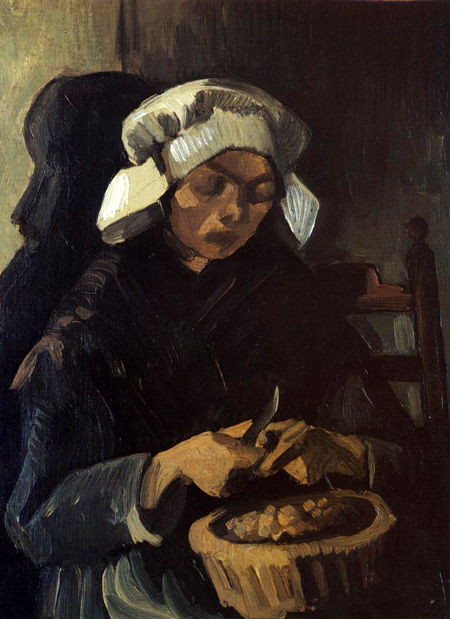
Peasant Woman Seated: 1885
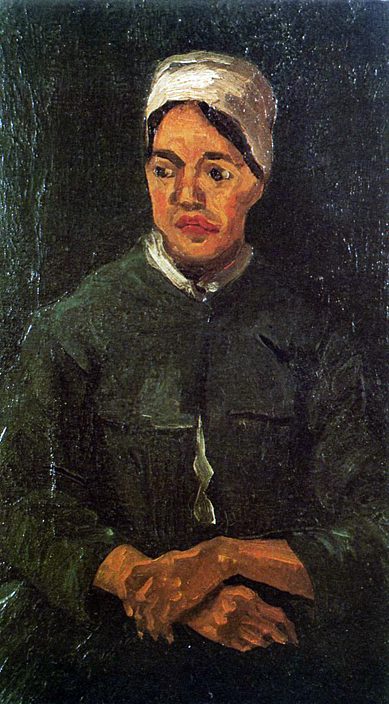
Peasant Woman with a Child in Her Lap: 1885
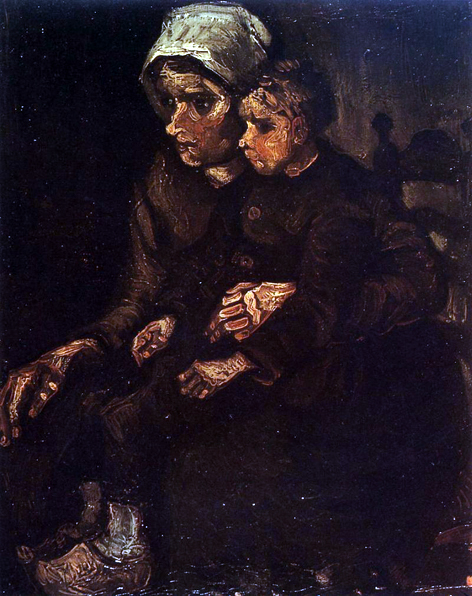
Pine Trees Against an Evening Sky: 1889
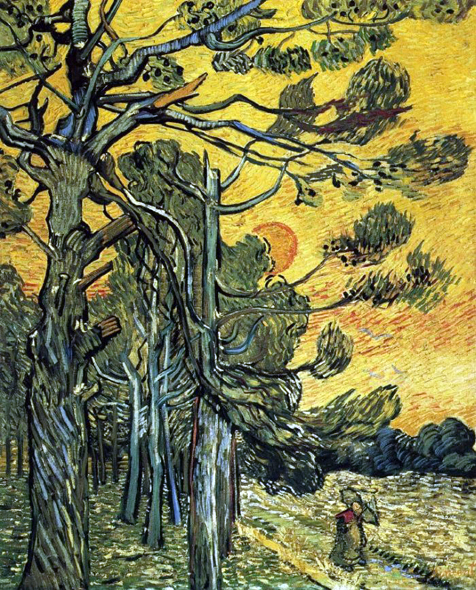
Ploughman with Woman Planting Potatoes: 1884
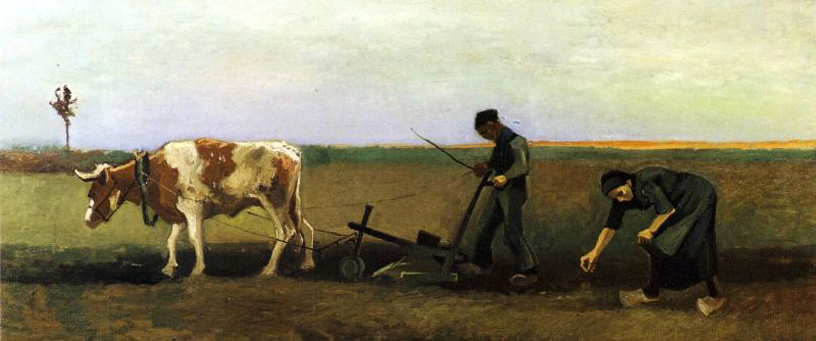
Plowed Field: 1888

Pollard Birches: 1884
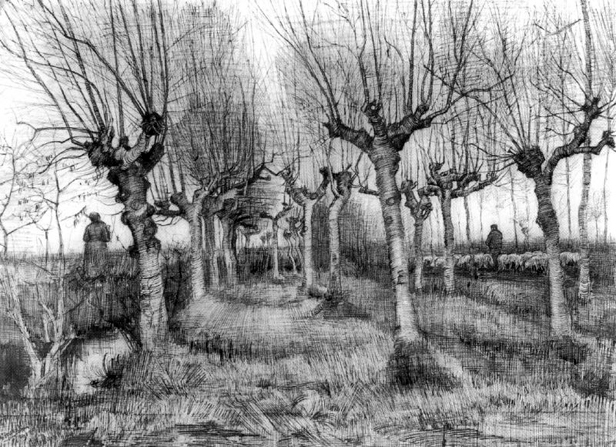
Pollard Willow: 1882
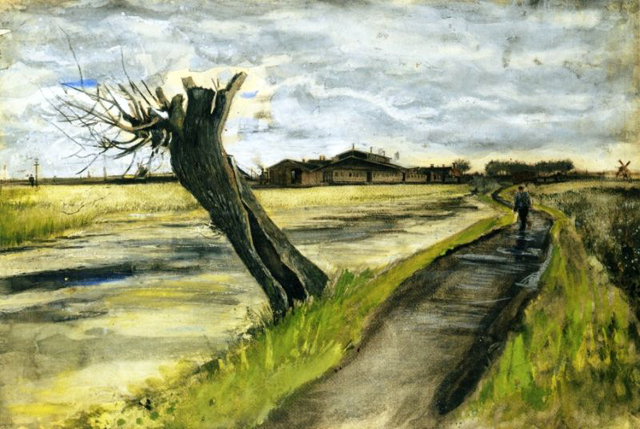
Pollard Willow with Setting Sun: 1888
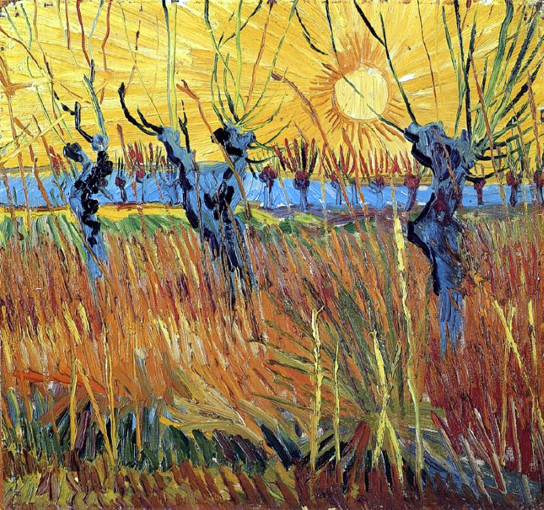
Portrait of a Woman: 1887

Portrait of a Woman: 1887
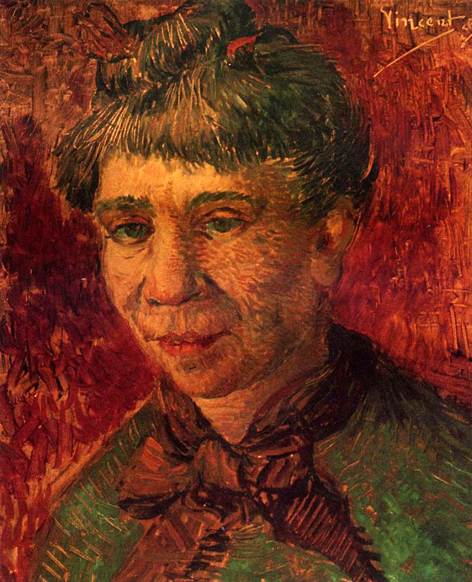
Portrait of a Woman in Blue: 1885
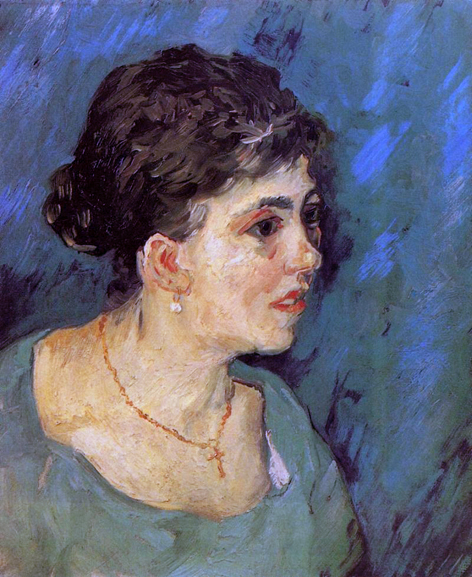
Portrait of a Woman with a Red Ribbon: 1885
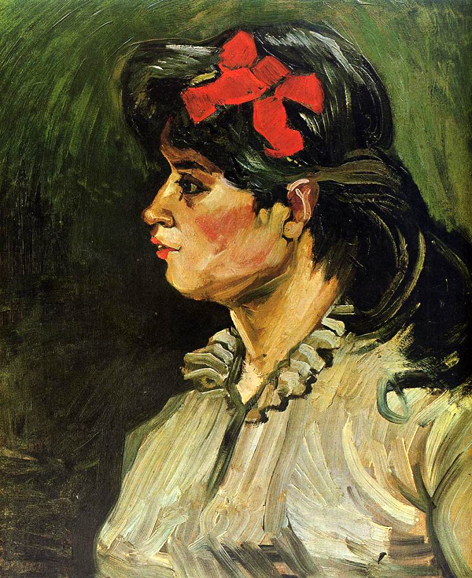
Portrait of Adeline Ravoux: 1890
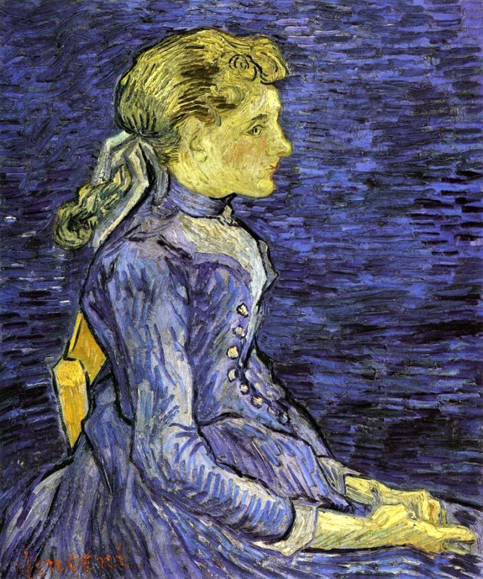
Portrait of Alexander Reid: 1887
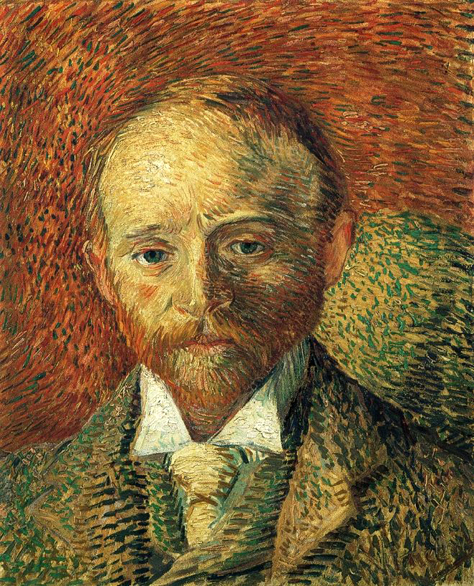
Portrait of Boekverkoper Blok: 1882
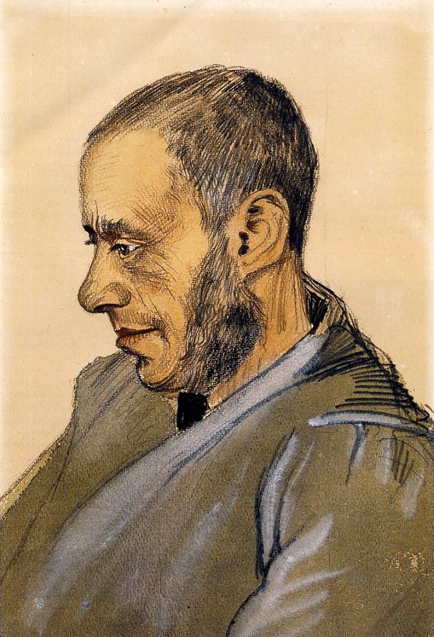
Portrait of Doctor Felix Rey: 1889

Portrait of Pere Tanguy: 1887

Portrait of Pere Tanguy: 1888

Portrait of Trabuc: 1889
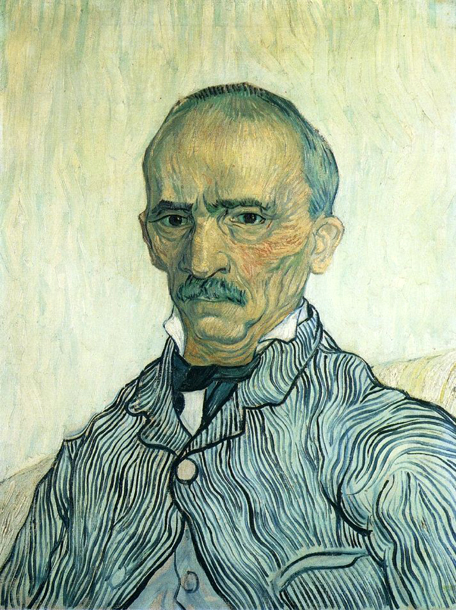
Quayside with Ships in Antwerp: 1885

Reaper: 1889

Road with Pollarded Willows and a Man with a Broom: 1881

Roadway with Underpass: 1887
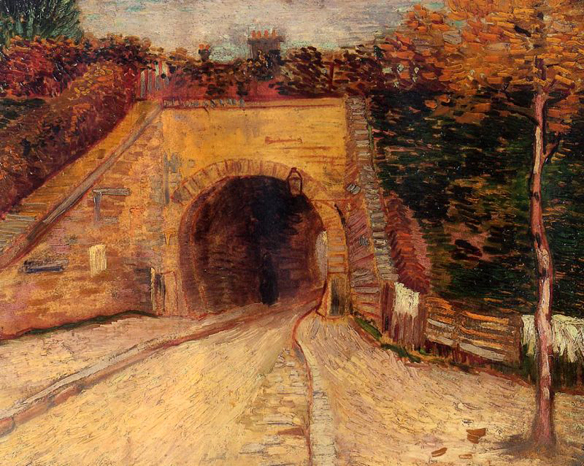
Roots and Tree Trunks: 1890
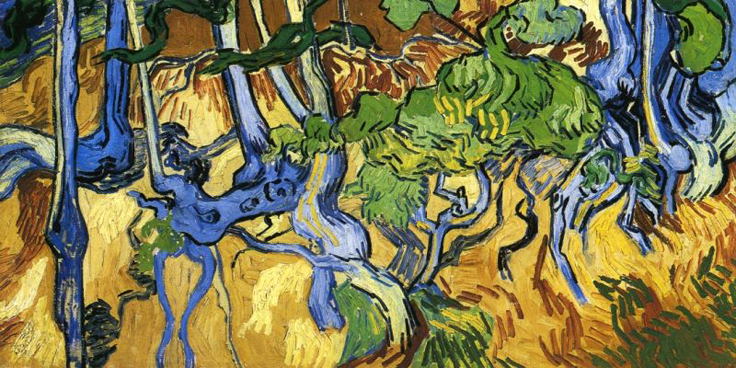
Roses: 1890
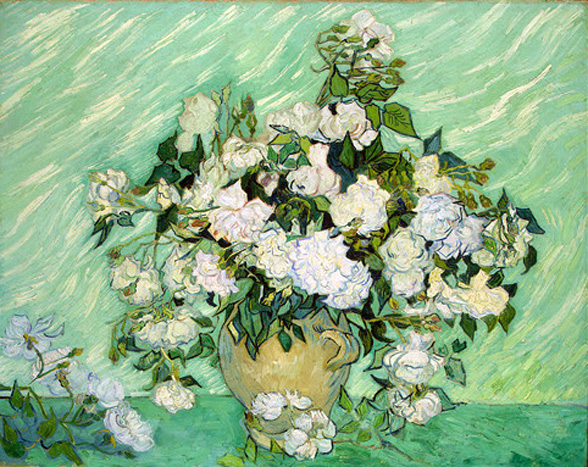
Rowing Boats on the Banks of the Oise: 1890

Sand Barges: 1888
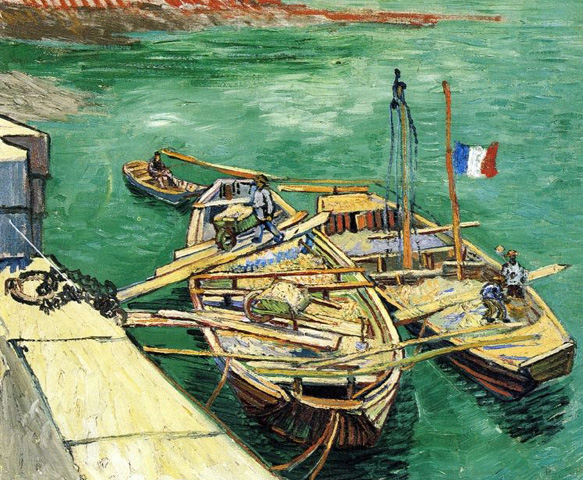
Still Life with a Bottle, Lemons and Oranges:1888

Still Life with Apples, Meat and a Roll: 1886
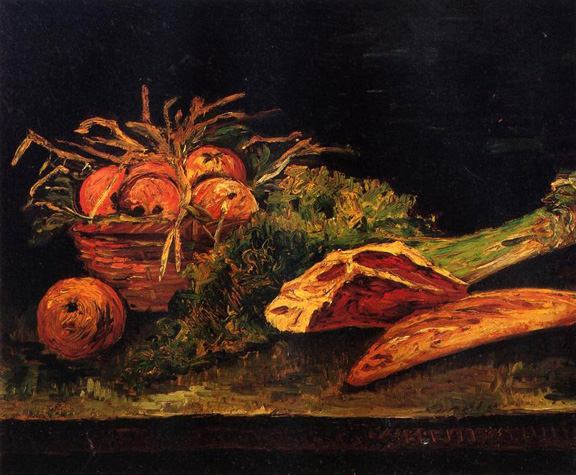
Still Life with Coffee Mill, Pipe Case and Jug: 1884
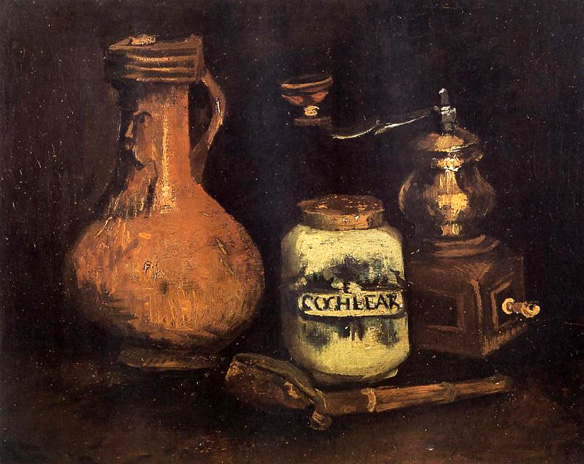
Still Life with Earthenware, Bottle and Clogs: 1885
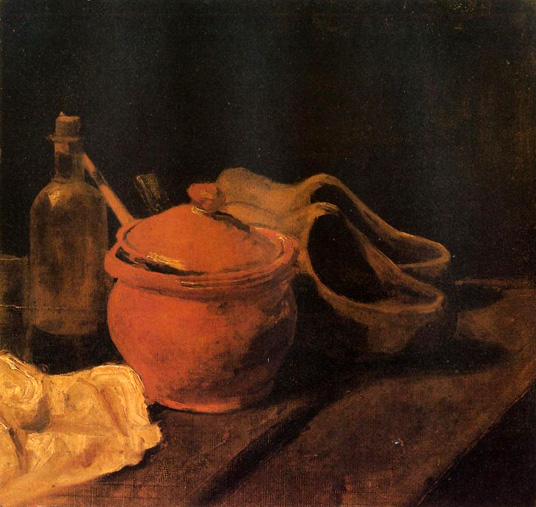
Snowy Landscape with Arles in the Background: 1888

Sorrow: 1882
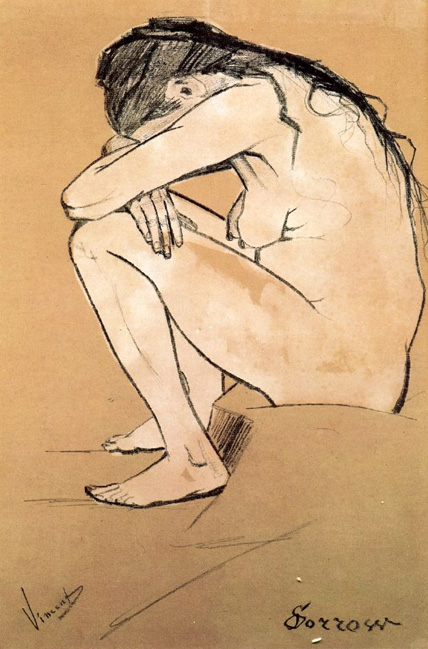
Sien (Van Gogh Series)
Vincent van Gogh drew and painted a series of works of his mistress Sien during their time together in the Netherlands. In particular, his drawing Sorrow is widely acknowledged as a masterwork of draftsmanship, the culmination of a long and sometimes uncertain apprenticeship in learning his craft.
Commonly called Sien Hoornik, Clasina Maria Hoornik (1850 - 1904) lived with van Gogh during much of his time in The Hague from 1881 to 1883. Van Gogh used Sien, a pregnant prostitute, as a model for his work and later took Sien and her daughter into his home. Van Gogh made drawings and paintings of Sien and her daughter, baby and mother over that period, which reflected the domestic life and hardships of the working poor. Their relationship was not accepted by his family or supporters, although his brother Theo did not withdraw his support over it. It did contribute undoubtedly, however, to a split with Anton Mauve, a cousin-in-law and noted painter of the Hague School, who had introduced van Gogh to painting as well as supporting him financially, and whom van Gogh revered. At his brother Theo's urging, van Gogh left Sien in 1883 to paint in Drenthe, putting an end to the only domestic relationship he was ever to have.
Sien resumed her life as a seamstress, cleaning woman and likely prostitute before marrying in 1901. On 12 November 1904, aged 54, she threw herself into the Schelde river and drowned, fulfilling a prophecy she had made to van Gogh in 1883: "Yes, I'm a whore ... it's bound to end up with me jumping into the water."
Quoted From: Sien (Van Gogh Series) - Wikipedia
The Great Lady
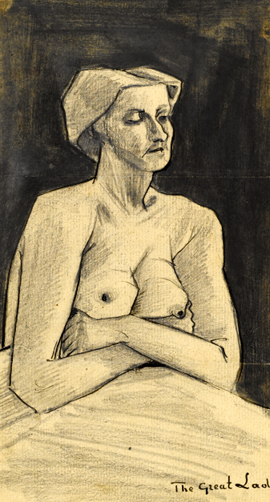
The Great Lady, sketch in a letter, in the Van Gogh Museum
Sien
The works of Sien, a 32 year old prostitute and seamstress, often depict her in traditional domestic feminine roles: a mother, seamstress, and domestic worker. In the drawing Sorrow and a subsequent lithograph, Sien represents a woman's sorrow and frailty. Some of the works are iconic, such as Woman Seated and Mother with Child.[40] When van Gogh made drawings of Sien sewing, the compositions were simple as was her work. If she had been in a higher station in life, a painting of her sewing would no doubt have shown her performing embroidery. Rather than being an activity for enjoyment, Sien's sewing was one of drudgery.
Regarding Woman Seated, it is curious that he posed Sien in a dress identical to one worn by Kee Vos Stricker, as can be verified by the photograph of Kee Vos and her son catalogued in the Dutch national archive Geheugen van Nederland and held in the collection of the Van Gogh Museum, Amsterdam.
In a letter van Gogh mentioned how he considered Sien his helpmate or partner in the creation of the works which depicted her van Gogh would write Theo about his relationship with Sien, saying that it wasn't exactly love between them but rather a mutual understanding. Vincent took Sien off the streets and provided for her and her children, and in return she posed for him.
Quoted From: Sien (Van Gogh Series) - Wikipedia

Sien with a cigar, sitting on the floor beside the fireplace
Sien in a White Bonnet

Sien in a White Bonnet, pencil, black lithographic chalk, washed, December 1882, Van Gogh Museum, Amsterdam, The Netherlands
Woman Seated, Mourning
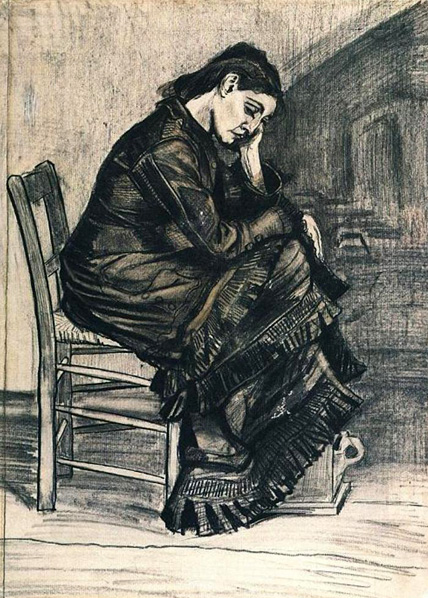
Woman Seated, pencil, pen and brush in black ink, brown/sepia wash, white opaque watercolour, traces of squaring, on laid paper (two sheets), April 1882, Kröller-Müller Museum, Otterlo, The Netherlands
Sien Pregnant, Walking with an Older Woman
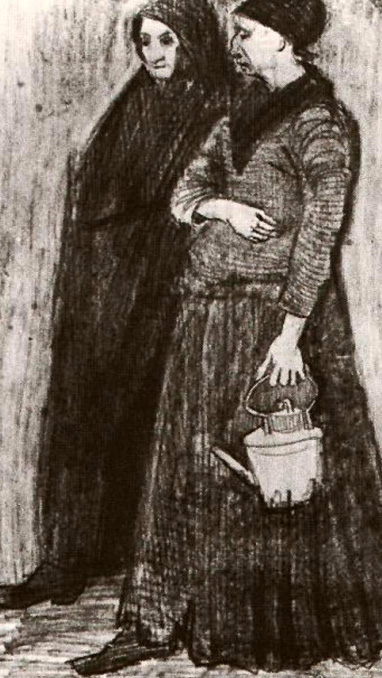
Two women strolling (pregnant Sien and her mother), pencil, first half of 1882, Private collection, Netherlands
Sien, Sewing
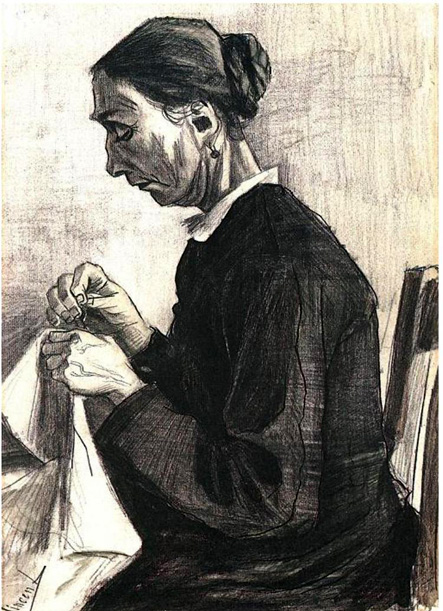
Sien, Sewing, Half-Figure, pencil, black mountain chalk 1883, Museum Boijmans Van Beuningen, Rotterdam, The Netherlands
Sien,Sewing
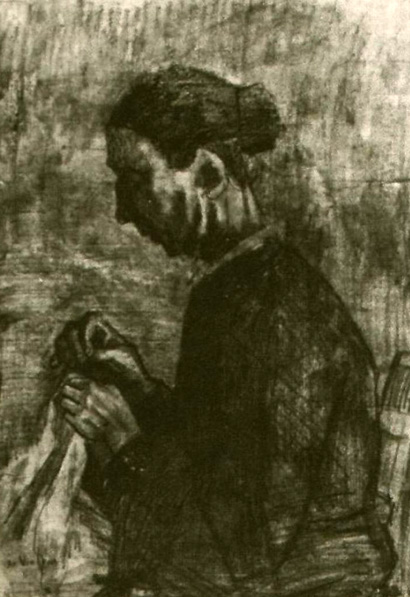
Sien, Sewing, Half-Figure, pencil, lightly washed, 1883, Kröller-Müller Museum, Otterlo, The Netherlands
Sien with Umbrella and Prayer Boo
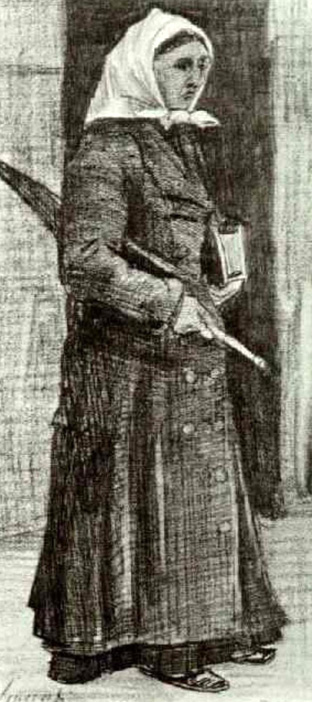
Sien with Umbrella and Prayer Book, pencil, black chalk, 1882, Private collection
Sien Peeling Potatoes

Sien Peeling Potatoes, black chalk, 1883, Gemeentemuseum Den Haag, The Hague, The Netherlands
Sien with the baby, Willem
Sien Nursing Baby

Sien Nursing Baby, Half-Figure, drawing, 1882, Kröller-Müller Museum, Otterlo, The Netherlands
Sien Nursing Baby
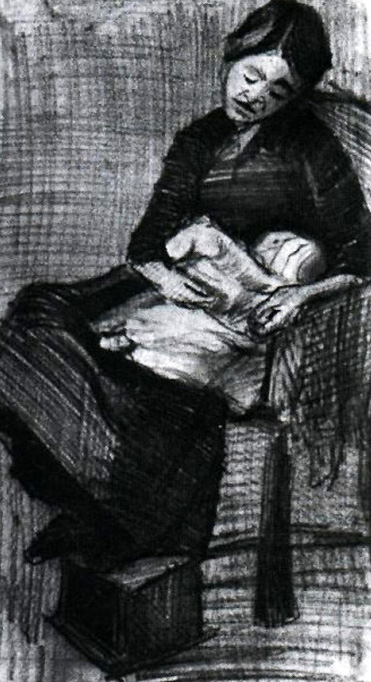
Sien Nursing Baby, drawing, 1882, Kröller-Müller Museum, Otterlo, The Netherlands
Sien Nursing Baby
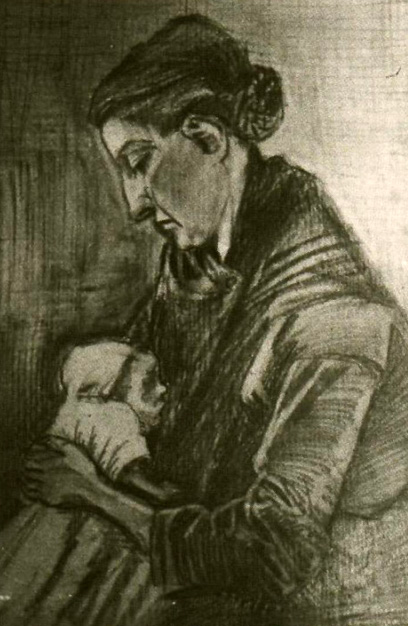
Sien Nursing Baby, drawing, 1882, Private collection
Sien Nursing Baby
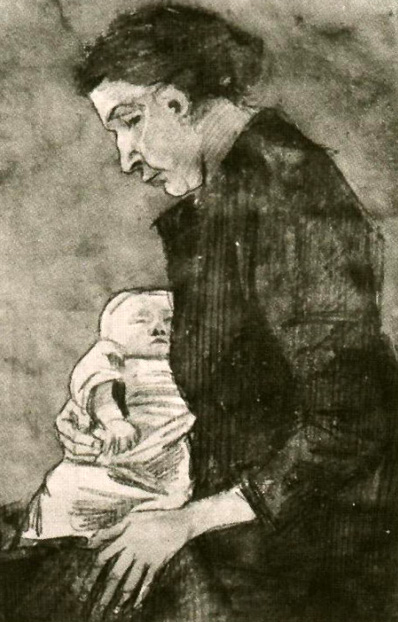
Sien Nursing Baby, Half-Figure, drawing, 1882, Private collection
Sien Nursing Baby
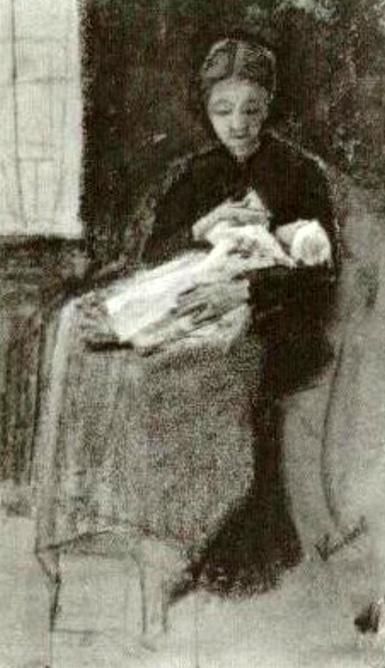
Sien Nursing Baby, watercolor, 1882, Private collection
Sien with Child on her Lap

Sien with Child on her Lap, drawing, 1882, Kröller-Müller Museum, Otterlo, The Netherlands
Sien with Baby on her Lap
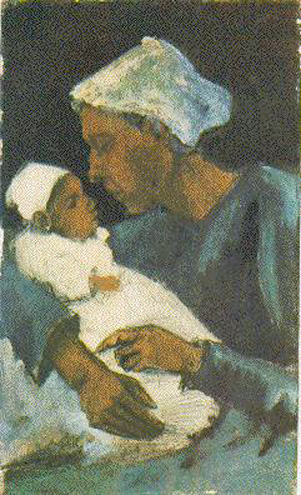
Woman (Sien) with Baby on her Lap, Half-Figure, September 1882
Sien's Daughter, Maria
Sien's Daughter, Maria

Sien's daughter with scarf, January 1883, Kröller-Müller Museum, Otterlo, Netherlands
Sien, Sitting on a Basket, with a Girl (Maria)
.jpg)
Sien, Sitting on a Basket, with a Girl, 1883, Natural black, chalk, pen and brush in brown-black ink (possibly black originally), black watercolour, opaque grey watercolour, grey (?) wash, scratched, on wove paper, Van Gogh Museum, Amsterdam
Girl Kneeling by a Cradle

Girl Kneeling by a Cradle, (Maria and Willem), March 1883, drawing (pencil, charcoal, heightened with white), Van Gogh Museum, Amsterdam
Sien's mother
Sien's Mother: Woman with a Dark Cap
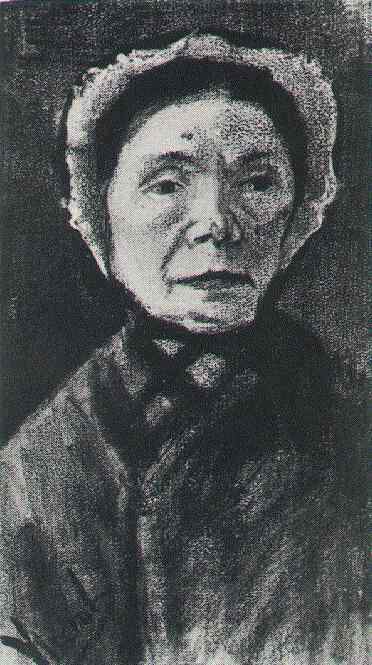
Woman with Dark Cap (Sien's Mother), 1882
Sien's Mother's House Seen from the Backyard: 1882
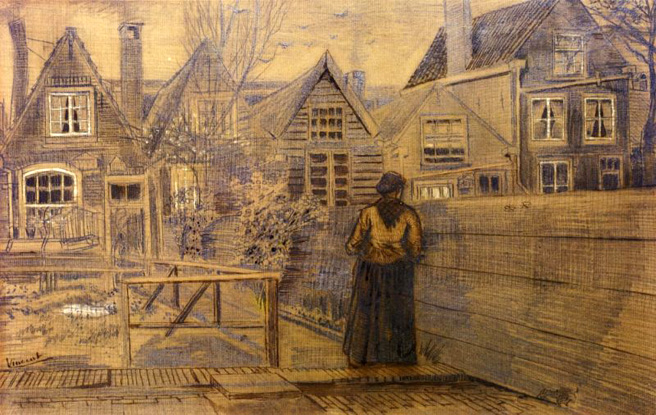

Sien's Mother's House, drawing, 1882, Private collection
Sien's Mother's House, Closer View
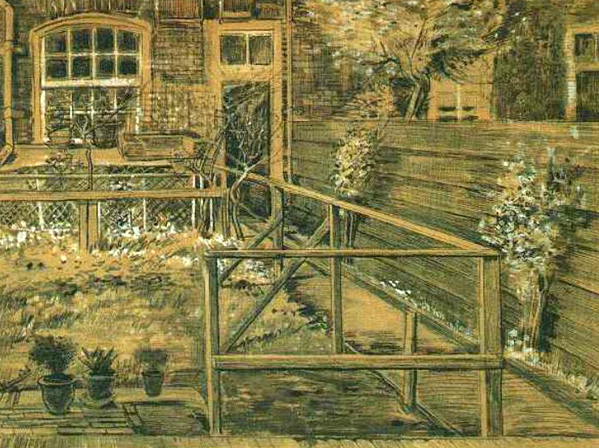
Sien's Mother's House, Closer View, drawing, 1882, Norton Simon Museum, Pasadena, California
Public Soup Kitchen
Quite poor, Sien's family often relied upon the public soup kitchen for food.
Hulsker called the signed drawing The Public Soup Kitchen important and attractive. Van Gogh and his contemporary George Hendrik Breitner had sketched together at a soup kitchen in the Geest (it is not known which of the several possibilities it was). After going to the trouble and expense of installing shutters in his windows to adjust the light and to recreate the scene itself in his studio, van Gogh was able to study his models at leisure. In this way he was able to introduce more chiaroscuro (light and dark) in his drawing, which he executed with the natural ('mountain') chalk that Theo had sent him and whose properties he lauds in his letters. All the models are from Sien's family: her mother and baby on the left, her sister, back turned, and her daughter, hair cropped as a precaution against lice, in the center, with Sien herself, superbly executed in profile, on the right. The watercolor is much less successful as van Gogh himself acknowledged, blaming the paper in part for not being right for the job.
Quoted From: Sien (Van Gogh Series) - Wikipedia
The Soup Distribution in a Public Soup Kitchen

Soup Distribution in a Public Soup Kitchen, drawing, 1883,
Van Gogh Museum, Amsterdam
The Public Soup Kitchen
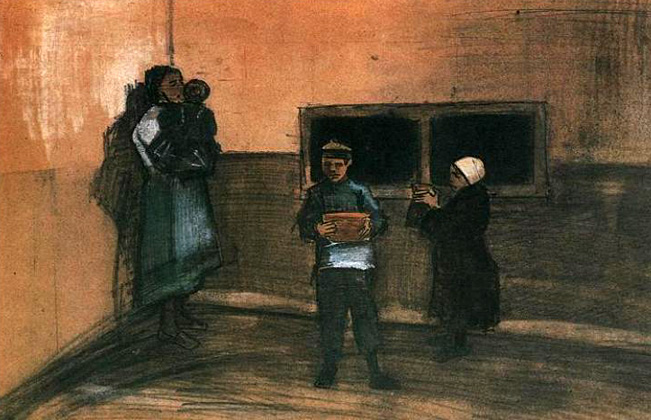
The Public Soup Kitchen, watercolor,
1883, Private collection
Sheaves of Wheat in a Field: 1885
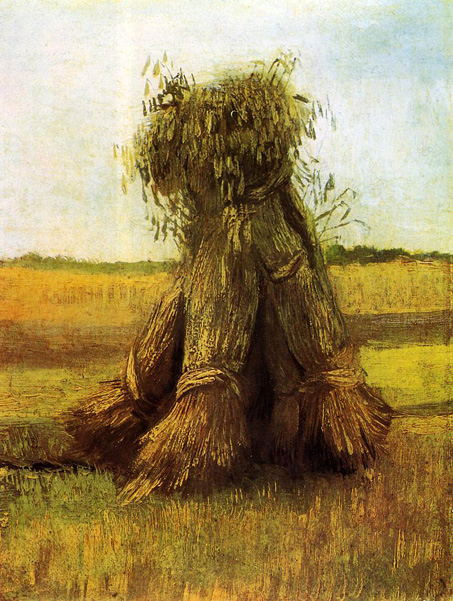
Stacks of Wheat near a Farmhouse: 1888
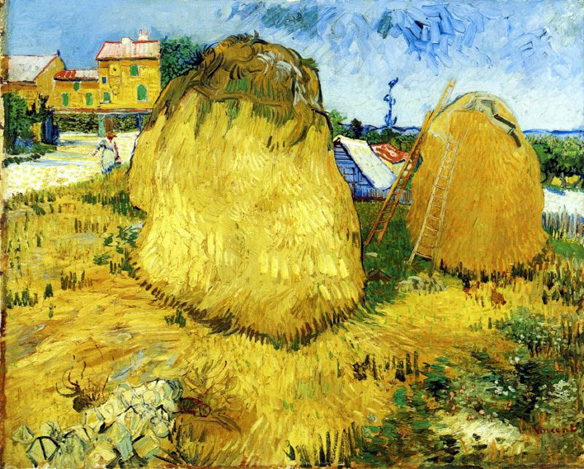
Still Life with Frutillarias: 1887
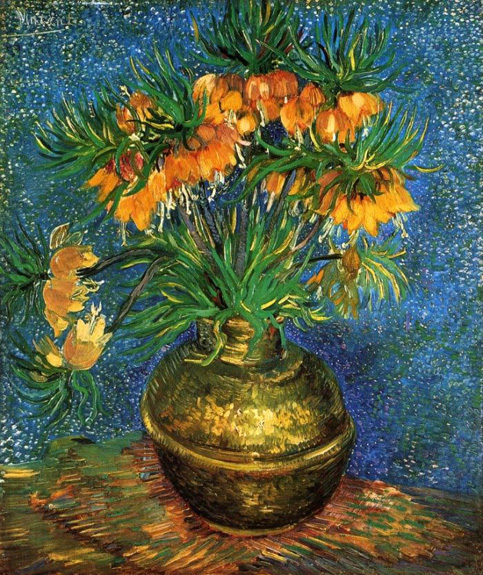
Still Life with Irises: 1890
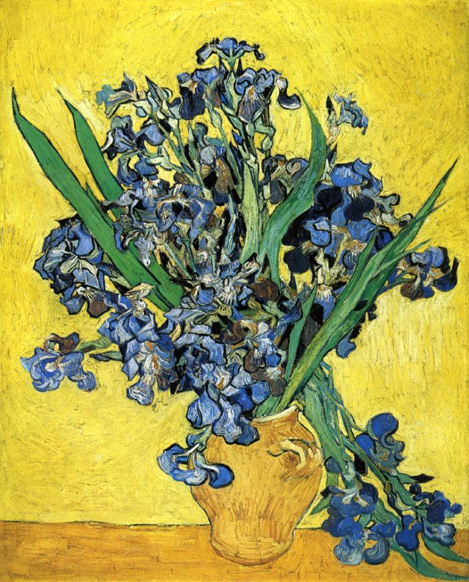
Sunflowers: 1887
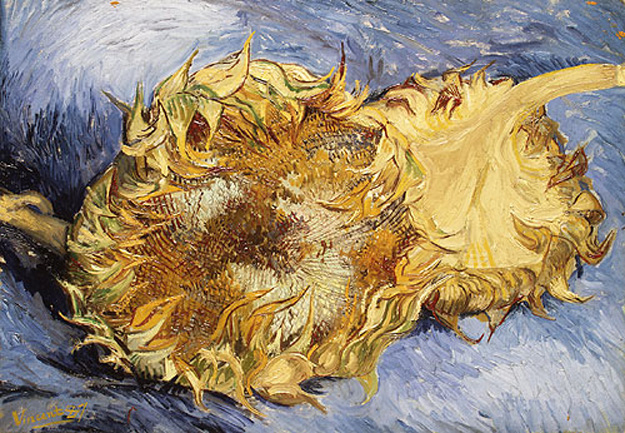
The_Zouave_1888
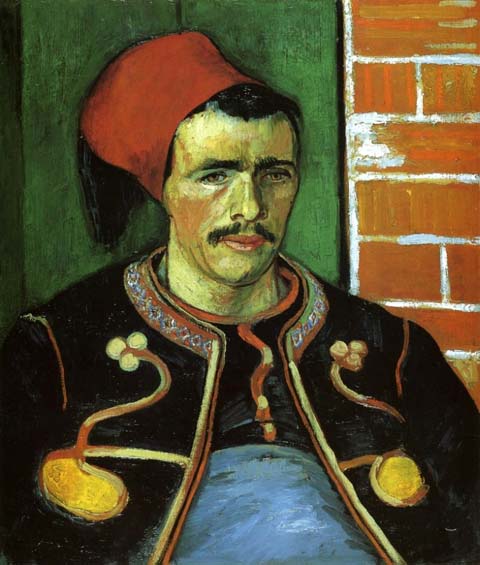
Three Pairs of Shoes: 1886
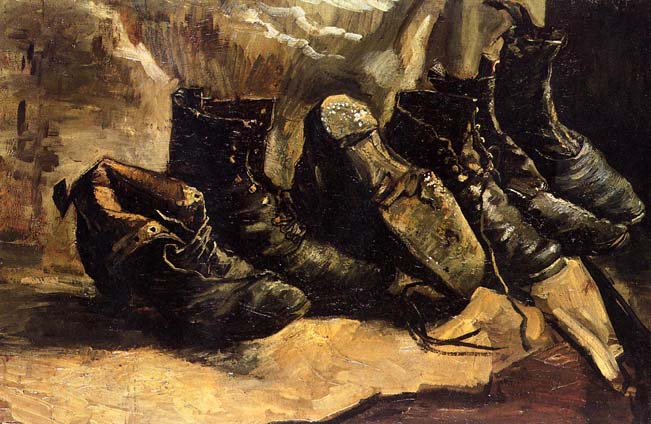
Vicarage at Nuenen: 1885

View from the Window of Vincent's Studio in Winter: 1883
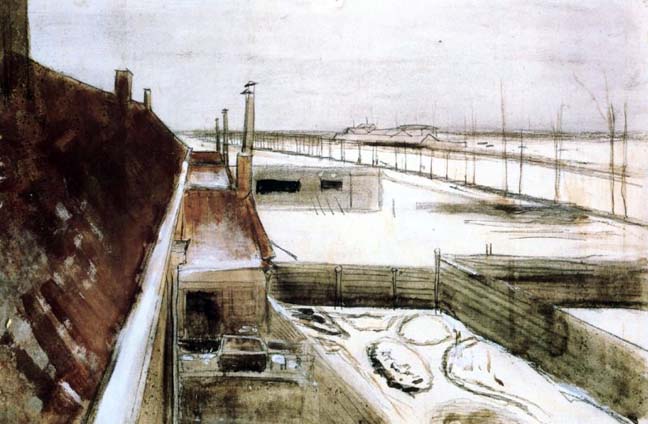
View of a River with Rowing Boats: 1887
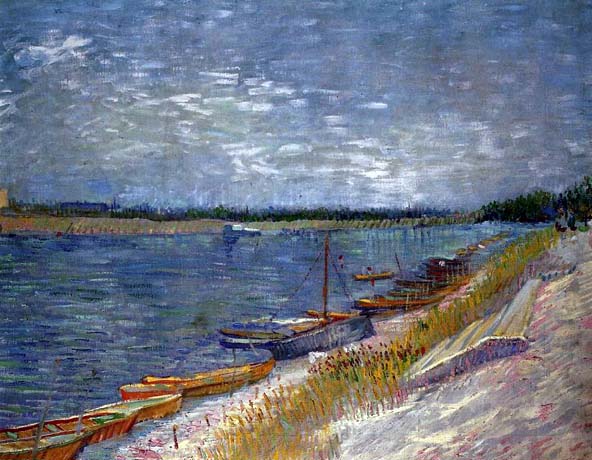
View of Arles with Irises: 1888
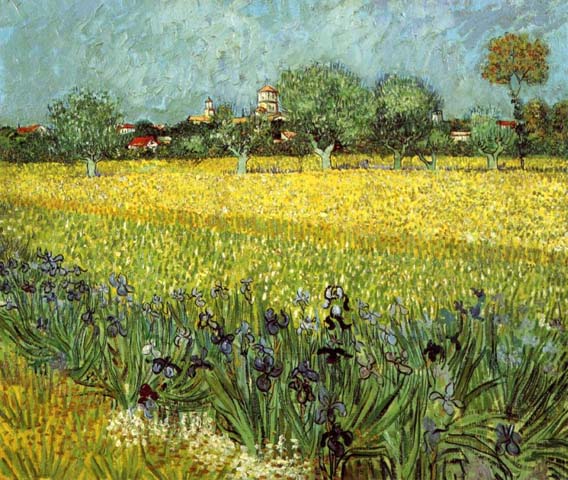
Notice the heavy use of painting in View of Arles with Irises, which is common in many of Van Gogh`s paintings. Towards the back of the painting we can see some buildings in Arles. But most of the buildings are obscured by trees. Vincent did a number of paintings and around during his life.
Quoted From: View of Arles with Irises
Woman Miners Carrying Coal: 1882
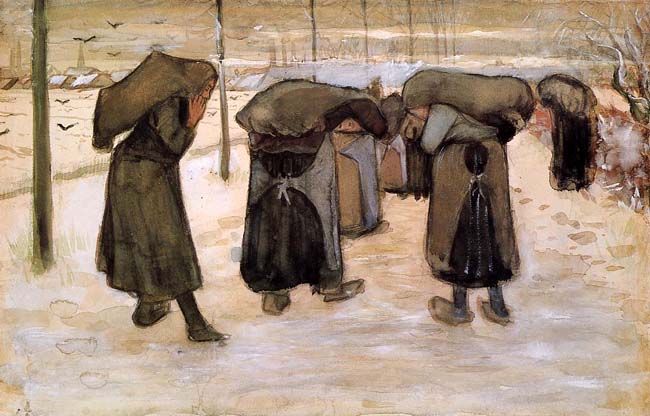
"I worked again on a watercolor of miners' wives carrying bags of coal through the snow. But especially I drew about twelve studies of figures for it and three heads, and I am not ready yet. In the watercolor I think I found the proper effect, but I do not think it broad enough of character." - Vincent van Gogh to Theo van Gogh, The Hague - Nov 2 or Nov 3, 1882
Quoted From: Van Gogh Artworks
Woman Sewing: 1881
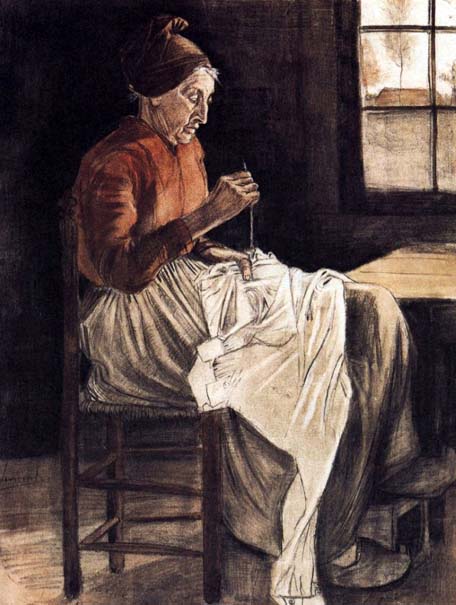
Worn Out: 1881
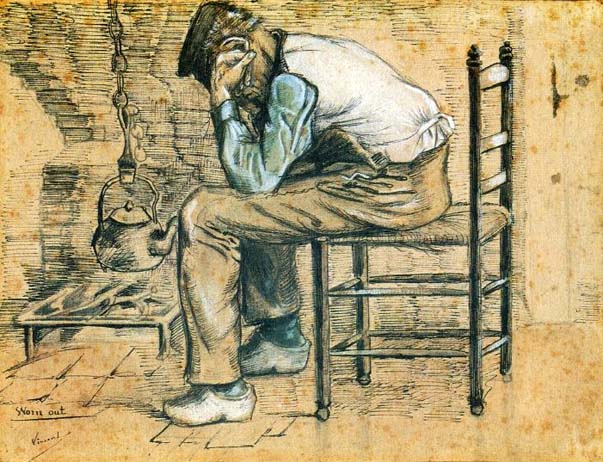
Wood Auction: 1883
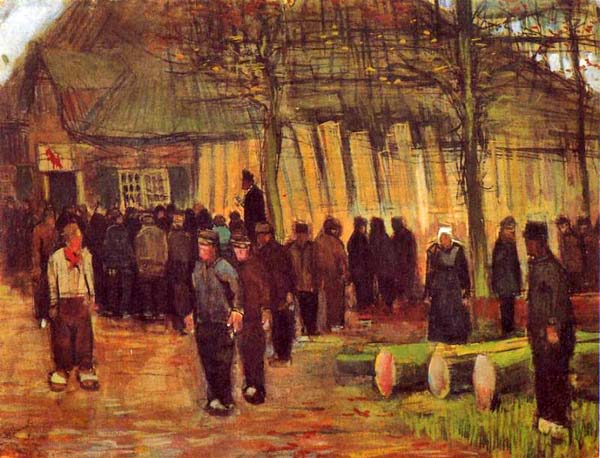
Woman Sitting by a Cradle: 1887
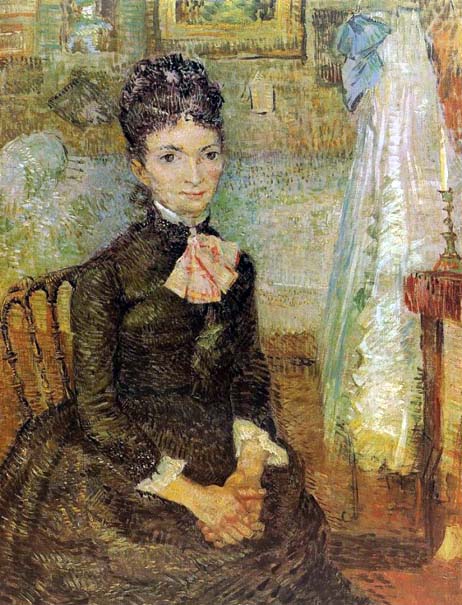
Additional Works of Vincent van Gogh
Bastille Day: 1886
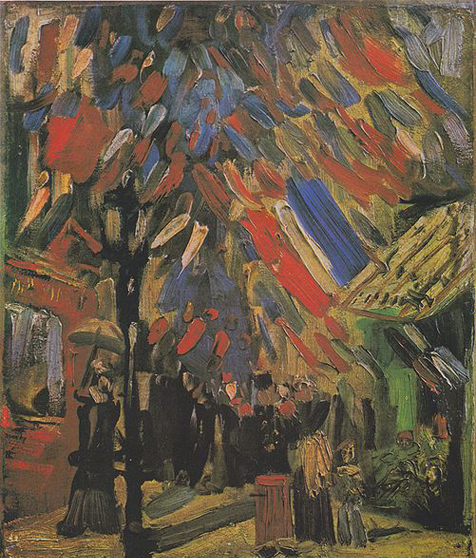
Bleaching Ground: 1882
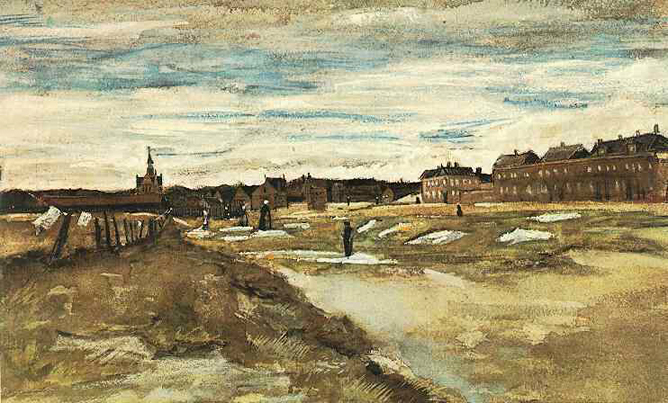
Church Pew with Worshippers: 1882
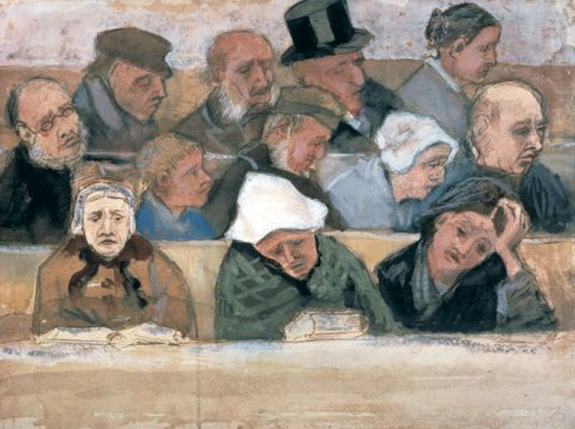
Fisherman's Wife on the Beach: 1882
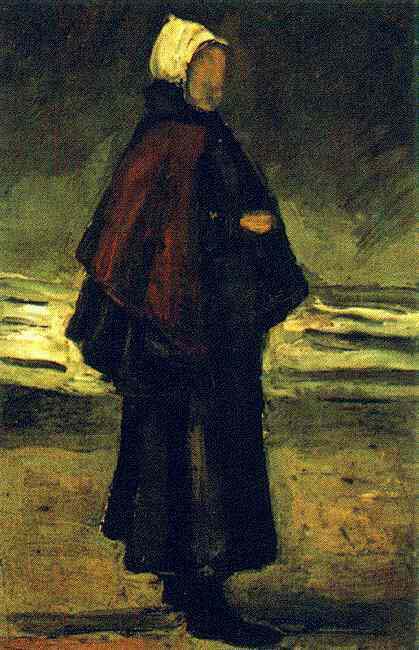
Head of a Peasant Woman: 188
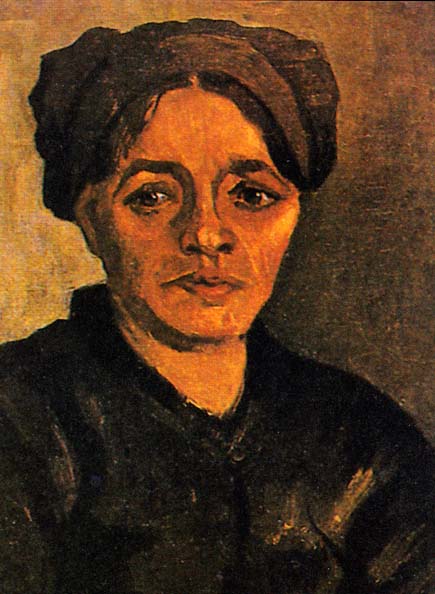
Head of a Peasant Woman with a White Cap: 1885
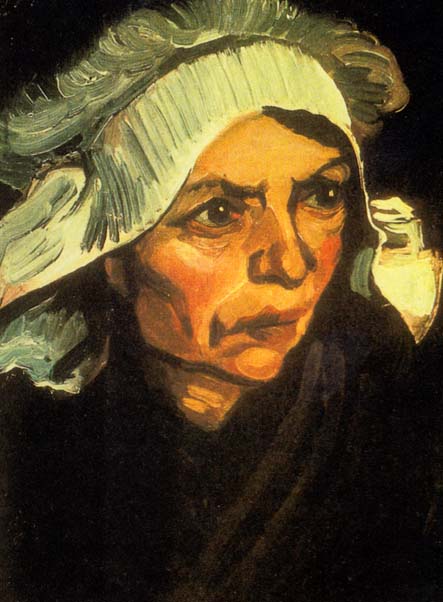
Head of a Peasant Woman with White Cap: 1885/center>
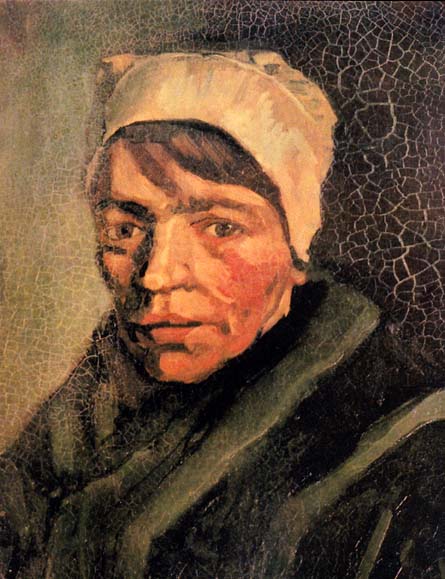
Head of a Woman: 1884
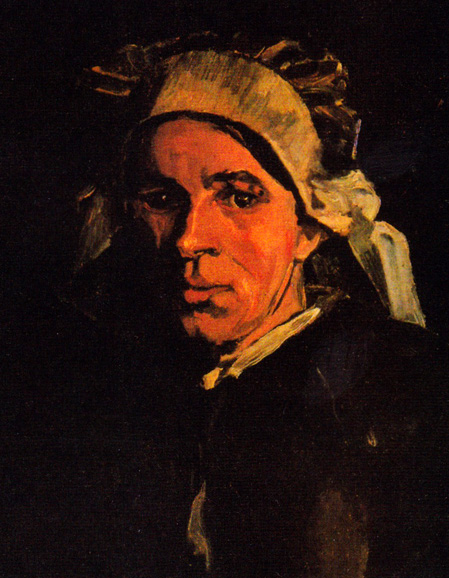
Lane of Poplars: 1885
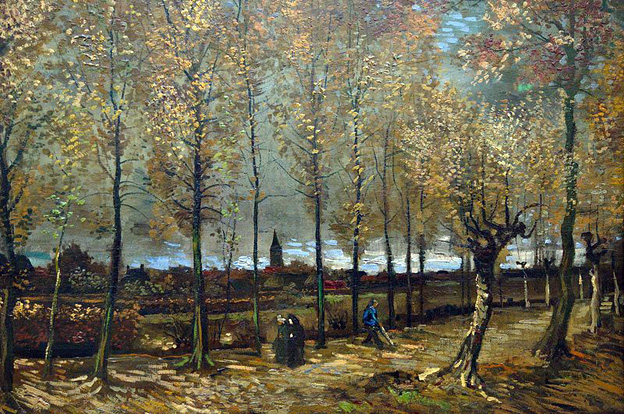
Montmartre, the Quarry, and Windmills: 1886

Path in the Wood: 1887

Rooftops View from the Atelier, The_Hague: 1882

Woman Sewing: 188
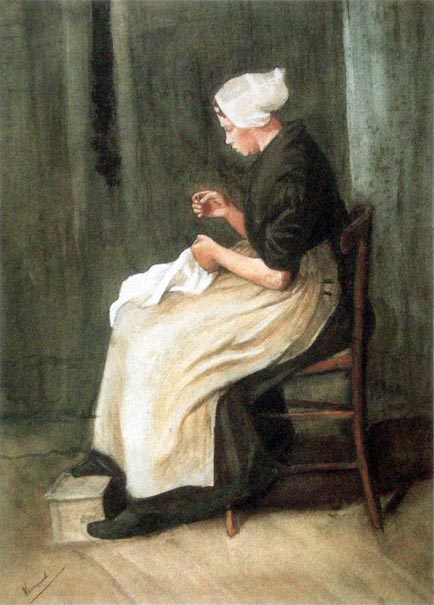
Shelter at Montmartre: 1886
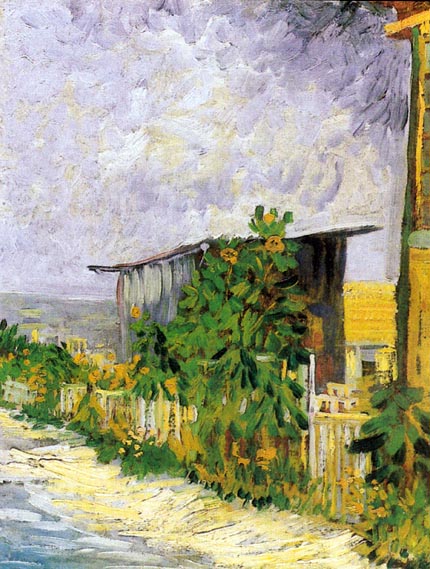
Sloping Path in Montmartre: 1886

Still Life with Bible: 1885

Terrace and Observation Deck at the-Moulin de Blute-Fin, Montmartre: 1886
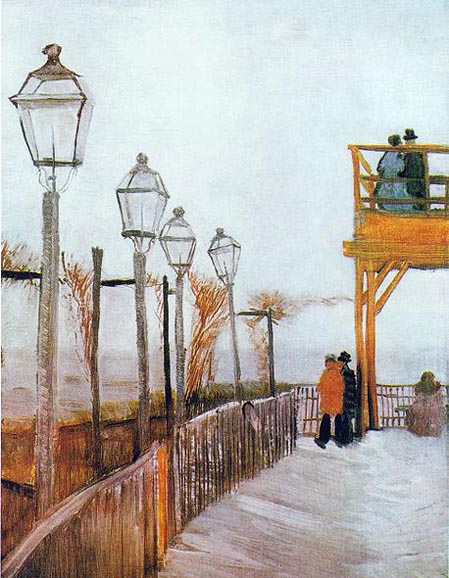
Trees and Underwood: 1887
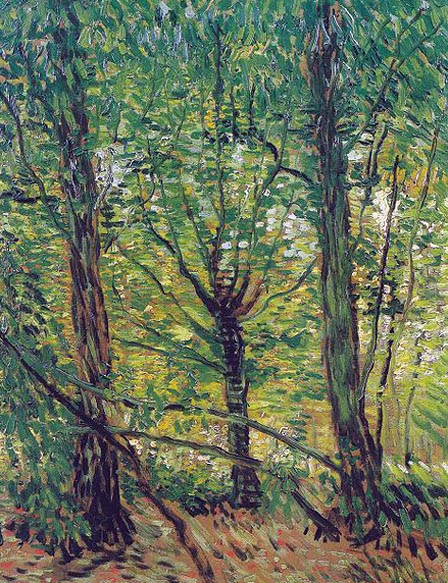
Walker in Bois de Boulogne: 1886

Water Mill at Gennep: 1884
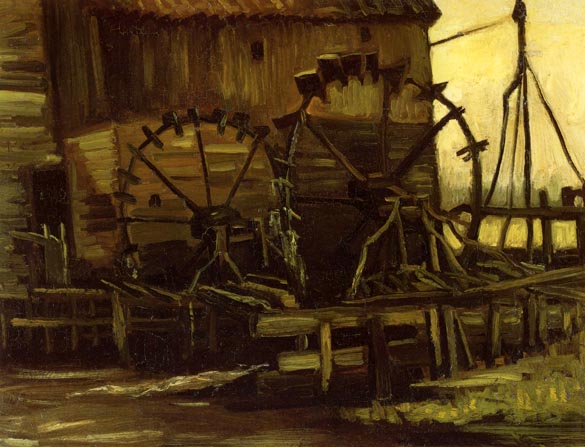
Weaver at the loom, with reel: 1884
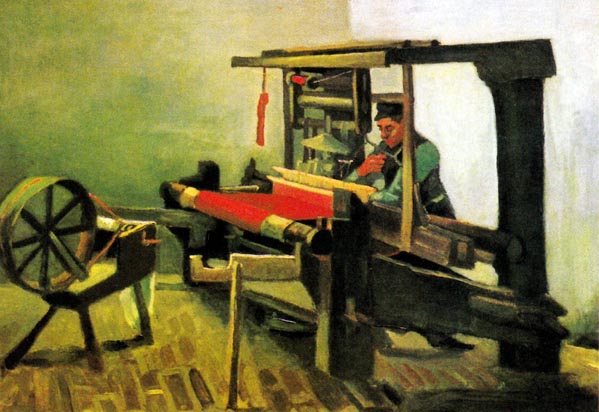
Weaver at the loom: 1884
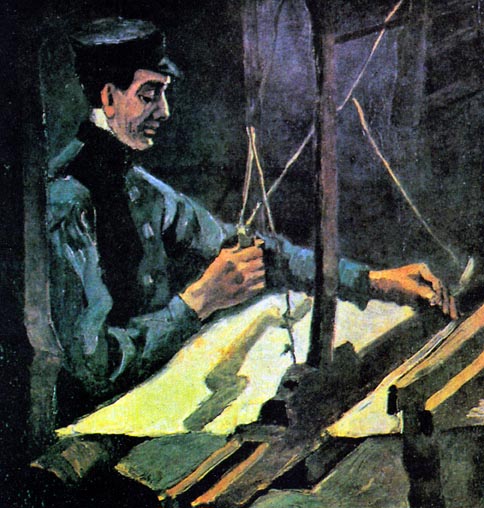
Weber in front of an open window with a view of the Tower of Nuenen: 1884
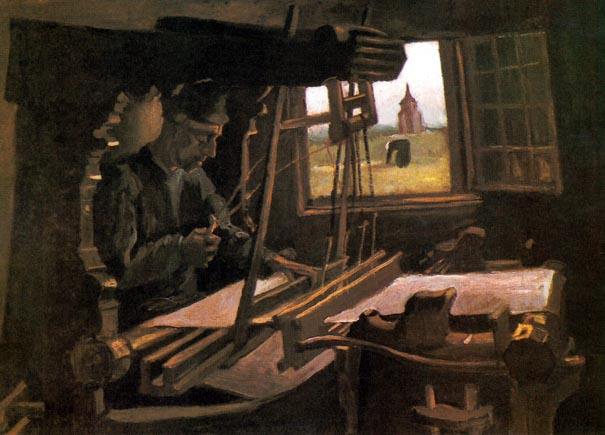
Woman Walking in a Garden: 1887
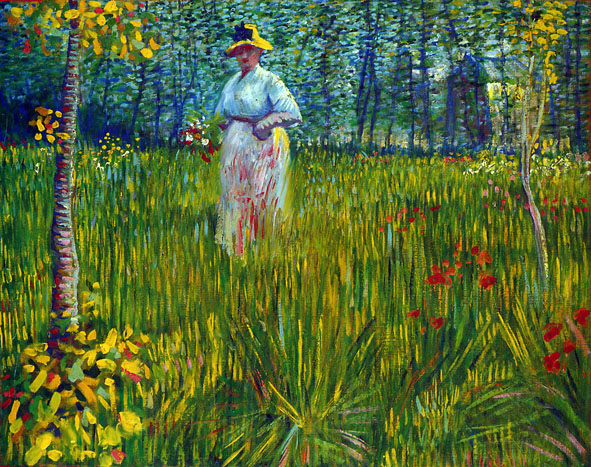
Woman with White Shawl in a Wood: 1882
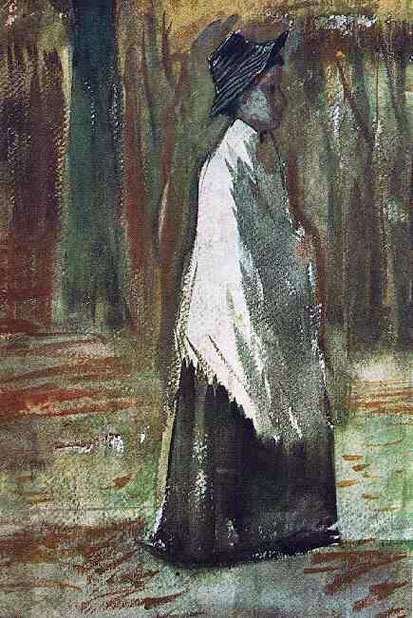
Additional Source Material
From: Museum Syndicate
From: Vincent Van Gough Online
This page is the work of Senex Magister
Return to Pagina Artis
Return to Bruce and Bobbie's Main Page.



.png)
.jpg)







































































































,_January_1889,_The_Metropolitan_Museum_of_Art,_New_York.jpg)
,_Museum_of_Fine_Arts,_Boston.jpg)



,_1888,_Private_Collection,_Zurich,_Switzerland.jpg)




































,_Museum_of_Fine_Arts,_Boston.jpg)



















































































































































.jpg)















































